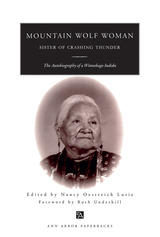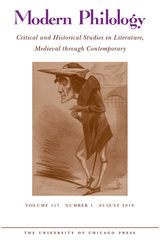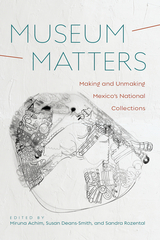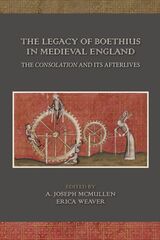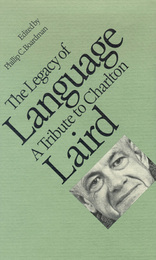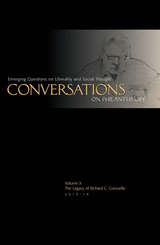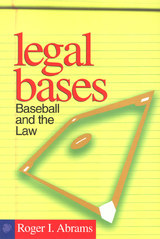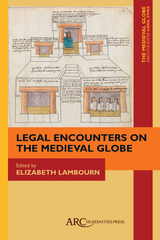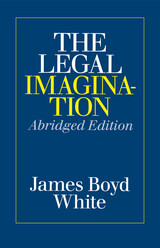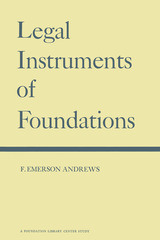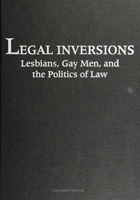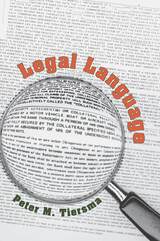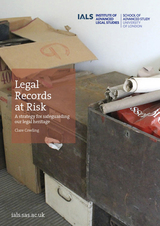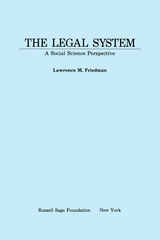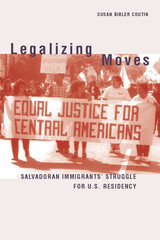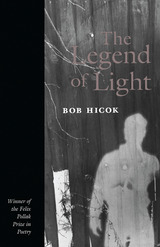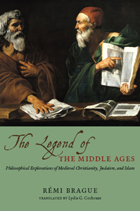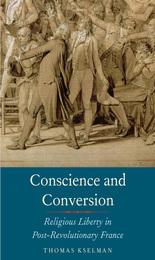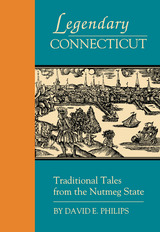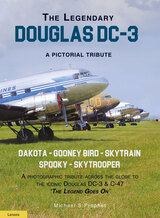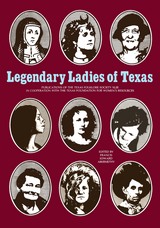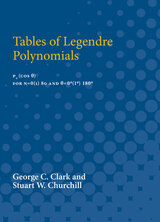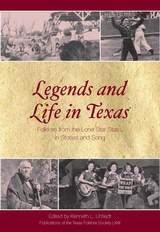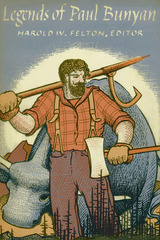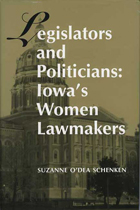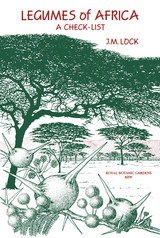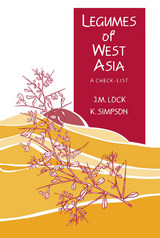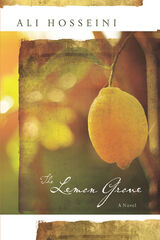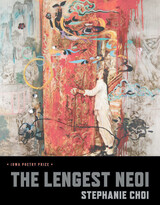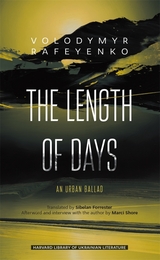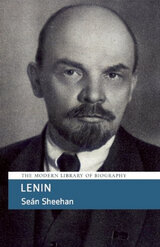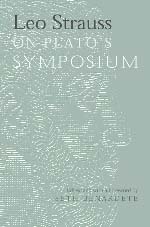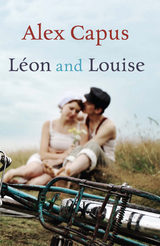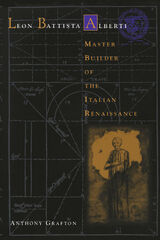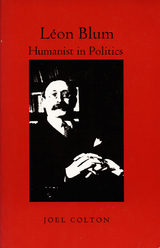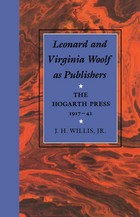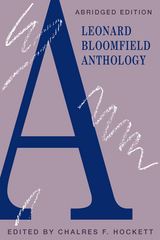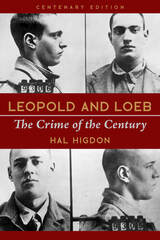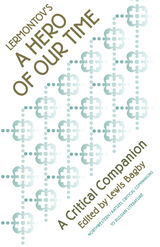The Legacy of Boethius in Medieval England: The Consolation and its Afterlives
A. Joseph McMullen
Arizona Center for Medieval and Renaissance Studies, 2018 The study of Boethius’s medieval reception has enjoyed a resurgence of interest in recent years, with the publication of new editions, translations, databases, and research reshaping our understanding of his profound influence. This study offers the first holistic survey of the reworkings of the Consolation in medieval England, surveying the Old English Boethius together with Chaucer’s Boece and a host of understudied interlocutors for the first time in a volume of this kind. Arranged into sections on “earlier” and “later” periods, The Legacy of Boethius argues for a reassessment of the medieval English Boethian tradition as a 600-year continuum in vernacular reading and readership.
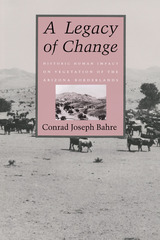 A Legacy of Change: Historic Human Impact on Vegetation in the Arizona Borderlands
Conrad Joseph Bahre
University of Arizona Press, 1991 The arrival of Anglo settlers in the 1870s marked the beginning of major vegetation changes in southeastern Arizona, including an increase in woody plants in rangelands, the degradation of riparian wetlands, and the spread of non-native plants. While many of these changes have already been linked to human land-use through comparative photographs and historic descriptions, it has long been presumed that changes in the region's climate have also contributed to vegetation change.
Geographer Conrad Bahre now challenges the view that these vegetation changes are due to climatic change. Correlating his own field research with archival records and photographs, Bahre demonstrates that most of the changes follow some type of human disturbance, such as cattle grazing, fuelwood cutting, wildfire suppression, agriculture, and road construction. Indeed, all available evidence suggests that Anglo settlement brought unprecedented changes to the land.
Vegetation change in the American West has long been an issue of concern. This careful scrutiny of one corner of that region—one of the most ecologically diverse areas of the United States—shows how poorly understood is the relationship between human activities and vegetation. More important, it introduces new techniques for differentiating between natural and anthropogenic factors effecting vegetation change that can be used to help ecologists understand vegetation dynamics worldwide.
 The Legacy of Christopher Columbus in the Americas: New Nations and a Transatlantic Discourse of Empire
Elise Bartosik-Velez
Vanderbilt University Press, 2014 Why is the capital of the United States named in part after Christopher Columbus, a Genoese explorer commissioned by Spain who never set foot on what would become the nation's mainland? Why did Spanish American nationalists in 1819 name a new independent republic "Colombia," after Columbus, the first representative of empire from which they recently broke free? These are only two of the introductory questions explored in The Legacy of Christopher Columbus in the Americas, a fundamental recasting of Columbus as an eminently powerful tool in imperial constructs.
Bartosik-Velez seeks to explain the meaning of Christopher Columbus throughout the so-called New World, first in the British American colonies and the United States, as well as in Spanish America, during the eighteenth and nineteenth centuries. She argues that, during the pre- and post-revolutionary periods, New World societies commonly imagined themselves as legitimate and powerful independent political entities by comparing themselves to the classical empires of Greece and Rome. Columbus, who had been construed as a figure of empire for centuries, fit perfectly into that framework. By adopting him as a national symbol, New World nationalists appeal to Old World notions of empire.
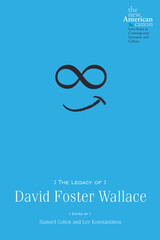 The Legacy of David Foster Wallace
Samuel Cohen and Lee Konstantinou
University of Iowa Press, 2012 Considered by many to be the greatest writer of his generation, David Foster Wallace was at the height of his creative powers when he committed suicide in 2008. In a sweeping portrait of Wallace’s writing and thought and as a measure of his importance in literary history, The Legacy of David Foster Wallace gathers cutting-edge, field-defining scholarship by critics alongside remembrances by many of his writer friends, who include some of the world’s most influential authors. In this elegant volume, literary critics scrutinize the existing Wallace scholarship and at the same time pioneer new ways of understanding Wallace’s fiction and journalism. In critical essays exploring a variety of topics—including Wallace’s relationship to American literary history, his place in literary journalism, his complicated relationship to his postmodernist predecessors, the formal difficulties of his 1996 magnum opus Infinite Jest, his environmental imagination, and the “social life” of his fiction and nonfiction—contributors plumb sources as diverse as Amazon.com reader recommendations, professional book reviews, the 2009 Infinite Summer project, and the David Foster Wallace archive at the University of Texas’s Harry Ransom Center. The creative writers—including Don DeLillo, Jonathan Franzen, George Saunders, Rick Moody, Dave Eggers, and David Lipsky, and Wallace’s Little, Brown editor, Michael Pietsch—reflect on the person behind the volumes of fiction and nonfiction created during the author’s too-short life. All of the essays, critical and creative alike, are written in an accessible style that does not presume any background in Wallace criticism. Whether the reader is an expert in all things David Foster Wallace, a casual fan of his fiction and nonfiction, or completely new to Wallace, The Legacy of David Foster Wallace will reveal the power and innovation that defined his contribution to literary life and to self-understanding. This illuminating volume is destined to shape our understanding of Wallace, his writing, and his place in history.
 The Legacy of Division: East and West after 1989
Ferenc Laczó
Central European University Press, 2020 This volume examines the legacy of the East–West divide since the implosion of the communist regimes in Europe. The ideals of 1989 have largely been frustrated by the crises and turmoil of the past decade. The liberal consensus was first challenged as early as the mid-2000s. In Eastern Europe, grievances were directed against the prevailing narratives of transition and ever sharper ethnic-racial antipathies surfaced in opposition to a supposedly postnational and multicultural West. In Western Europe, voices regretting the European Union's supposedly careless and premature expansion eastward began to appear on both sides of the left–right and liberal–conservative divides. The possibility of convergence between Europe's two halves has been reconceived as a threat to the European project. In a series of original essays and conversations, thirty-three contributors from the fields of European and global history, politics and culture address questions fundamental to our understanding of Europe today: How have perceptions and misperceptions between the two halves of the continent changed over the last three decades? Can one speak of a new East–West split? If so, what characterizes it and why has it reemerged? The contributions demonstrate a great variety of approaches, perspectives, emphases, and arguments in addressing the daunting dilemma of Europe's assumed East–West divide.
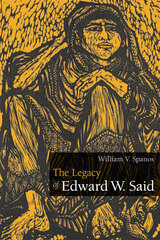 The Legacy of Edward W. Said
William V. Spanos
University of Illinois Press, 2008 With the untimely death of Edward W. Said in 2003, various academic and public intellectuals worldwide have begun to reassess the writings of this powerful oppositional intellectual. Figures on the neoconservative right have already begun to discredit Said’s work as that of a subversive intent on slandering America’s benign global image and undermining its global authority. On the left, a significant number of oppositional intellectuals are eager to counter this neoconservative vilification, proffering a Said who, in marked opposition to the “anti-humanism” of the great poststructuralist thinkers who were his contemporaries--Jacques Derrida, Jean-Francois Lyotard, Jacques Lacan, Louis Althusser, and Michel Foucault--reaffirms humanism and thus rejects poststructuralist theory. In this provocative assessment of Edward Said’s lifework, William V. Spanos argues that Said’s lifelong anti-imperialist project is actually a fulfillment of the revolutionary possibilities of poststructuralist theory. Spanos examines Said, his legacy, and the various texts he wrote--including Orientalism,Culture and Imperialism, and Humanism and Democratic Criticism--that are now being considered for their lasting political impact.
 The Legacy of Erich Fromm
Daniel Burston
Harvard University Press, 1991 This is the first full-scale intellectual biography in English of Erich Fromm, perhaps the most widely read psychoanalyst after Freud, whose contributions to clinical and social psychology and the history of the psychoanalytic movement have long been underrated. Though considered a pedant, a popularizer--Escape from Freedom, The Sane Society, and The Art of Loving, among others, were best-sellers -and an "outsider" in many psychoanalytic circles, Fromm played a historic role in the development of the discipline. As a member of Freud's "loyal opposition" with strong leanings toward the "dissident fringe;' he helped effect the transfer of productive ideas from the periphery to the mainstream of the psychoanalytic movement. Daniel Burston's meticulous elucidation of these ideas unravels the numerous strands--philosophical, literary, and social--that formed a part of Freud's own work and of Fromm's sympathetic, but not uncritical, reaction to Freudian orthodoxy. Despite his grounding in the tradition of Freud, contemporaries and former associates persistently misunderstood Fromm's work.
Insofar as he attempted to decipher the ideological subtexts to Freudian theory, analytically oriented theorists doing clinical or social research avoided his ideas. His Marxist leanings and his radically historical approach to human behavior made it all but impossible for mainstream academic psychologists to grasp his meaning, much less to grant it any validity. At the same time, his humanistic and ethical concerns struck many psychologists as grossly unscientific.
Practical and intellectual constraints have conspired to ensure that Fromm's impact has been peripheral at best. Burston's eloquent, evenhanded reassessment of Fromm's life and work cuts through the ideological and political underbrush to reveal his pivotal role as a theorist and a critic of modern psychoanalysis. It leads readers back to Freud, whose theoretical and clinical contributions Fromm refracted and extended, and on to controversies that remain a vital part of contemporary intellectual life.
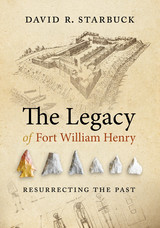 The Legacy of Fort William Henry: Resurrecting the Past
David R. Starbuck
University Press of New England, 2014 Fort William Henry, America’s early frontier fort at the southern end of Lake George, New York, was a flashpoint for conflict between the British and French empires in America. The fort is perhaps best known as the site of a massacre of British soldiers by Native Americans allied with the French that took place in 1757. Over the past decade, new and exciting archeological findings, in tandem with modern forensic methods, have changed our view of life at the fort prior to the massacre, by providing physical evidence of the role that Native Americans played on both sides of the conflict. Intertwining recent revelations with those of the past, Starbuck creates a lively narrative beginning with the earliest Native American settlement on Lake George. He pays special attention to the fort itself: its reconstruction in the 1950s, the major discoveries of the 1990s, and the archeological disclosures of the past few years. He further discusses the importance of forensic anthropology in uncovering the secrets of the past, reviews key artifacts discovered at the fort, and considers the relevance of Fort William Henry and its history in the twenty-first century. Three appendixes treat exhibits since the 1950s; foodways; and General Daniel Webb’s surrender letter of August 17, 1757.
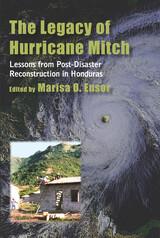 The Legacy of Hurricane Mitch: Lessons from Post-Disaster Reconstruction in Honduras
Marisa O. Ensor
University of Arizona Press, 2009 Around the world disaster vulnerability is on the rise. The incidence and intensity of disasters have increased in recent decades with lives being shattered and resources being destroyed across broad geographic regions each year.
As it swept across the Honduran landscape, the exceptional size, power and duration of Hurricane Mitch abruptly and brutally altered the already diminished economic, social, and environmental conditions of the population. In the aftermath of the disaster a group of seven socio-environmental scientists set out to investigate the root causes of the heightened vulnerability that characterized pre-Mitch Honduras, the impact of the catastrophe on the local society, and the subsequent recovery efforts. Edited by Marisa O. Ensor, this volume presents the findings of their investigation.
The Legacy of Hurricane Mitch offers a comprehensive analysis of the immediate and long-term consequences of Hurricane Mitch in Honduras. Based on longitudinal ethnographic fieldwork and environmental assessments, this volume illustrates the importance of adopting an approach to disaster research and practice that places “natural” trigger events within their political, cultural, and socio-economic contexts. The contributors make a compelling case against post-disaster recovery efforts that limit themselves to alleviating the symptoms, rather than confronting the root causes of the vulnerability that prefigured the disaster.
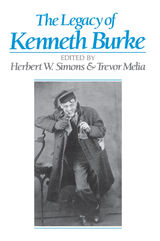 The Legacy of Kenneth Burke
Herbert W. Simons
University of Wisconsin Press, 1989 Capturing the lively modernist milieu of Kenneth Burke’s early career in Greenwich Village, where Burke arrived in 1915 fresh from high school in Pittsburgh, this book discovers him as an intellectual apprentice conversing with “the moderns.” Burke found himself in the midst of an avant-garde peopled by Malcolm Cowley, Marianne Moore, Jean Toomer, Katherine Anne Porter, William Carlos Williams, Allen Tate, Hart Crane, Alfred Stieglitz, and a host of other fascinating figures.
Burke himself, who died in 1993 at the age of 96, has been hailed as America’s most brilliant and suggestive critic and the most significant theorist of rhetoric since Cicero. Many schools of thought have claimed him as their own, but Burke has defied classification and indeed has often been considered a solitary, eccentric genius immune to intellectual fashions. But Burke’s formative work of the 1920s, when he first defined himself and his work in the context of the modernist conversation, has gone relatively unexamined.
Here we see Burke living and working with the crowd of poets, painters, and dramatists affiliated with Others magazine, Stieglitz’s “291” gallery, and Eugene O’Neill’s Provincetown Players; the leftists associated with the magazines The Masses and Seven Arts; the Dadaists; and the modernist writers working on literary journals like The Dial, where Burke in his capacity as an associate editor saw T. S. Eliot’s “The Wasteland” into print for the first time and provided other editorial services for Thomas Mann, e.e. cummings, Ezra Pound, and many other writers of note. Burke also met the iconoclasts of the older generation represented by Theodore Dreiser and H. L. Mencken, the New Humanists, and the literary nationalists who founded Contact and The New Republic. Jack Selzer shows how Burke’s own early poems, fiction, and essays emerged from and contributed to the modernist conversation in Greenwich Village. He draws on a wonderfully rich array of letters between Burke and his modernist friends and on the memoirs of his associates to create a vibrant portrait of the young Burke’s transformation from aesthete to social critic.
The Legacy Of Language: A Tribute To Charlton Laird
Phillip C. Boardman
University of Nevada Press, 1987 In this tribute to Charlton Laird, ten scholars in the fields of language and linguistics provide ordinary readers with new insight into the workings of the English language. Laird, one of Nevada's treasured authors, was a professor of English at the University of Nevada, Reno.
 The Legacy of Martin Luther King, Jr.: The Boundaries of Law, Politics, and Religion
Lewis V. Baldwin
University of Notre Dame Press, 2002 The Legacy of Martin Luther King, Jr. explores the development of Dr. King’s understanding of the relationship among religion, morality, law, and politics. This fascinating work is part of a broader effort by scholars in various fields to examine unexplored areas in the life, thought, and activism of Martin Luther King, Jr., and it represents the first book-length treatment of how King united moral-religious convictions and political activity. This timely study is also the first in-depth analysis of King’s views on the roles that religion and morality ought to play, not only in public debate concerning political choices and law, but also in efforts to create political and legal structures that are just.
Beginning with the social, political, and economic implications of King’s vision of the “New South” and his prophetic critique of southern civil religion, this pathbreaking study casts King in the role of “political liberal,” “consummate politician,” and “political theologian.” The Legacy of Martin Luther King, Jr., focuses considerable attention on King’s refusal to separate religious faith and moral considerations from politics, legal matters, and social reformism. In so doing, it demonstrates King’s remarkable ability to transcend church-state boundaries and to formulate an alliance that permeated every facet of American life. Featuring four chapters by Lewis V. Baldwin—a leading authority on King—as well as a chapter by Rufus Burrow, Jr., and one co-authored by Barbara Holmes and Susan Holmes Winfield, this volume reveals how King moved beyond southern particularism to create a more democratic America and a more inclusive world. Among the topics covered are King’s relationship to various American political traditions and figures, King’s theories of civil disobedience and his understanding of the Constitution, and the influence of moral law and personal idealism on King’s teachings.
“The essays in this collection are a most welcome correction to the widely disseminated view of King as simply another integration-oriented civil rights leader. His legacy is accurately portrayed here as transcending the boundaries of law, politics, and religion, to embody in the twentieth century the spiritual essence of Jesus' teachings.” —Derrick Bell, author of Faces at the Bottom of the Well: The Permanence of Racism
“Lewis Baldwin has come closest to defining the mystique of Martin Luther King, Jr. He has succeeded where so many other writers have failed because they only digest some facet of the King phenomenon. Baldwin unveils the globalist aspect of Dr. King’s life and mission for all the world to see. This is a must-read book.” —Wyatt Tee Walker, former Chief of Staff to Dr. King and current Senior Pastor and CEO of the Canaan Baptist Church of Christ in New York’s Harlem Community
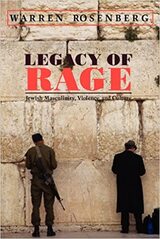 Legacy of Rage: Jewish Masculinity, Violence, and Culture
Warren Rosenberg
University of Massachusetts Press, 2009 In books, television programs, and films, Jewish men are often depicted as erudite, comedic, malleable, and non-threatening—somewhere between Clark Kent and the early Woody Allen. Yet as Warren Rosenberg shows in this illuminating study, this widespread cultural image is not only overly simplistic, it is at odds with a legacy of Jewish male violence that goes back to the first chapters of Genesis when Cain slew Abel.
From Biblical depictions of heroic warriors like King David to the medieval Jewish legend of the Golem (a fierce man of clay created by Cabalistic magic) to the fictional Alexander Portnoy, Jewish ideas of manhood reflect a simultaneous resistance and attraction to violence. According to Rosenberg, it is an ambivalence shaped by millennia of oppression as well as by the clash of Western ideas of masculinity with Eastern European rabbinical injunctions against violent action. The result has been not only gender confusion, but a suppressed rage evident in a broad range of texts created by Jewish men, from nineteenth-century Yiddish stories to contemporary Hollywood films. Isaac Babel, Henry Roth, Norman Mailer, Saul Bellow, Philip Roth, David Mamet, Barry Levinson, and Steven Spielberg are just some of the writers and filmmakers whose lives and works are marked by this legacy of rage.
Yet if the need to affirm masculinity through violence remains an unacknowledged aspect of Jewish male identity, Rosenberg argues, it is not a historical inevitability. As the work of Cynthia Ozick and Tony Kushner suggests, it is possible to construct new ideas of Jewish manhood by exposing the hidden fallacies of the old.
 The Legacy of Ron Gonnella: Scottish Fiddler, 1930–1994
Jane MacMorran
University of Tennessee Press, 2025 In the latter half of the twentieth century, Ron Gonnella’s extensive discography played a pivotal role in reviving interest in traditional Scottish fiddling, particularly in the United States. Jane MacMorran’s The Legacy of Ron Gonnella offers an in-depth exploration of this legendary fiddler whose influence has largely been overlooked in mainstream music history. MacMorran situates the musician’s work within the cultural shifts of the 1960s, ’70s, and ’80s—decades that witnessed multiple folk music revivals as Gonnella’s career developed in a niche tradition. This book reintroduces Gonnella as a significant figure whose contributions to Scottish fiddling helped shape performance standards and influence future generations of musicians.
Beginning in Barga, Italy, and traveling through Scotland before arriving in North America, Gonnella’s life and work reflect a complex dialogue between cultures, historical periods, and musical traditions. MacMorran examines how Gonnella’s work was shaped by and helped shape various musical communities, showing that he was an active participant in the ongoing evolution of Scottish fiddling.
Through oral histories, archival material, and interviews with musicians who performed with or were influenced by Gonnella, the author uncovers a vibrant narrative of cross-cultural exchange. The result is a rich portrayal of Gonnella’s life-long contribution to Scottish fiddling and a case for his inclusion in the wider narrative of traditional music history.
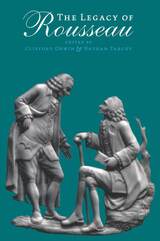 The Legacy of Rousseau
Edited by Clifford Orwin and Nathan Tarcov
University of Chicago Press, 1996 Few thinkers have enjoyed so pervasive an influence as Rousseau, who originated dissatisfaction with modernity. By exploring polarities articulated by Rousseau—nature versus society, self versus other, community versus individual, and compassion versus competitiveness—these fourteen original essays show how his thought continues to shape our ways of talking, feeling, thinking, and complaining.
The volume begins by taking up a central theme noted by the late Allan Bloom—Rousseau's critique of the bourgeois as the dominant modern human type and as a being fundamentally in contradiction, caught between the sentiments of nature and the demands of society. It then turns to Rousseau's crucial polarity of nature and society and to the later conceptions of history and culture it gave rise to. The third part surveys Rousseau's legacy in both domestic and international politics. Finally, the book examines Rousseau's contributions to the virtues that have become central to the current sensibility: community, sincerity, and compassion.
Contributors include Allan Bloom, François Furet, Pierre Hassner, Christopher Kelly, Roger Masters, and Arthur Melzer.
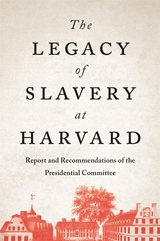 The Legacy of Slavery at Harvard: Report and Recommendations of the Presidential Committee
The Presidential Committee on the Legacy of Slavery
Harvard University Press, 2022 Harvard’s searing and sobering indictment of its own long-standing relationship with chattel slavery and anti-Black discrimination.
In recent years, scholars have documented extensive relationships between American higher education and slavery. The Legacy of Slavery at Harvard adds Harvard University to the long list of institutions, in the North and the South, entangled with slavery and its aftermath.
The report, written by leading researchers from across the university, reveals hard truths about Harvard’s deep ties to Black and Indigenous bondage, scientific racism, segregation, and other forms of oppression. Between the university’s founding in 1636 and 1783, when slavery officially ended in Massachusetts, Harvard leaders, faculty, and staff enslaved at least seventy people, some of whom worked on campus, where they cared for students, faculty, and university presidents. Harvard also benefited financially and reputationally from donations by slaveholders, slave traders, and others whose fortunes depended on human chattel. Later, Harvard professors and the graduates they trained were leaders in so-called race science and eugenics, which promoted disinvestment in Black lives through forced sterilization, residential segregation, and segregation and discrimination in education.
No institution of Harvard’s scale and longevity is a monolith. Harvard was also home to abolitionists and pioneering Black thinkers and activists such as W. E. B. Du Bois, Charles Hamilton Houston, and Eva Beatrice Dykes. In the late twentieth century, the university became a champion of racial diversity in education. Yet the past cannot help casting a long shadow on the present. Harvard’s motto, Veritas, inscribed on gates, doorways, and sculptures all over campus, is an exhortation to pursue truth. The Legacy of Slavery at Harvard advances that necessary quest.
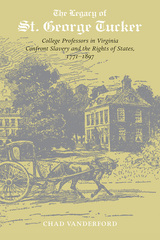 The Legacy of St. George Tucker: College Professors in Virginia Confront Slavery and Rights of States, 1771–1897
Chad Vanderford
University of Tennessee Press, 2015 “In The Legacy of St. George Tucker, Chad Vanderford provides a cogent longitudinal explication of how Virginia intellectuals constructed and defined proslavery ideology and state rights. He reminds twenty-first-century readers that in order to judge late-eighteenth-and early-nineteenth-century thinkers fairly, they must position basic political ideas within the context of their day, not ours. Vanderford’s book will prove valuable not only for students and researchers of political theory, but also of southern intellectual life and the political worlds of the Colonial, Early National, and Old South.”
–John David Smith, Charles H. Stone Distinguished Professor of American History, University of North Carolina at Charlotte
Historians born during and after the Civil Rights movement have struggled to take the proslavery and pro-secession arguments of the eighteenth- and nineteenth-century South seriously. They generally tend to lump the two theories together as components of one ideology and then attempt to write it out of the political norms of American life. In this groundbreaking study, Vanderford isolates the different ideological strands in southern political thought of this era and works to understand these ideas in the context of their time.
St. George Tucker (1752–1827), Founding Father, professor, and political theorist, saw clearly that slavery runs against the grain of the values articulated in the Declaration of Independence. Under certain narrowly construed circumstances, however, he thought it necessary to tolerate slavery. He viewed secession as an extreme step, but one that the Declaration of Independence left open as a possibility for all free states.
St. George Tucker’s arguments hinged on a modern view of natural right that builds on the premise that political power can only be legitimate if it rests on the consent of the governed. He believed that equally free and independent individuals constructed a voluntary union of equally free and independent states. His son Henry Tucker (1780–1848), and grandson, John Randolph Tucker (1823–1897) sought to defend this ideology of modern natural right against fellow professors, North and South, who tended to replace it with the ancient ideology of natural right: the view that wisdom gives one the title to command. Many southern intellectuals came to believe that individuals are not equally free and independent by nature; many northerners came to argue that the states had never been equally free and independent. These disagreements contributed to the outbreak of the Civil War.
At once a work of intellectual history that shows the key role played by professors in helping to formulate southern ideology, as well as a recovery of rarely explored arguments, this work wrestles with one of the greatest challenges of intellectual history: the effort to understand the most controversial ideas of the past on their own terms, while searching for the genealogy that connects the past to the present.
CHAD VANDERFORD is an associate professor of history at the University of Texas of the Permian Basin. His articles and reviews have appears in publications including Civil War History, the Journal of Southern History, and the Virginia Magazine of History and Biography.
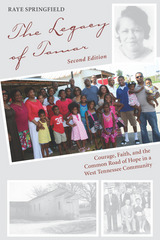 The Legacy of Tamar: Courage, Faith, and the Common Road of Hope in a West Tennessee Community
Raye Springfield
University of Tennessee Press, 2000
“The Legacy of Tamar centers on Brownsville, Haywood County, Tennessee, where Elbert Williams became the first NAACP official to be abducted and murdered my a white supremacist mob. This fascinating book is a good history of the people of Haywood County through a lens of five generations of an African American family. They endured one of those most oppressive white supremacist societies in the southern United States, but survived, advanced through higher education and training, and for generations achieved great things in their careers and lives despite the harmful effects of Jim Crow and continued racism in America.” —Bobby L. Lovett, author of The Civil Rights Movement in Tennessee: A Narrative History
In this second edition, Raye Springfield brings the story of the Taylor-Springfield family and the community of Brownsville, Haywood County, Tennessee, into the twenty-first century. In 2015, as the fifteenth anniversary of The Legacy of Tamar approached, another important but relatively unknown event was also reaching its seventy-fifth anniversary: the June 1940 lynching of Elbert “Dick” Williams, the first known NAACP official killed during civil rights activities. Williams was a longtime Brownsville resident and secretary of the local NAACP chapter and was killed while organizing a voter registration drive for Haywood County’s black residents. In her preface to the second edition, Springfield recounts the services for Williams (services that were not allowed to be held in 1940), how times in Brownsville, and the nation, have changed, and yet how African Americans continue the fight for racial equality.
The Legacy of Tamar spans two world wars, the Great Depression, the civil rights era, and now the changing of the millennium. For the Taylor-Springfield family, ultimately, the dreams of prior generations were realized in the youth of the present day. More than just the story of one family in rural Tennessee, The Legacy of Tamar reflects historic nationwide struggles by African Americans and offers hope for new generations.
The Author: Raye Springfield lives in Nashville, Tennessee. She was preciously assistant general counsel for the Tennessee Board of Regents and an assistant attorney general for the State of Tennessee.
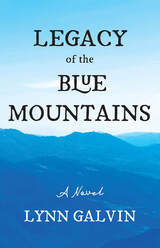 Legacy of the Blue Mountains: A Novel
Lynn Galvin
University of Nevada Press, 2025 During the last century, strange tales have drifted from the Sierra Madre Mountains; rumors of battles, murders, robberies, and kidnappings between Mexicans and a mysterious, wild people. Recovering from double amputations, US Marine Nick Diaz returns from Afghanistan seeking healing at his family’s border ranch in Cochise County, Arizona. He finds the ranch renamed and declared a new nation by one cousin; another cousin is missing; the family’s cattle herd has been sold off; and smugglers roam the hills. As Nick attempts to adjust to his own physical challenges and to changes on the ranch, he discovers a people who may need more help than he does.
In Legacy of the Blue Mountains, author Lynn Galvin asks: What might happen to a group of Apache children, born in present times, yet living as if in the past and marooned in the Sierra Madre mountains of Mexico when their last renegade adult dies? As they attempt to reach their nearest, last known family members, they embark on a journey to a place none of them has ever seen or visited before. Will they be able to remain undetected while following a memorized path laid out in previous centuries that will lead them into the modern world? As the last remaining Apache children confront the challenges of survival in unfamiliar lands, will they endure long enough to reunite with their remaining relatives?
 The Legacy of the Enlightenment: Ambivalences of Modernity
Antoine Lilti
University of Chicago Press, 2025 Going against the grain, this refreshing book argues for a non-ideological portrait of the Enlightenment as having been, above all else, a self-critical enterprise.
The Enlightenment has come under substantial attack over the past several years, with some going so far as to recommend leaving behind its thinkers and their Eurocentric prejudices. In response, the most orthodox defenders of the Enlightenment have insisted that its values are not just foundational but indispensable and that abandoning them would mean opening the door to nihilism and relativism. For Antoine Lilti, one of the leading scholars of the French Enlightenment, both sides are wrong.
In this tactfully argued series of essays, Lilti emphasizes a non-dogmatic, non-ideological view of the Enlightenment—one that sees its legacy as a critical, attentive approach that can and should serve as its own best critic. Along the way, he engages with everyone from Rousseau and Kant to Foucault and Habermas, as well as prominent contemporary voices, such as Jonathan Israel. The result is a remarkable new reading of the Enlightenment that redraws the stakes of old debates and offers an alternative way to engage with both canonical thinkers and later scholarship that is both honest about the past and useful for the future.
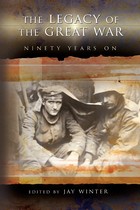 The Legacy of the Great War: Ninety Years On
Edited by Jay Winter
University of Missouri Press, 2009 In late 2007 and early 2008, world-renowned historians gathered in Kansas City for a series of public forums on World War I. Each of the five events focused on a particular topic and featured spirited dialogue between its prominent participants. In spontaneous exchanges, the eminent scholars probed each other’s arguments, learned from each other, and provided insights not just into history but also into the way scholars think about their subject alongside and at times in conflict with their colleagues. Representing a fourth generation of writers on the Great War and a transnational rather than an international approach, prominent historians Niall Ferguson and Paul Kennedy, Holger Afflerbach and Gary Sheffield, John Horne and Len Smith, John Milton Cooper and Margaret MacMillan, and Jay Winter and Robert Wohl brought to the proceedings an exciting clash of ideas. The forums addressed topics about the Great War that have long fascinated both scholars and the educated public: the origins of the war and the question of who was responsible for the escalation of the July Crisis; the nature of generalship and military command, seen here from the perspectives of a German and a British scholar; the private soldiers’ experiences of combat, revealing their strategies of survival and negotiation; the peace-making process and the overwhelming pressures under which statesmen worked; and the long-term cultural consequences of the war—showing that the Great War was “great” not merely because of its magnitude but also because of its revolutionary effects. These topics continue to reverberate, and in addition to shedding new light on the subjects, these forums constitute a glimpse at how historical writing happens. American society did not suffer the consequences of the Great War that virtually all European countries knew—a lack of perspective that the National World War I Museum seeks to correct. This book celebrates that effort, helping readers feel the excitement and the moral seriousness of historical scholarship in this field and drawing more Americans into considering how their own history is part of this story.
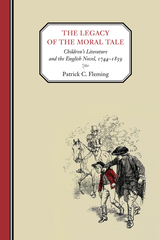 The Legacy of the Moral Tale: Children's Literature and the English Novel, 1744–1859
Patrick C. Fleming
University of Tennessee Press, 2016 "The Legacy of the Moral Tale made me understand in a way I never had before the form’s complexity and vitality—and, most of all, its centrality to any reading of nineteenth-century British literature. Fleming’s lucid and engaging prose makes reading it a pleasure. A vibrant voice, an original recovery, a dynamic rethinking of the tradition.”
—Laurie Langbauer, author of Novels of Everyday Life: The Series in English Fiction, 1850–1930
The moral tale was foremost among the new genres of children’s literature that emerged in Britain during the late eighteenth and early nineteenth centuries. Written expressly to impart moral lessons to their young readers, such tales had a profound impact on the generation we now know as the Victorians, including such esteemed novelists as Charles Dickens, William Thackeray, and George Eliot.
In this original and discerning study, Patrick Fleming traces the rise and subsequent impact of the moral tale through the works of representative authors like Thomas Day, whose Sandford and Merton was a perennial best-seller, and Maria Edgeworth, whose stories Queen Victoria herself was reading on the eve of her coronation. We then see how the popular “Newgate novels” of the 1830s, a genre portraying the lives of criminals, adapted the moral tale’s narrative conventions to guide readers’ reactions to the characters’ vices, and how Dickens, from Oliver Twist (1837) through such later writings as Hard Times (1854) and Great Expectations (1860), developed his own brand of experiential didacticism, which clearly had roots in the moral tales he read as a child. By 1859, Fleming shows, the impact of the moral tale began to decline amid growing skepticism over systematized education and as Darwinian theory complicated the link between experience and character.
Scholars studying Victorians’ childhood reading have typically emphasized fairy tales and eighteenth-century novels rather than works especially written for children, while children’s literature scholars have focused on the “Golden Age,” which began around 1860 and is epitomized by such works as Lewis Carroll’s Alice’s Adventures in Wonderland (1865). However, as The Legacy of the Moral Tale makes clear, children’s literature began long before the Golden Age,and the moral tale was prominent among the genres the Victorians remembered. In revealing this long-overlooked connection, the book expands our understanding of the history of the novel and highlights the moral instruction to which nineteenth-century readers were accustomed.
PATRICK C. FLEMING is an assistant professor of English at Fisk University in Nashville. His articles have appeared in Eighteenth-Century Studies, the Journal of Narrative Theory, and the Victorian Periodicals Review.
 Legacy on Ice: Blake Geoffrion and the Fastest Game on Earth
Sam Jefferies, Foreword by John Buccigross
University of Wisconsin Press, 2023 In 2010, Blake Geoffrion became the first player from the University of Wisconsin hockey team to receive the Hobey Baker Award, recognizing him as the best player in men’s college hockey. Blake was a rising scion of hockey royalty, descendant of legendary Canadian players Howie Morenz and Bernie “Boom Boom” Geoffrion, and he would soon be the first fourth-generation player to reach the NHL. His professional career promised to cement his family’s storied legacy on ice. But in 2012, while playing for the Montreal Canadiens’ minor league team beneath Morenz’s and Boom Boom’s retired numbers, Geoffrion suffered a devastating injury that ended his career—and nearly his life.
With sure-footed and swift-moving prose, Sam Jefferies tells Geoffrion’s story against the backdrop of modern North American hockey. Thorough research and scores of interviews fuel this tale of soaring success and terrible tragedy, offering insight not only into one man’s athletic journey but also into the rise of American hockey on the national and international stage. Geoffrion’s brief career, marked by tribulation and triumph, illustrates the subtle but omnipresent currents of American media, sports labor, and the interplay between college and professional athletics. It tells the story of what was, what is, and what may yet be for the fastest game on earth.
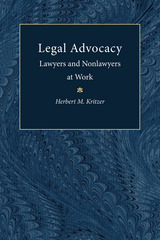 Legal Advocacy: Lawyers and Nonlawyers at Work
Herbert M. Kritzer
University of Michigan Press, 1998 Because of concern over the cost and quality of legal representation in this country many have argued that formally trained lawyers are not the best advocates in many situations. However, the professional bar has fought to maintain its monopoly on the provision of legal services. Can nonlawyers be effective legal advocates? Herbert Kritzer provides the first systematic comparative study of the work of lawyers and nonlawyers that evaluates the quality of representation provided by lawyers and nonlawyers. The book describes lawyers and nonlawyer advocates at work in four different legal settings: unemployment compensation claims appeals, Social Security disability appeals, state tax appeals, and labor grievance arbitrations.
The analysis shows clearly that nonlawyers can be effective advocates and, in some situations, more effective than many lawyers. Kritzer combines an examination of case outcomes with a systematic observation of advocates in the hearing room, providing a compelling portrait of their work and a solid basis for understanding the differences in the effectiveness of advocates with different training. The author's findings have important implications for our policies toward restrictions on those who can provide legal assistance, specialization in training and practice, and the meaning of professional monopolies in a world of increasing complexity.
This book will appeal to student of the legal process, the sociology of professions, and all concerned with the operation of the U.S. legal system.
Herbert M. Kritzer is Professor of Political Science and Law, University of Wisconsin--Madison. He is the author of Let's Make a Deal and The Justice Broker.
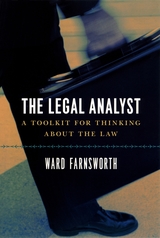 The Legal Analyst: A Toolkit for Thinking about the Law
Ward Farnsworth
University of Chicago Press, 2007 There are two kinds of knowledge law school teaches: legal rules on the one hand, and tools for thinking about legal problems on the other. Although the tools are far more interesting and useful than the rules, they tend to be neglected in favor of other aspects of the curriculum. In The Legal Analyst, Ward Farnsworth brings together in one place all of the most powerful of those tools for thinking about law.
From classic ideas in game theory such as the “Prisoner’s Dilemma” and the “Stag Hunt” to psychological principles such as hindsight bias and framing effects, from ideas in jurisprudence such as the slippery slope to more than two dozen other such principles, Farnsworth’s guide leads readers through the fascinating world of legal thought. Each chapter introduces a single tool and shows how it can be used to solve different types of problems. The explanations are written in clear, lively language and illustrated with a wide range of examples.
The Legal Analyst is an indispensable user’s manual for law students, experienced practitioners seeking a one-stop guide to legal principles, or anyone else with an interest in the law.
Legal Bases: Baseball And The Law
Roger Abrams
Temple University Press, 1998 If baseball is the heart of America, the legal process provides the sinews that hold it in place. It was the legal process that allowed William Hulbert to bring club owners together in a New York City hotel room in 1876 to form the National League, and ninety years later, it allowed Marvin Miller to change a management-funded fraternity of ballplayers into the strongest trade union in America.
But how does collective bargaining and labor arbitration work in the major leagues? Why is baseball exempt from the antitrust laws? In Legal Bases, Roger Abrams has assembled an all-star baseball law team whose stories illuminate the sometimes uproarious, sometimes ignominious relationship between law and baseball that has made the business of baseball a truly American institution.
The Legal Cases in the Book of Mormon
John W. Welch
Brigham Young University Press, 2008 The Legal Cases in the Book of Mormon begins with a discussion of important background information, including legal practices in the ancient Near East, the ideal of righteous judgment, and the legal cases recorded in the Bible. Welch then devotes a chapter to each of the legal cases in the Book of Mormon - from the formative cases of Sherem and Abinadi to the landmark trials of Nehor and Korihor, the wrenching prosecution of Alma and Amulek, and the politicized proceedings of Paanchi and Seantum.
Legal Encounters on the Medieval Globe
Elizabeth Lambourn
Arc Humanities Press, 2017 Law has been a primary locus and vehicle of contact across human history—as a system of ideas embodied in people and enacted on bodies; and also as a material, textual, and sensory "thing." This volume analyzes a variety of legal encounters ranging from South Asia to South and Central America, Africa, the Middle East, and Europe. The seven essays also explore various material expressions of law that reveal the complexity and intensity of cross-cultural contact in this pivotal era.
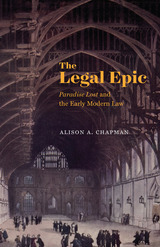 The Legal Epic: "Paradise Lost" and the Early Modern Law
Alison A. Chapman
University of Chicago Press, 2017 The seventeenth century saw some of the most important jurisprudential changes in England’s history, yet the period has been largely overlooked in the rich field of literature and law. Helping to fill this gap, The Legal Epic is the first book to situate the great poet and polemicist John Milton at the center of late seventeenth-century legal history.
Alison A. Chapman argues that Milton’s Paradise Lost sits at the apex of the early modern period’s long fascination with law and judicial processes. Milton’s world saw law and religion as linked disciplines and thought therefore that in different ways, both law and religion should reflect the will of God. Throughout Paradise Lost, Milton invites his readers to judge actions using not only reason and conscience but also core principles of early modern jurisprudence. Law thus informs Milton’s attempt to “justify the ways of God to men” and points readers toward the types of legal justice that should prevail on earth.
Adding to the growing interest in the cultural history of law, The Legal Epic shows that England’s preeminent epic poem is also a sustained reflection on the role law plays in human society.
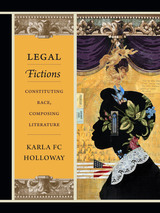 Legal Fictions: Constituting Race, Composing Literature
Karla FC Holloway
Duke University Press, 2014 In Legal Fictions, Karla FC Holloway both argues that U.S. racial identity is the creation of U.S. law and demonstrates how black authors of literary fiction have engaged with the law's constructions of race since the era of slavery. Exploring the resonance between U.S. literature and U.S. jurisprudence, Holloway reveals Toni Morrison's Beloved and Charles Johnson's Middle Passage as stories about personhood and property, David Bradley's The Chaneysville Incident and Ralph Ellison's Invisible Man as structured by evidence law, and Nella Larsen's Passing as intimately related to contract law. Holloway engages the intentional, contradictory, and capricious constructions of race embedded in the law with the same energy that she brings to her masterful interpretations of fiction by U.S. writers. Her readings shed new light on the many ways that black U.S. authors have reframed fundamental questions about racial identity, personhood, and the law from the nineteenth into the twenty-first centuries. Legal Fictions is a bold declaration that the black body is thoroughly bound by law and an unflinching look at the implications of that claim.
The Legal Imagination
James Boyd White
University of Chicago Press, 1985 White extends his theory of law as constitutive rhetoric, asking how one may criticize the legal culture and the texts within it.
"A fascinating study of the language of the law. . . . This book is to be highly recommended: certainly, for those who find the time to read it, it will broaden the mind, and give lawyers a new insight into their role."—New Law Journal
Legal Instruments of Foundations
Frank Emerson Andrews
Russell Sage Foundation, 1958 This study contains fifty-eight documents from forty-nine different foundations, selected to represent a wide variety of these organizations. Included are documents from at least one perpetuity, dissolving fund, discretionary perpetuity; at least one company-sponsored foundation, family foundation, foundation engaged in unrelated business activities, association of foundations, "captive" foundation; at least one research foundation, special-purpose foundation, community trust scholarship fund. Several documents have been included for historical interest; documents of two foreign foundations for their comparison values. A final chapter introduces certain operational documents: grant notification form, agreement with consultants, outline for grant applicants, publication agreement.
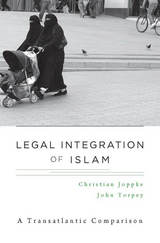 Legal Integration of Islam: A Transatlantic Comparison
Christian Joppke and John Torpey
Harvard University Press, 2013 The status of Islam in Western societies remains deeply contentious. Countering strident claims on both the right and left, Legal Integration of Islam offers an empirically informed analysis of how four liberal democracies—France, Germany, Canada, and the United States—have responded to the challenge of integrating Islam and Muslim populations. Demonstrating the centrality of the legal system to this process, Christian Joppke and John Torpey reject the widely held notion that Europe is incapable of accommodating Islam and argue that institutional barriers to Muslim integration are no greater on one side of the Atlantic than the other.
While Muslims have achieved a substantial degree of equality working through the courts, political dynamics increasingly push back against these gains, particularly in Europe. From a classical liberal viewpoint, religion can either be driven out of public space, as in France, or included without sectarian preference, as in Germany. But both policies come at a price—religious liberty in France and full equality in Germany. Often seen as the flagship of multiculturalism, Canada has found itself responding to nativist and liberal pressures as Muslims become more assertive. And although there have been outbursts of anti-Islamic sentiment in the United States, the legal and political recognition of Islam is well established and largely uncontested.
Legal Integration of Islam brings to light the successes and the shortcomings of integrating Islam through law without denying the challenges that this religion presents for liberal societies.
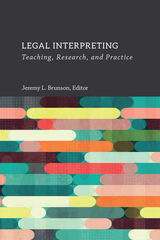 Legal Interpreting: Teaching, Research, and Practice
Jeremy L. Brunson
Gallaudet University Press, 2022 Linguistic minorities are often severely disadvantaged in legal events, with consequences that could impact one’s very liberty. Training for interpreters to provide full access in legal settings is paramount. In this volume, Jeremy L. Brunson has gathered deaf and hearing scholars and practitioners from both signed and spoken language interpreting communities in the United States, Canada, and the United Kingdom. Their contributions include research-driven, experience-driven, and theoretical discussions on how to teach and assess legal interpreting. The topics covered include teaming in a courtroom, introducing students to legal interpreting, being an expert witness, discourses used by deaf lawyers, designing assessment tools for legal settings, and working with deaf jurors. In addition, this volume interrogates the various ways power, privilege, and oppression appear in legal interpreting.
Each chapter features discussion questions and prompts that interpreter educators can use in the classroom. While intended as a foundational text for use in courses, this body of work also provides insight into the current state of the legal interpreting field and will be a valuable resource for scholars, practitioners, and consumers.
Legal Inversions: Lesbians, Gay Men, and the Politics of the Law
edited by Didi Herman and Carl Stychin
Temple University Press, 1995 Law reform struggles have always been a part of the grassroots lesbian and gay agenda. These critical essays examine the politics of these engagements, of lesbians, gay men, and the law in the United States, Canada, and the United Kingdom. From a wide range of perspectives, the contributors combine new conceptual insights with a concern for the practicalities of political engagements, tackling such vital topics as legal definitions of homosexuality, AIDS activism, and race and sexuality.
Contributors: Katherine Arnup, Susan Boyd, Peter M. Cicchino, Davina Cooper, Bruce R. Deming, Mary Eaton, William F. Flanagan, Leo Flynn, Shelley A. M. Gavigan, Leslie J. Moran, Katherine M. Nicholson, Cynthia Petersen, Ruthann Robson, and the editors.
Legal Language
Peter M. Tiersma
University of Chicago Press, 1998 Statutes, judicial opinions, contracts, deeds, and wills profoundly affect our daily lives, but their language tends to be often nearly impossible to understand. In this lively history of legal language, Peter Tiersma slices through the thicket of legalese, explaining where it comes from, why lawyers continue to cling to it, and why it's doesn't have to be an inevitable feature of our legal system.
"Legal Language will resonate with lawyers . . . and any non-lawyer who has waded through legal documents, or has tuned in to the latest trial on Court TV."—Carmie D. Boccuzzi, Jr., Boston Book Review
"[A] masterful, highly readable, and enjoyable book. . . . Legal Language is truly a fun book to read."—David Schultz, Law and Politics Book Review
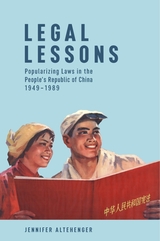 Legal Lessons: Popularizing Laws in the People’s Republic of China, 1949–1989
Jennifer Altehenger
Harvard University Press, 2018 The popularization of basic legal knowledge is an important and contested technique of state governance in China today. Its roots reach back to the early years of Chinese Communist Party rule. Legal Lessons tells the story of how the party-state attempted to mobilize ordinary citizens to learn laws during the early years of the Mao period (1949–1976) and in the decade after Mao’s death.
Examining case studies such as the dissemination of the 1950 Marriage Law and successive constitutions since 1954 in Beijing and Shanghai, Jennifer Altehenger traces the dissemination of legal knowledge at different levels of state and society. Archival records, internal publications, periodicals, advice manuals, memoirs, and colorful propaganda materials reveal how official attempts to determine and promote “correct” understandings of laws intersected with people’s interpretations of written laws and with their experiences of laws in practice. They also show how diverse groups—including party-state leadership, legal experts, publishers, writers, artists, and local officials, along with ordinary people—helped to define the meaning of laws in China’s socialist society. Placing mass legal education and law propaganda at the center of analysis, Legal Lessons offers a new perspective on the sociocultural and political history of law in socialist China.
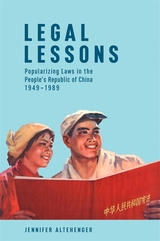 Legal Lessons: Popularizing Laws in the People’s Republic of China, 1949–1989
Jennifer Altehenger
Harvard University Press The popularization of basic legal knowledge is an important and contested technique of state governance in China today. Its roots reach back to the early years of Chinese Communist Party rule. Legal Lessons tells the story of how the party-state attempted to mobilize ordinary citizens to learn laws during the early years of the Mao period (1949–1976) and in the decade after Mao’s death.
Examining case studies such as the dissemination of the 1950 Marriage Law and successive constitutions since 1954 in Beijing and Shanghai, Jennifer Altehenger traces the dissemination of legal knowledge at different levels of state and society. Archival records, internal publications, periodicals, advice manuals, memoirs, and colorful propaganda materials reveal how official attempts to determine and promote “correct” understandings of laws intersected with people’s interpretations of written laws and with their experiences of laws in practice. They also show how diverse groups—including party-state leadership, legal experts, publishers, writers, artists, and local officials, along with ordinary people—helped to define the meaning of laws in China’s socialist society. Placing mass legal education and law propaganda at the center of analysis, Legal Lessons offers a new perspective on the sociocultural and political history of law in socialist China.
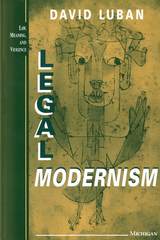 Legal Modernism
David Luban
University of Michigan Press, 1997 Modernism in legal theory is no different from modernism in the arts: both respond to a cultural crisis, a sense that institutions and traditions have lost their validity. Some doubt the importance of the rule of law, others question the objectivity of legal reasoning. We have lost confidence in the justice of our legal institutions, and even in our very capacity to identify justice.
Legal philosopher David Luban argues that we cannot escape the modernist predicament. Accusing contemporary legal theorists of evading rather than confronting the challenge of modernity, he offers important and original objections to pragmatism, traditionalism, and nihilism. He argues that only by weaving together the broken narrative and forgotten voices of history's victims can we come to appreciate the nature of justice in modern society. Calling a trial the embodiment of the law's self-criticism, Luban demonstrates the centrality of narrative by analyzing the trial of Martin Luther King, the Nuremberg trials, and trial scenes in Homer, Hesiod, and Aeschylus. With these examples, Luban explores several of the tensions that motivate much more contemporary legal theory: order versus justice, obedience versus resistance, statism versus communitarianism.
". . . an illuminating account of how contemporary legal theory can be understood as an expression of 'the modernist predicament' by exploring the analogy between modernism in the arts and modernism in law, politics, and philosophy. . . . a valuable critical discussion of modern legal theory." --Choice
David Luban is Morton and Sophia Macht Professor of Law at the University of Maryland and Research Scholar at the Institute for Philosophy and Public Policy. His other books include Lawyers and Justice: An Ethical Study.
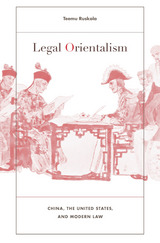 Legal Orientalism: China, the United States, and Modern Law
Teemu Ruskola
Harvard University Press, 2013 Since the Cold War ended, China has become a global symbol of disregard for human rights, while the United States has positioned itself as the world’s chief exporter of the rule of law. How did lawlessness become an axiom about Chineseness rather than a fact needing to be verified empirically, and how did the United States assume the mantle of law’s universal appeal? In a series of wide-ranging inquiries, Teemu Ruskola investigates the history of “legal Orientalism”: a set of globally circulating narratives about what law is and who has it. For example, why is China said not to have a history of corporate law, as a way of explaining its “failure” to develop capitalism on its own? Ruskola shows how a European tradition of philosophical prejudices about Chinese law developed into a distinctively American ideology of empire, influential to this day.
The first Sino-U.S. treaty in 1844 authorized the extraterritorial application of American law in a putatively lawless China. A kind of legal imperialism, this practice long predated U.S. territorial colonialism after the Spanish-American War in 1898, and found its fullest expression in an American district court’s jurisdiction over the “District of China.” With urgent contemporary implications, legal Orientalism lives on in the enduring damage wrought on the U.S. Constitution by late nineteenth-century anti-Chinese immigration laws, and in the self-Orientalizing reforms of Chinese law today. In the global politics of trade and human rights, legal Orientalism continues to shape modern subjectivities, institutions, and geopolitics in powerful and unacknowledged ways.
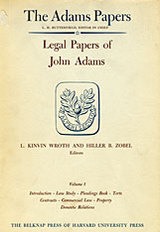 Legal Papers of John Adams
John Adams
Harvard University Press, 1981 Like many another statesman, John Adams entered the political arena by way of the legal profession. Here, gathered together in three volumes, is an inclusive presentation of the important legal cases in which he was involved. Student notes and Commonplace Book, which show the influences on the young law student in 1758 and 1759 are followed by Adams' Pleadings Book, a collection of forms providing a cross-section of the law in eighteenth-century Massachusetts and showing his work as teacher as well as student.
The sixty-four cases documented are divided into sixteen legal categories such as Torts, Property, Domestic Relations, Town Government, Conservation, Religion, Slavery, and Admiralty. They are preceded by editorial headnotes which discuss the background, significance, and importance of each category and case. Careful and thorough footnotes explain textual and legal problems; a register of John Adams' contemporaries furnishes sketches of his colleagues on the bench and bar; and an exhaustive chronology records his growing practice. But the bulk of the material consists of Adams' own notes and minutes, supplemented by court records, letters, depositions of witnesses, and the minutes of other lawyers, as well as extracts from Adams' correspondence and diary to make the record of each case as full as possible. Many of the cases concern events, personalities, and legal struggles directly related to the American Revolution.
The entire third volume of this imposing collection is devoted to the so-called "Boston Massacre." Confronted by a fascinating mass of conflicting evidence, charges and countercharges, and confused and confusing witnesses, many Americans will be surprised to discover that they must revise their notions about what actually happened on that March evening in 1770, why it did, and what ensued.
These three books comprise the first segment of Series III of The Adams Papers. The William Nelson Cromwell Foundation has made possible the editing of these volumes by means of a generous grant to the Harvard Law School.
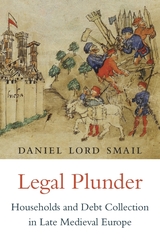 Legal Plunder: Households and Debt Collection in Late Medieval Europe
Daniel Lord Smail
Harvard University Press, 2016 As Europe began to grow rich during the Middle Ages, its wealth materialized in the well-made clothes, linens, and wares of ordinary households. Such items were indicators of one’s station in life in a society accustomed to reading visible signs of rank. In a world without banking, household goods became valuable commodities that often substituted for hard currency. Pawnbrokers and resellers sprang up, helping to push these goods into circulation. Simultaneously, a harshly coercive legal system developed to ensure that debtors paid their due.
Focusing on the Mediterranean cities of Marseille and Lucca, Legal Plunder explores how the newfound wealth embodied in household goods shaped the beginnings of a modern consumer economy in late medieval Europe. The vigorous trade in goods that grew up in the fourteenth and fifteenth centuries entangled households in complex relationships of credit and debt, and one of the most common activities of law courts during the period was debt recovery. Sergeants of the law were empowered to march into debtors’ homes and seize belongings equal in value to the debt owed. These officials were agents of a predatory economy, cogs in a political machinery of state-sponsored plunder.
As Daniel Smail shows, the records of medieval European law courts offer some of the most vivid descriptions of material culture in this period, providing insights into the lives of men and women on the cusp of modern capitalism. Then as now, money and value were implicated in questions of power and patterns of violence.
 Legal Plunder: The Predatory Dimensions of Criminal Justice
Joshua Page and Joe Soss
University of Chicago Press, 2025 A searing, historically rich account of how US policing and punishment have been retrofitted over the last four decades to extract public and private revenues from America’s poorest and most vulnerable communities. Alongside the rise of mass incarceration, a second profound and equally disturbing development has transpired. Since the 1980s, US policing and punishment have been remade into tools for stripping resources from the nation’s most oppressed communities and turning them into public and private revenues. Legal Plunder analyzes this development’s origins, operations, consequences, and the political struggles that it has created. Drawing on historical and contemporary evidence, including original ethnographic research, Joshua Page and Joe Soss examine the predatory dimensions of criminal legal governance to show how practices that criminalize, police, and punish have been retrofitted to siphon resources from subordinated groups, subsidize governments, and generate corporate profits. As tax burdens have declined for the affluent, this financial extraction—now a core function of the country’s sprawling criminal legal apparatus—further compounds race, class, and gender inequalities and injustices. Legal Plunder shows that we can no longer afford to overlook legal plunder or the efforts to dismantle it.
 Legal Plunder: The Predatory Dimensions of Criminal Justice
Joshua Page and Joe Soss
University of Chicago Press, 2025 This is an auto-narrated audiobook version of this book.
A searing, historically rich account of how US policing and punishment have been retrofitted over the last four decades to extract public and private revenues from America’s poorest and most vulnerable communities. Alongside the rise of mass incarceration, a second profound and equally disturbing development has transpired. Since the 1980s, US policing and punishment have been remade into tools for stripping resources from the nation’s most oppressed communities and turning them into public and private revenues. Legal Plunder analyzes this development’s origins, operations, consequences, and the political struggles that it has created. Drawing on historical and contemporary evidence, including original ethnographic research, Joshua Page and Joe Soss examine the predatory dimensions of criminal legal governance to show how practices that criminalize, police, and punish have been retrofitted to siphon resources from subordinated groups, subsidize governments, and generate corporate profits. As tax burdens have declined for the affluent, this financial extraction—now a core function of the country’s sprawling criminal legal apparatus—further compounds race, class, and gender inequalities and injustices. Legal Plunder shows that we can no longer afford to overlook legal plunder or the efforts to dismantle it.
Legal Records at Risk: A Strategy for Safeguarding our Legal Heritage
Clare Cowling
University of London Press, 2019 Why do so few institutions in the legal sector have professional records managers or archivists on their staff? This book is the culmination of a three year project by experienced archivist and records managers on private sector legal records at risk in England at Wales. It summarises the work of the Legal Records at Risk (LRAR) project and its predecessors, diagnoses the problems of preservation of archives in the legal sector in England and Wales and outlines a national strategy for such records.
 Legal Reform in Central America: Dispute Resolution and Property Systems
Martha A. Field and William W. Fisher III
Harvard University Press, 2001 The countries of Central America, afflicted for many years by civil strife and economic stagnation, are entering a new era of peace, democracy, and economic development. Now, more than ever, it is necessary for reforms in the legal system to successfully support these changes.
This volume examines two fields of law in which reforms are especially crucial: the improvement of the judicial systems and other mechanisms for resolving noncriminal disputes, and modernization of the laws governing both tangible and "intellectual" property. Among the specific topics addressed in the volume are the debate over "oralidad;" the problem of interlocutory appeals; nonjudicial procedures for resolving disputes (negotiation, mediation, conciliation, and arbitration); land and trademark registration systems; land reform in Nicaragua; the management of genetic resources; online legal databases; and legal education.
 Legal Resistance under Authoritarianism: The Struggle for the Rule of Law in Hong Kong
Yan-ho Lai
Amsterdam University Press, 2025 Legal Resistance Under Authoritarianism: The Struggle for the Rule of Law in Hong Kong examines the decline of Hong Kong’s rule of law under China’s expanding authoritarian influence. While the imposition of the National Security Law in 2020 is seen as a turning point, this book argues that threats to Hong Kong’s rule of law began with the 1997 sovereignty transfer. Drawing on comprehensive fieldwork, Yan-ho Lai explores the tensions between legal profession, political authorities and the state’s broader authoritarian project between the 2014 Umbrella Movement and the 2019 Anti-extradition Bill Movement. Highlighting resistance strategies employed by a critical minority of legal professionals, Lai reveals how their efforts played a crucial role in countering state encroachment. A compelling study of legal transplantation, legal resistance and the rule of law, this book sheds light on China’s influence beyond its jurisdiction, and Hong Kong’s uniqueness in global anti-authoritarian struggles.
 Legal Resistance under Authoritarianism: The Struggle for the Rule of Law in Hong Kong
Yan-ho Lai
Amsterdam University Press, 2025 Legal Resistance Under Authoritarianism: The Struggle for the Rule of Law in Hong Kong examines the decline of Hong Kong’s rule of law under China’s expanding authoritarian influence. While the imposition of the National Security Law in 2020 is seen as a turning point, this book argues that threats to Hong Kong’s rule of law began with the 1997 sovereignty transfer. Drawing on comprehensive fieldwork, Yan-ho Lai explores the tensions between legal profession, political authorities and the state’s broader authoritarian project between the 2014 Umbrella Movement and the 2019 Anti-extradition Bill Movement. Highlighting resistance strategies employed by a critical minority of legal professionals, Lai reveals how their efforts played a crucial role in countering state encroachment. A compelling study of legal transplantation, legal resistance and the rule of law, this book sheds light on China’s influence beyond its jurisdiction, and Hong Kong’s uniqueness in global anti-authoritarian struggles.
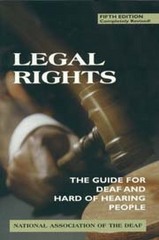 Legal Rights, 5th Ed.: The Guide for Deaf and Hard of Hearing People
National Association of the Deaf
Gallaudet University Press, 2000 "An essential volume for all concerned with the legal rights and services for people with hearing loss."
-- SHHH Journal
"A good guide for compliance with ADA and provides specific suggestions and recommendations."
-- Hearing Rehabilitation Quarterly
The new, revised, fifth edition of Legal Rights offers in easy-to-understand language the latest state and federal statutes and administrative procedures that prohibit discrimination against deaf and hard of hearing people, and any others with physical challenges. It includes complete information on the Telecommunications Act of 1996, new laws for hearing-aid-compatible telephones, the new Rehabilitation Act regulations that ensure access to electronic and information technology, and how recent Supreme Court rulings will affect people who wear hearing aids.
This outstanding resource also explains new requirements for federal buildings and other new structures to provide full access. Recent additions to the Individuals with Disabilities Education Act are described, as are the ways public schools can meet new acoustical standards for classrooms. Legal Rights covers the entire spectrum of communication issues for deaf and hard of hearing people, from the new rules about interpreters in federal courts to the latest developments regarding relay services. It also lists those states that are leaders in ensuring access and equal rights to people with disabilities, making it the most complete source of legal information for deaf and hard of hearing people now available.
Founded in 1880, the National Association of the Deaf (NAD) is the oldest and largest organization representing people with disabilities in the United States.
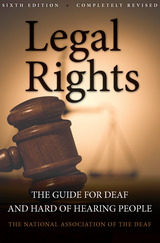 Legal Rights, 6th Ed.: The Guide for Deaf and Hard of Hearing People
National Association of the Deaf
Gallaudet University Press, 2015 The standard handbook on law affecting deaf and hard of hearing people has been completely rewritten and updated. The sixth edition of Legal Rights: The Guide for Deaf and Hard of Hearing People meticulously describes those statutes that prohibit discrimination against deaf and hard of hearing people, and any others with physical challenges. Written in easy-to-understand language, the new edition describes the core legislation and laws and their critical importance since their inception: The Rehabilitation Act of 1973, the Individuals with Disabilities Education Act (IDEA), and the Americans with Disabilities Act (ADA).
The new Legal Rights also explains the significant amendments to these laws, including the ADA Amendments Act (ADAAA) and new regulations to its Title II concerning public entities and Title III pertaining to public accommodations and commercial facilities. The reauthorization of IDEA expanded the No Child Left Behind Act requirement for highly qualified teachers to all students with disabilities. This new edition also tracks the trend of passing a Deaf and Hard of Hearing Children’s Bill of Rights in a growing number of state legislatures.
This completely new resource also delineates new legislation such as the Twenty-First Century Communications Video and Accessibility Act, which ensures access to the newest communications technology for deaf and hard of hearing people. Legal Rights also includes information on the use of interpreters in the legal system, securing its position as the most comprehensive reference of legal information for deaf and hard of hearing people now available.
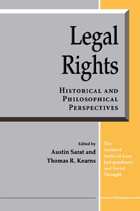 Legal Rights: Historical and Philosophical Perspectives
Austin Sarat and Thomas R. Kearns, Editors
University of Michigan Press, 1997 The idea of legal rights today enjoys virtually universal appeal, yet all too often the meaning and significance of rights are poorly understood. The purpose of this volume is to clarify the subject of legal rights by drawing on both historical and philosophical legal scholarship to bridge the gap between these two genres--a gap that has divorced abstract and normative treatments of rights from an understanding of their particular social and cultural contexts.
Legal Rights: Historical and Philosophical Perspectives shows that the meaning and extent of rights has been dramatically expanded in this century, though along with the widespread and flourishing popularity of rights, voices of criticism have increasingly been raised. The authors take up the question of the foundation of rights and explore the postmodern challenges to efforts to ground rights outside of history and language. Drawing rich historical analysis and careful philosophical inquiry into productive dialogue, this book explores the many facets of rights at the end of the twentieth century. In these essays, potentially abstract debates come alive as they are related to the struggles of real people attempting to cope with, and improve, their living conditions. The significance of legal rights is measured not just in terms of philosophical categories or as a collection of histories, but as they are experienced in the lives of men and women seeking to come to terms with rights in contemporary life.
Contributors are Hadley Arkes, William E. Cain, Thomas Haskell, Morton J. Horwitz, Annabel Patterson, Michael J. Perry, Pierre Schlag, and Jeremy Waldron.
Austin Sarat is William Nelson Cromwell Professor of Jurisprudence and Political Science, Amherst College. Thomas R. Kearns is William H. Hastie Professor of Philosophy, Amherst College.
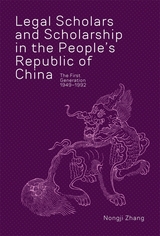 Legal Scholars and Scholarship in the People’s Republic of China: The First Generation, 1949–1992
Nongji Zhang
Harvard University Press, 2022 Law is a moving system of rules that changes according to a nation’s political and socioeconomic development. To understand the law of the People’s Republic of China today, it is imperative to learn the history and philosophy of the law when it was first shaped. This is a comprehensive introduction to Chinese legal scholarship and the prominent scholars who developed it during the initial decades of the PRC, when the old Chinese legal system was abolished by the newly established Communist government. With responsibilities for full-scale recovery and reconstruction, while cultivating entirely new disciplines and branches of legal studies, the thirty-three leading legal scholars featured herein became the creators, pioneers, and teachers of the new Communist legal system. Through their scholarship, we can see where the field of Chinese legal studies came from, and where it is going.
Nongji Zhang reveals the stories of the most prominent PRC legal scholars, including their backgrounds, scholarly contributions, and important works. This essential tool and resource for the study of Chinese law will be of great use to faculty, students, scholars, librarians, and anyone interested in the field.
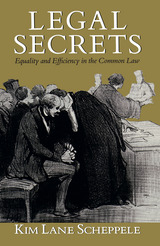 Legal Secrets: Equality and Efficiency in the Common Law
Kim Lane Scheppele
University of Chicago Press, 1988 Does the seller of a house have to tell the buyer that the water is turned off twelve hours a day? Does the buyer of a great quantity of tobacco have to inform the seller that the military blockade of the local port, which had depressed tobacco sales and lowered prices, is about to end? Courts say yes in the first case, no in the second. How can we understand the difference in judgments? And what does it say about whether the psychiatrist should disclose to his patient's girlfriend that the patient wants to kill her?
Kim Lane Scheppele answers the question, Which secrets are legal secrets and what makes them so? She challenges the economic theory of law, which argues that judges decide cases in ways that maximize efficiency, and she shows that judges use equality as an important principle in their decisions. In the course of thinking about secrets, Scheppele also explores broader questions about judicial reasoning—how judges find meaning in legal texts and how they infuse every fact summary with the values of their legal culture. Finally, the specific insights about secrecy are shown to be consistent with a general moral theory of law that indicates what the content of law should be if the law is to be legitimate, a theory that sees legal justification as the opportunity to attract consent.
This is more than a book about secrets. It is also a book about the limits of an economic view of law. Ultimately, it is a work in constructive legal theory, one that draws on moral philosophy, sociology, economics, and political theory to develop a new view of legal interpretation and legal morality.
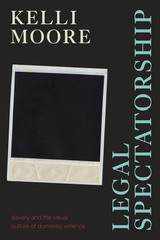 Legal Spectatorship: Slavery and the Visual Culture of Domestic Violence
Kelli Moore
Duke University Press, 2022 In Legal Spectatorship Kelli Moore traces the political origins of the concept of domestic violence through visual culture in the United States. Tracing its appearance in Article IV of the Constitution, slave narratives, police notation, cybernetic theories of affect, criminal trials, and the “look” of the battered woman, Moore contends that domestic violence refers to more than violence between intimate partners—it denotes the mechanisms of racial hierarchy and oppression that undergird republican government in the United States. Moore connects the use of photographic evidence of domestic violence in courtrooms, which often stands in for women’s testimony, to slaves’ silent experience and witnessing of domestic abuse. Drawing on Harriet Jacobs’s Incidents in the Life of a Slave Girl, abolitionist print culture, courtroom witness testimony, and the work of Hortense Spillers, Moore shows how the logic of slavery and antiblack racism also dictates the silencing techniques of the contemporary domestic violence courtroom. By positioning testimony on contemporary domestic violence prosecution within the archive of slavery, Moore demonstrates that domestic violence and its image are haunted by black bodies, black flesh, and black freedom.
Duke University Press Scholars of Color First Book Award recipient
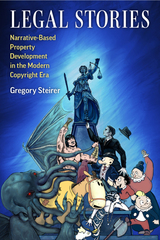 Legal Stories: Narrative-Based Property Development in the Modern Copyright Era
Gregory Steirer
University of Michigan Press, 2024 Tracing the emergence of what the media industries today call transmedia, story worlds, and narrative franchises, Legal Stories provides a dual history of copyright law and narrative-based media development between the Copyright Act of 1909 and the Copyright Act of 1976. Drawing on archival material, including legal case files, and employing the principles of actor-network theory, Gregory Steirer demonstrates how the meaning and form of narrative-based property in the twentieth century was integral to the letter and practice of intellectual property law during this time.
Steirer’s expansive view of intellectual property law encompasses not only statutes and judicial opinions, but also the everyday practices and productions of authors, editors, fans, and other legal laypersons. The result is a history of the law as improvisatory and accident-prone, taking place as often outside the courtroom as inside, and shaped as much by laypersons as lawyers. Through the examination of influential legal disputes involving early properties such as Dashiell Hammett’s Sam Spade, H. P. Lovecraft’s Cthulhu Mythos, and Robert E. Howard’s Conan the Barbarian, Steirer provides a ground’s eye view of how copyright law has operated and evolved in practice.
The Legal System: A Social Science Perspective
Lawrence M. Friedman
Russell Sage Foundation, 1975 Examines the impact of social forces on the legal system and how the rules and orders promulgated by that legal system affect social behavior. Dr. Friedman explores the relationship between class structure and the work of legal systems in the light of the existing literature and analyzes the influence of the cultural elements contained in a legal system. In a comprehensive analysis of the concept of legal culture, the author sheds new light on the development of our legal norms and the types of legal systems which prevail in a democracy.
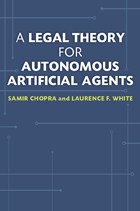 A Legal Theory for Autonomous Artificial Agents
Samir Chopra and Laurence F. White
University of Michigan Press, 2011 “An extraordinarily good synthesis from an amazing range of philosophical, legal, and technological sources . . . the book will appeal to legal academics and students, lawyers involved in e-commerce and cyberspace legal issues, technologists, moral philosophers, and intelligent lay readers interested in high tech issues, privacy, [and] robotics.”
—Kevin Ashley, University of Pittsburgh School of Law As corporations and government agencies replace human employees with online customer service and automated phone systems, we become accustomed to doing business with nonhuman agents. If artificial intelligence (AI) technology advances as today’s leading researchers predict, these agents may soon function with such limited human input that they appear to act independently. When they achieve that level of autonomy, what legal status should they have? Samir Chopra and Laurence F. White present a carefully reasoned discussion of how existing philosophy and legal theory can accommodate increasingly sophisticated AI technology. Arguing for the legal personhood of an artificial agent, the authors discuss what it means to say it has “knowledge” and the ability to make a decision. They consider key questions such as who must take responsibility for an agent’s actions, whom the agent serves, and whether it could face a conflict of interest.
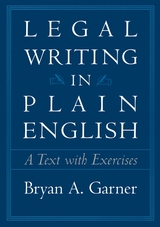 Legal Writing in Plain English: A Text with Exercises
Bryan A. Garner
University of Chicago Press, 2001 Admirably clear, concise, down-to-earth, and powerful-unfortunately, these adjectives rarely describe legal writing, whether in the form of briefs, opinions, contracts, or statutes. In Legal Writing in Plain English, Bryan A. Garner provides lawyers, judges, paralegals, law students, and legal scholars sound advice and practical tools for improving their written work. The book encourages legal writers to challenge conventions and offers valuable insights into the writing process: how to organize ideas, create and refine prose, and improve editing skills. In essence, it teaches straight thinking—a skill inseparable from good writing.
Replete with common sense and wit, the book draws on real-life writing samples that Garner has gathered through more than a decade of teaching in the field. Trenchant advice covers all types of legal materials, from analytical and persuasive writing to legal drafting. Meanwhile, Garner explores important aspects of document design. Basic, intermediate, and advanced exercises in each section reinforce the book's principles. (An answer key to basic exercises is included in the book; answers to intermediate and advanced exercises are provided in a separate Instructor's Manual, free of charge to instructors.) Appendixes include a comprehensive punctuation guide with advice and examples, and four model documents.
Today more than ever before, legal professionals cannot afford to ignore the trend toward clear language shorn of jargon. Clients demand it, and courts reward it. Despite the age-old tradition of poor writing in law, Legal Writing in Plain English shows how legal writers can unshackle themselves.
Legal Writing in Plain English includes:
*Tips on generating thoughts, organizing them, and creating outlines.
*Sound advice on expressing your ideas clearly and powerfully.
*Dozens of real-life writing examples to illustrate writing problems and solutions.
*Exercises to reinforce principles of good writing (also available on the Internet).
*Helpful guidance on page layout.
*A punctuation guide that shows the correct uses of every punctuation mark.
*Model legal documents that demonstrate the power of plain English.
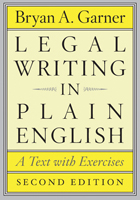 Legal Writing in Plain English, Second Edition: A Text with Exercises
Bryan A. Garner
University of Chicago Press, 2013
Admirably clear, concise, down-to-earth, and powerful—all too often, legal writing embodies none of these qualities. Its reputation for obscurity and needless legalese is widespread. Since 2001 Bryan A. Garner’s Legal Writing in Plain English has helped address this problem by providing lawyers, judges, paralegals, law students, and legal scholars with sound advice and practical tools for improving their written work. Now the leading guide to clear writing in the field, this indispensable volume encourages legal writers to challenge conventions and offers valuable insights into the writing process that will appeal to other professionals: how to organize ideas, create and refine prose, and improve editing skills.
Accessible and witty, Legal Writing in Plain English draws on real-life writing samples that Garner has gathered through decades of teaching experience. Trenchant advice covers all types of legal materials, from analytical and persuasive writing to legal drafting, and the book’s principles are reinforced by sets of basic, intermediate, and advanced exercises in each section.
In this new edition, Garner preserves the successful structure of the original while adjusting the content to make it even more classroom-friendly. He includes case examples from the past decade and addresses the widespread use of legal documents in electronic formats. His book remains the standard guide for producing the jargon-free language that clients demand and courts reward.
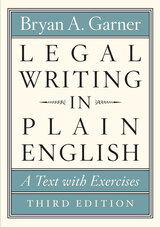 Legal Writing in Plain English, Third Edition: A Text with Exercises
Bryan A. Garner
University of Chicago Press, 2023 The leading guide to clear writing—and clear thinking—in the legal profession for more than two decades, now newly updated.
Admirably clear, concise, down-to-earth, and powerful—all too often, legal writing embodies none of these qualities. Its reputation for obscurity and needless legalese is widespread. Since 2001, Bryan A. Garner’s Legal Writing in Plain English has helped address this problem by providing lawyers, judges, paralegals, law students, and legal scholars with sound advice and practical tools for improving their written work. Now the leading guide to clear writing in the field, this indispensable volume encourages legal writers to challenge conventions and offers valuable insights into the writing process: how to organize ideas, create and refine prose, and improve editing skills.
Accessible and witty, Legal Writing in Plain English draws on real-life writing samples that Garner has gathered through decades of teaching experience. Trenchant advice covers all types of legal materials, from analytical and persuasive writing to legal drafting, and the book’s principles are reinforced by sets of basic, intermediate, and advanced exercises in each section.
For this third edition, Garner has retained the structure of the previous versions, with updates and new material throughout. There are new sections on making your writing vivid and concrete and on using graphics to enhance your argument. The coverage and examples of key topics such as achieving parallelism, avoiding legalese, writing effective openers and summaries, and weaving quotations into your text have also been expanded. And the sample legal documents and exercises have been updated, while newly added checklists provide quick summaries of each section.
Altogether, this new edition will be the most useful yet for legal professionals and students seeking to improve their prose.
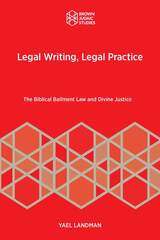 Legal Writing, Legal Practice: The Biblical Bailment Law and Divine Justice
Yael Landman
SBL Press, 2022 Prescriptive law writings rarely mirror the ways a society practices law, a fact that raises special problems for the social and legal historian. Through close analysis of the laws of bailment (i.e., temporary safekeeping) in Exodus 22, Yael Landman probes the relationship of law in the biblical law collections and law-in-practice in ancient Israel and exposes a vision of divine justice at the heart of pentateuchal law. Landman further demonstrates that ancient Near Eastern bailment laws continue to influence postbiblical Jewish law. This book advances an approach to the study of biblical law that connects pentateuchal and ancient Near Eastern law collections, biblical narrative and prophecy, and Mesopotamian legal documents and joins philological and comparative analysis with humanistic legal approaches, in order to access how people thought about and practiced law in ancient Israel.
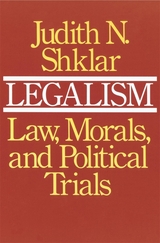 Legalism: Law, Morals, and Political Trials
Judith N. Shklar
Harvard University Press, 1986 Legalism deals with the area between political theory and jurisprudence. Its aim is to bridge the intellectual gulf separating jurisprudence from other kinds of social theory by explaining why, in the view of historians and political theorists, legalism has fallen short in its approach to both morals and politics. Judith Shklar proposes that, instead of regarding law as a discrete entity resting upon a rigid system of definitions, legal theorists should treat it, along with morals and politics, as part of an all-inclusive social continuum.
The first part of the book examines law and morals and criticizes the approach to morals of both the analytical positivists and the natural law theorists. The second part, on law and politics, deals with legalism as a political ideology that comes into conflict with other policies, particularly during political trials.
Incisively and stylishly written, the book constitutes an open challenge to reconsider the fundamental question of the relationship of law to society.
Legalism: Law, Morals, and Political Trials
Judith N. Shklar
Harvard University Press Incisively and stylishly written, this book constitutes an open challenge to reconsider the fundamental question of the relationship of law to society.
 Legality
Scott J. Shapiro
Harvard University Press, 2002 What is law? This question has preoccupied philosophers from Plato to Thomas Hobbes to H. L. A. Hart. Yet many others find it perplexing. How could we possibly know how to answer such an abstract question? And what would be the point of doing so? In Legality, Scott Shapiro argues that the question is not only meaningful but vitally important. In fact, many of the most pressing puzzles that lawyers confront—including who has legal authority over us and how we should interpret constitutions, statutes, and cases—will remain elusive until this grand philosophical question is resolved.
Shapiro draws on recent work in the philosophy of action to develop an original and compelling answer to this age-old question. Breaking with a long tradition in jurisprudence, he argues that the law cannot be understood simply in terms of rules. Legal systems are best understood as highly complex and sophisticated tools for creating and applying plans. Shifting the focus of jurisprudence in this way—from rules to plans—not only resolves many of the most vexing puzzles about the nature of law but has profound implications for legal practice as well.
Written in clear, jargon-free language, and presupposing no legal or philosophical background, Legality is both a groundbreaking new theory of law and an excellent introduction to and defense of classical jurisprudence.
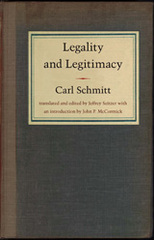 Legality and Legitimacy
Carl Schmitt
Duke University Press, 2004 Carl Schmitt ranks among the most original and controversial political thinkers of the twentieth century. His incisive criticisms of Enlightenment political thought and liberal political practice remain as shocking and significant today as when they first appeared in Weimar Germany. Unavailable in English until now, Legality and Legitimacy was composed in 1932, in the midst of the crisis that would lead to the collapse of the Weimar Republic and only a matter of months before Schmitt’s collaboration with the Nazis. In this important work, Schmitt questions the political viability of liberal constitutionalism, parliamentary government, and the rule of law. Liberal governments, he argues, cannot respond effectively to challenges by radical groups like the Nazis or Communists. Only a presidential regime subject to few, if any, practical limitations can ensure domestic security in a highly pluralistic society. Legality and Legitimacy is sure to provide a compelling reference point in contemporary debates over the challenges facing constitutional democracies today. In addition to Jeffrey Seitzer’s translation of the 1932 text itself, this volume contains his translation of Schmitt’s 1958 commentary on the work, extensive explanatory notes, and an appendix including selected articles of the Weimar constitution. John P. McCormick’s introduction places Legality and Legitimacy in its historical context, clarifies some of the intricacies of the argument, and ultimately contests Schmitt’s claims regarding the inherent weakness of parliamentarism, constitutionalism, and the rule of law.
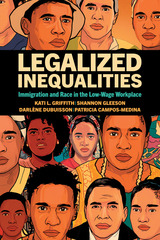 Legalized Inequalities: Immigration and Race in the Low-wage Workplace
Kati L. Griffith
Russell Sage Foundation, 2025 Beyond unlivable wages and a lack of upward mobility, low-wage work in the United States is rife with danger and degrading treatment. Immigrants and people of color are overrepresented in these “bad jobs” and often feel as though they are unable to change their working conditions. In Legalized Inequalities, law scholar Kati L. Griffith, sociologist Shannon Gleeson, anthropologist Darlène Dubuisson, and political scientist Patricia Campos-Medina investigate the government’s role in perpetuating poor and dangerous work environments for low-wage immigrant workers of color.
Drawing on interviews with over three hundred low-wage Haitian and Central American workers and worker advocates, Griffith, Gleeson, Dubuisson, and Campos-Medina reveal how U.S. policies produce and sustain job instability and insecurity. Together, contemporary U.S. labor and employment law, immigration policy, and enduring racial inequality work in tandem to keep workers’ wages low, lock them into substandard working conditions, and minimize opportunities to push for change. Workplace regulations meant to protect workers are weak and underenforced, privileging employers over workers. At-will employment policies, which allow employers to terminate employees without cause, discourage workers from bargaining for better jobs or holding employers accountable for even the most egregious mistreatment. Federal immigration policy further disempowers workers by deputizing employers to act as immigration enforcement agents through immigration status verification requirements. Undocumented workers often believe they must endure maltreatment or risk deportation. Anti-immigrant sentiment—encouraged by U.S. policy—impacts workers across all status groups. Additionally, despite a proliferation of civil rights legislation, racial disparities remain in the workplace. Workers of color are often paid less, forced to complete more dangerous and demeaning tasks, and subjected to racial harassment.
While these workers face formidable barriers to fighting for their rights, they are not entirely powerless. Some low-wage workers filed formal complaints with government agencies. Others, on their own or collectively, confronted their employers to demand fair and dignified treatment. Some even quit in protest of their poor working conditions. The authors argue that reforming labor and employment law, immigration law, and Civil Rights law is necessary to reshape the low-wage workplace. They suggest increasing funding for workers’ rights enforcement agencies, removing the mandate for employers to verify a worker’s immigration status, and making it easier to prove that employment discrimination has occurred, among other policy proposals, to help empower and protect low-wage immigrant workers of color.
Legalized Inequalities not only highlights the crushing consequences of U.S. policy on low-wage immigrant workers of color but showcases their resilience in the face of these obstacles.
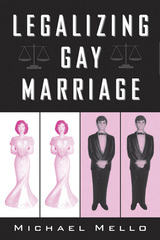 Legalizing Gay Marriage: Vermont And The National Debate
Michael Mello, foreword by David Chambers
Temple University Press, 2004 Every day seems to bring news of legal challenges to existing marriage laws and the constitutionality of any form of union for same-sex partners. In this timely and accessible book, Michael Mello argues that the public debates and political battles that have divided Vermont and Massachusetts will be repeated across the country as state after state confronts the issue of legalizing gay marriage.Michael Mello examines recent landmark decisions in state and federal high courts granting civil rights protections to homosexuals. In Vermont, the Supreme Court's recommendation that legislators recognize the "common humanity" that links all individuals irrespective of sexual identity and consider the question of same-sex marriage resulted in the first state legislation to establish civil union. In Massachusetts, the court's ruling that gay marriage is a right protected by the state constitution has plunged the legislature into a contentious debate about a constitutional amendment. In both states, as in California and New York, public discussion of equal civil protections for gays and lesbians soon become mired in contending views of morality, religion, social mores, and the sanctity of heterosexual marriage.Mello regards the widespread and virulent opposition to any form of same-sex unions as proof that in Vermont, as elsewhere, homosexuals are indeed a "despised minority" in need of the law's protection. Thus, civil union laws represent only a partial victory because they create a separate and inherently unequal category of relationships for gay people. Mello's analysis of the issues provides an invaluable guide to the battles being waged in state legislatures and by politicians at the national level.
Legalizing Moves: Salvadoran Immigrants' Struggle for U.S. Residency
Susan Bibler Coutin
University of Michigan Press, 2003 Legalizing Moves analyzes the battle Salvadoran immigrants have fought for two decades to win legal permanent residency in the United States. Drawing on interviews with Salvadoran asylum applicants, observations of deportation hearings, and fieldwork within the Salvadoran community in Los Angeles, Susan Bibler Coutin illustrates the profound effects of increasingly restrictive immigration laws on the lives of undocumented immigrants in the U.S.
Susan Bibler Coutin is Assistant Professor in the Department of Criminology, Law, and Society, at the University of California, Irvine.
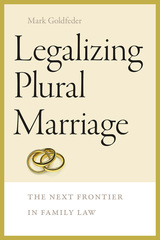 Legalizing Plural Marriage: The Next Frontier in Family Law
Mark Goldfeder
Brandeis University Press, 2017 Polygamous marriages are currently recognized in nearly fifty countries worldwide. Although polygamy is technically illegal in the United States, it is practiced by members of some religious communities and a growing number of other “poly” groups. In the radically changing and increasingly multicultural world in which we live, the time has come to define polygamous marriage and address its legal feasibilities. Although Mark Goldfeder does not argue the right or wrong of plural marriage, he maintains that polygamy is the next step—after same-sex marriage—in the development of U.S. family law. Providing a road map to show how such legalization could be handled, he explores the legislative and administrative arguments which demonstrate that plural marriage is not as farfetched—or as far off—as we might think. Goldfeder argues not only that polygamy is in keeping with the legislative values and freedoms of the United States, but also that it would not be difficult to manage or administrate within our current legal system. His legal analysis is enriched throughout with examples of plural marriage in diverse cultural and historical contexts. Tackling the issue of polygamy in the United States from a legal perspective, this book will engage anyone interested in constitutional law, family law, or criminal law, along with sociologists and those who study gender and culture in modern times.
 Legally Poisoned: How the Law Puts Us at Risk from Toxicants
Carl F. Cranor
Harvard University Press, 2013 Take a random walk through your life and you’ll find it is awash in industrial, often toxic, chemicals. Sip water from a plastic bottle and ingest bisphenol A. Prepare dinner in a non-stick frying pan or wear a layer of Gore-Tex only to be exposed to perfluorinated compounds. Hang curtains, clip your baby into a car seat, watch television—all are manufactured with brominated flame-retardants.
Cosmetic ingredients, industrial chemicals, pesticides, and other compounds enter our bodies and remain briefly or permanently. Far too many suspected toxic hazards are unleashed every day that affect the development and function of our brain, immune system, reproductive organs, or hormones. But no public health law requires product testing of most chemical compounds before they enter the market. If products are deemed dangerous, toxicants must be forcibly reduced or removed—but only after harm has been done.
In this scientifically rigorous legal analysis, Carl Cranor argues that just as pharmaceuticals and pesticides cannot be sold without pre-market testing, other chemical products should be subject to the same safety measures. Cranor shows, in terrifying detail, what risks we run, and that it is entirely possible to design a less dangerous commercial world.
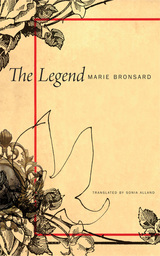 The Legend
Marie Bronsard
Seagull Books, 2013 Now in paperback, Marie Bronsard's strikingly original memoir reweaves the history of her family—and the legend of her grandmother—leaving no stone unturned and no skeleton in the closet.
Egocentric and domineering, Bronsard’s grandmother was once a vibrant and sensual beauty. In Indochina at the end of the Second World War, she thrived in the social life of the French colony, but her young soldier husband sought a quieter existence, finding solace in the companionship of their adolescent daughter, Bronsard’s mother. The consequences of this choice reverberate throughout the family. But far from being an airing of grievance or dirty laundry, Bronsard’s memoir has the air of catharsis—here, the pain, secrets, and comic moments of Bronsard’s family are remembered with gentle humor, understanding, and affection. A wry irony tempers emotion, and it is in these pages that the author, at last, finds it possible to name the woman of the legend and perhaps bring her grandmother a measure of peace.
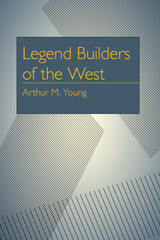 Legend Builders of the West
Arthur Milton Young
University of Pittsburgh Press, 1958 Classical mythology came west from Greece, bearing the thoughts, feelings, and distilled experiences of ancient peoples that have, in turn, been formed by the skilled hands of artists into tangible creations of beauty and significance. Before there were records to preserve significant events, these stories were passed down in tales and songs. Adapted and embellished by successive generations, they were later written down and used to create art from many different materials in different mediums. Within these stories and the creations they inspired was an impulse either to recover the secrets of something that had been lost or to create something new from the old material.
Young examines nine legends-Perseus and Andromeda; Demeter and Persephone; Pyramus and Thisbe; Pygmalion and Galatea; Daedalus and Icarus; Atlanta and Hippomenes; Philemon and Baucis; Echo and Narcissus; and Pomona and Vertumnus-explaining the legends themselves and tracing their dissemination through centuries and civilizations and across various art forms. In Young's view, classical mythology, through expressing humanity's enthusiasms, visions, and talents, might well be considered the “skilled midwife” of human civilization, proof of our constant effort to possess life symbolically and express it through arts.
A Legend for the Legendary: The Origin of the Baseball Hall of Fame
James A. Vlasich
University of Wisconsin Press, 1990 The origins of baseball are controversial. James A. Vlasich discusses the debates between two men intimately involved in nineteenth-century baseball, Henry Chadwick and Albert G. Spalding. Abner Graves of the Mills Commission claimed that Abner Doubleday had invented the game and he had done it in Cooperstown, New York. This claim was scrutinized at the time but the myth became etched into baseball history.
Through the years, however, some critics have questioned the Mills Commission report. The problem is that the Baseball Hall of Fame is built on this shaky foundation. The lack of diligence on the part of Spalding’s self-appointed committee has led to a credibility gap for the baseball shrine that continues a half century after its dedication. Indeed, the story of the building of the Baseball Hall of Fame is filled with intrigue worthy of a political thriller.
 A Legend Of Holy Women: A Translation of Osbern Bokenham's Legends of Holy Women
Sheila Delany
University of Notre Dame Press, 1992 Translation from Middle English of: Legendys of hooly wummen.
Sheila Delany makes available in modern English the first all-female hagiography. The translation is accompanied by full notes, which, along with the introduction, makes the book accessible to a wide audience. It will appeal to all readers interested in the representation of women in late-medieval culture as well as to scholars and students in medieval, renaissance, religious, and women's studies.
"The present translation is smooth and readable. It is based on the 1938 EETS edition of the Legendys of Hooly Wummen by Mary Serjeantson.... On the whole this is an attractive book that may introduce Bokenham to new readers."- The Ricardian
"We must be grateful to Ms. Delany for the assiduity of her well-researched and perceptive study of the life and works of this little known clerical poet." --Times Literary Supplement
The Legend of Light
Bob Hicok
University of Wisconsin Press, 1995 Whether Hicok is considering the reflection of human faces in the Vietnam War Memorial or the elements of a “Modern Prototype” factory, he prompts an icy realization that we may have never seen the world as it truly is. But his resilient voice and consistent perspective is neither blaming nor didactic, and ultimately enlightening. From the shadowed corners into which we dare not look clearly, Hicok makes us witness and hero of The Legend of Light.
The Legend of the Middle Ages: Philosophical Explorations of Medieval Christianity, Judaism, and Islam
Rémi Brague
University of Chicago Press, 2009 This volume presents a penetrating interview and sixteen essays that explore key intersections of medieval religion and philosophy. With characteristic erudition and insight, RémiBrague focuses less on individual Christian, Jewish, and Muslim thinkers than on their relationships with one another. Their disparate philosophical worlds, Brague shows, were grounded in different models of revelation that engendered divergent interpretations of the ancient Greek sources they held in common. So, despite striking similarities in their solutions for the philosophical problems they all faced, intellectuals in each theological tradition often viewed the others’ ideas with skepticism, if not disdain. Brague’s portrayal of this misunderstood age brings to life not only its philosophical and theological nuances, but also lessons for our own time.
The Legend of the Wandering Jew
George K. Anderson
Brandeis University Press, 1991 When Christ, wearied by the heavy burden of the cross, leaned for a moment against a stranger’s doorway, the stranger drove him away and cried, “Walk faster!” To this, Christ replied, “I go, but you will walk until I come again!” So began the legend of the Wandering Jew, which has recurred in many forms of literature and folklore ever since. George K. Anderson, in a book first published in 1965 and immediately hailed as a classic, traces this enduring legend through the ages, from St. John through the Middle Ages to Shelley, Eugène Sue, and the antisemitism of Hitler to recent movies and novels. Though the main elements of the legend are a constant, Anderson shows how changes in emphasis and meaning reflect civilization’s shifting concerns and attitudes over time.
 The "Legend of Zelda: Ocarina of Time": A Game Music Companion
Tim Summers
Intellect Books, 2022 Critical analysis of the music of the iconic 1998 Nintendo 64 video game.
More than twenty years after its creation, The Legend of Zelda: Ocarina of Time is still held in high critical regard as one of the finest examples of the video game medium. The same is true of the game’s music, whose superlative reception continues to be evident, whether in the context of the game or in orchestral concerts and recordings of the game’s music.
Given music’s well-established significance for the video game form, it is no coincidence that music is placed at the forefront of this most lauded and loved of games. In Ocarina of Time, music connects and unifies all aspects of the game, from the narrative conceit to the interactive mechanics, from the characters to the virtual worlds, and even into the activity of legions of fans and gamers, who play, replay, and reconfigure the music in an enduring cultural site that has Ocarina of Time at its center. As video game music studies begins to mature into a coherent field, it is now possible to take the theoretical apparatus and critical approaches that have been developed in antecedent scholarship and put these into practice in the context of an extended concrete game example.
The most extensive investigation into the music of a single game yet undertaken, this book serves three important primary purposes: first, it provides a historical-critical account of the music of an important video game text; second, it uses this investigation to explore wider issues in music and media studies (including interactivity, fan cultures, and music and technology); and third, it serves as a model for future in-depth studies of video game music.
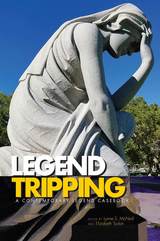 Legend Tripping: A Contemporary Legend Casebook
Lynne S. McNeill
Utah State University Press, 2018 Legend Tripping: A Contemporary Legend Casebook explores the practice of legend tripping, wherein individuals or groups travel to a site where a legend is thought to have taken place. Legend tripping is a common informal practice depicted in epics, stories, novels, and film throughout both contemporary and historical vernacular culture. In this collection, contributors show how legend trips can express humanity’s interest in the frontier between life and death and the fascination with the possibility of personal contact with the supernatural or spiritual.
The volume presents both insightful research and useful pedagogy, making this an invaluable resource in the classroom. Selected major articles on legend tripping, with introductory sections written by the editors, are followed by discussion questions and projects designed to inspire readers to engage critically with legend traditions and customs of legend tripping and to explore possible meanings and symbolics at work. Suggested projects incorporate digital technology as it appears both in legends and in modes of legend tripping.
Legend Tripping is appropriate for students, general readers, and folklorists alike. It is the first volume in the International Society for Contemporary Legend Research series, a set of casebooks providing thorough and up-to-date studies that showcase a variety of scholarly approaches to contemporary legends, along with variants of legend texts, discussion questions, and projects for students.
Contributors: S. Elizabeth Bird, Bill Ellis, Carl Lindahl, Patricia M. Meley, Tim Prizer
Legendary Connecticut: Traditional Tales from the Nutmeg State
David E. Philips
Northwestern University Press, 1995 From Litchfield's great church stove war to Hartford's Charter Oak to Stonington's infamous Lantern Hill, these traditional tales from the Nutmeg State span four centuries of Connecticut history. Personal legends, narratives, anecdotes, and supernatural stories—all are fascinating, humorous and rich with the history and lore of the land.
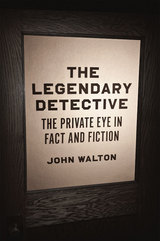 The Legendary Detective: The Private Eye in Fact and Fiction
John Walton
University of Chicago Press, 2015 An in-depth study of private detective fiction within the context of popular culture.
“I’m in a business where people come to me with troubles. Big troubles, little troubles, but always troubles they don’t want to take to the cops.” That’s Raymond Chandler’s Philip Marlowe, succinctly setting out our image of the private eye. A no-nonsense loner, working on the margins of society, working in the darkness to shine a little light.
The reality is a little different—but no less fascinating. In The Legendary Detective, John Walton offers a sweeping history of the American private detective in reality and myth, from the earliest agencies to the hard-boiled heights of the 1930s and ’40s. Drawing on previously untapped archival accounts of actual detective work, Walton traces both the growth of major private detective agencies like Pinkerton, which became powerful bulwarks against social and labor unrest and the motley, unglamorous work of small-time operatives. He then goes on to show us how writers like Dashiell Hammett and editors of sensational pulp magazines like Black Mask embellished on actual experiences and fashioned an image of the PI as a compelling, even admirable, necessary evil, doing society’s dirty work while adhering to a self-imposed moral code. Scandals, public investigations, and regulations brought the boom years of private agencies to an end in the late 1930s, Walton explains, in the process fully cementing the shift from reality to fantasy.
Today, as the private detective has long since given way to security services and armed guards, the myth of the lone PI remains as potent as ever. No fan of crime fiction or American history will want to miss The Legendary Detective.
The Legendary Douglas DC-3: A Pictorial Tribute
Michael S. Prophet
Amsterdam University Press, 2023 Following on from the epoch-making DC-2 technology, the DC-3 is generally considered the greatest single commercial transport plane in history, and certainly the most famous. Indeed, the DC-3 revolutionized air travel to an extent not equaled until the arrival of the jet age.
Many of these revolutions related to safety; thanks to the DC-3’s reputation for reliability, air travel insurance finally became available to the general public in 1937. This is the airliner that not only made flying respectable but enabled the emerging aviation industry to end its reliance on mail subsidies and profit from passenger journeys.
DC-3 is still flying eight decades after their first debut - this book is a tribute to its brilliant design.
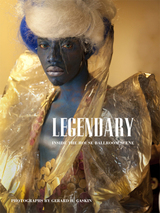 Legendary: Inside the House Ballroom Scene
Gerard H. Gaskin
Duke University Press Gerard H. Gaskin's radiant color and black-and-white photographs take us inside the culture of house balls, underground events where gay and transgender men and women, mostly African American and Latino, come together to see and be seen. At balls, high-spirited late-night pageants, members of particular "houses"—the House of Blahnik, the House of Xtravaganza—"walk," competing for trophies in categories based on costume, attitude, dance moves, and "realness." In this exuberant world of artistry and self-fashioning, people often marginalized for being who they are can flaunt and celebrate their most vibrant, spectacular selves. From the quiet backstage, to the shimmering energies of the runway. to the electricity of the crowd, Gaskin's photographs take us to the ball. Legendary, comprised of photos taken at events in the New York city area, Philadelphia, Richmond, and Washington, D.C., is a collaboration between Gaskin, a camera-laden outsider who has been attending balls for twenty years, and the house members who let him enter the intimate world of ball culture. In addition to an introduction by Deborah Willis, Legendary includes an essay, "The Queer Undercommons," by Frank Roberts.
Legendre Polynomials
George C. Clark and Stuart W. Churchill
University of Michigan Press, 1957 A research program on the engineering applications of light-scattering has been in progress in the Department of Chemical and Metallurgical Engineering of the University of Michigan. As part of this program it has been found necessary to compute various mathematical functions that occur in the Mie solution for the scattering of electromagnetic radiation by single spheres. The Legendre polynomials arise from many problems in mathematical physics, particularly from those involving the Laplace equation in spherical coordinates.
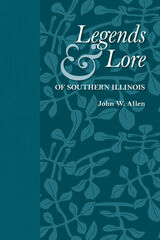 Legends and Lore of Southern Illinois
John W. Allen
Southern Illinois University Press, 1963 In the 1950s and ‘60s, John W. Allen told the people of southern Illinois about themselves—about their region, its history, and its folkways—in his series of newspaper articles, “It Happened in Southern Illinois.” Each installment of the series depicted a single item of interest—a town, a building, an enterprise, a person, an event, a custom. Originally published in 1963, Legends & Lore of Southern Illinois brings together a selection of these articles preserving a valuable body of significant local history and cultural lore. During territorial times and early statehood, southern Illinois was the most populous and most influential part of the state. But the advent of the steamboat and the building of the National Road made the lands to the west and north more easily accessible, and the later settlers struck out for the more expansive and fertile prairies. The effect of this movement was to isolate that section of the state known as Egypt and halt its development, creating what Allen termed “an historical eddy.” Bypassed as it was by the main current of westward expansion and economic growth, its culture changed very slowly. Methods, practices, and the tools of the pioneer continued in use for a long time. The improved highways and better means of communication of the twentieth century brought a marked change upon the region, and daily life no longer differed materially from that of other areas. Against such a cultural and historical backdrop, Mr. Allen wrote these sketches of the people of southern Illinois—of their folkways and beliefs, their endeavors, successes, failures, and tragedies, and of the land to which they came. There are stories here of slaves and their masters, criminals, wandering peddlers, politicians, law courts and vigilantes, and of boat races on the rivers. Allen also looks at the region’s earlier history, describing American Indian ruins, monuments, and artifacts as well as the native population’s encounters with European settlers. Many of the vestiges of the region’s past culture have all but disappeared, surviving only in museums and in the written record. This new paperback edition of Legends & Lore of Southern Illinois brings that past culture to life again in Allen’s descriptive, engaging style.
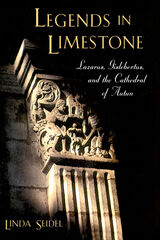 Legends in Limestone: Lazarus, Gislebertus, and the Cathedral of Autun
Linda Seidel
University of Chicago Press, 1999 Whereas twelfth-century pilgrims flocked to the church of St-Lazare in Autun to visit the relics of its patron saint, present-day pilgrims journey there to admire its superb sculpture, said to have been created by the artist Gislebertus whose name is inscribed above one of the church doors. These two cults, of sculptor and of saint, form points of departure and arrival for Linda Seidel's study.
Legends in Limestone reveals how "Gislebertus, sculptor" was discovered and subsequently sanctified over the course of the last century. Seidel makes a compelling case for the identification of the name with an ancestor of the local ducal family, invoked for his role in the acquisition of the precious relics. With the aid of evidence drawn from the richly carved decoration of the building, she demonstrates how medieval visitors would have read a different holy narrative in the church fabric, one that constructed before their eyes an account of their patron saint's life.
Legends in Limestone, an absorbing study of one of France's most revered medieval monuments, provides fresh insights into modern and medieval interpretive practices.
Legends of Paul Bunyan
Harold W. Felton
University of Minnesota Press, 2008 The collected lore of Minnesota's favorite lumberjack hero Paul Bunyan is a true American folk character, created in logging camp bunkhouses by men who spun exaggerated stories that combined hard work and fantasy. While the origins of Paul Bunyan and his sidekick Babe the Blue Ox are hazy, many storytellers have over the years contributed their own takes to produce an existing body of work--a true American legend--that matches the size of the lumberjack himself. Collected in colorful and engaging sections such as "Paul the Man," "Paul and the Animal Kingdom," and "The Wonderful Big Blue Ox, Babe," Legends of Paul Bunyan features more than thirty authors celebrating the largest lumberman, including stories by such Bunyan luminaries as James Stevens and W. B. Laughead, as well as such literary icons as Robert Frost and Carl Sandburg.
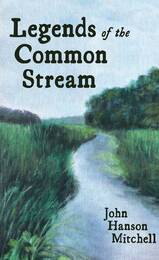 Legends of the Common Stream
John Hanson Mitchell
University of Massachusetts Press, 2021 For over twenty years, John Hanson Mitchell has visited Beaver Brook almost daily. This small, slow-flowing Massachusetts stream was of vital importance for early settlers and an indispensable resource for the Native peoples who lived and fished along its shores, but it has been largely forgotten in our own time. Revisiting the river's oxbows, bends, and marshes over the course of a year, Legends of the Common Stream combines a natural history of Beaver Brook with a study of the people who lived on this land and a meandering, but stunning, examination of the myths and legends that can help us to better understand humanity's relationship to the natural world.
While Mitchell never leaves the brook's shores, he draws from a range of traditions and takes readers on excursions to regions and cultures across the globe and across time, making the case that our contemporary separation from nature goes hand in hand with our alienation from the world of myth. This book seeks to restore these broken relationships and offers the reminder that while cultures may come and go, the stream goes on forever.
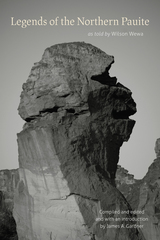 Legends of the Northern Paiute: as told by Wilson Wewa
Wilson Wewa
Oregon State University Press, 2017 Legends of the Northern Paiute shares and preserves twenty-one original and previously unpublished Northern Paiute legends, as told by Wilson Wewa, a spiritual leader and oral historian of the Warm Springs Paiute. These legends were originally told around the fires of Paiute camps and villages during the “story-telling season” of winter in the Great Basin of the American West. They were shared with Paiute communities as a way to pass on tribal visions of the “animal people” and the “human people,” their origins and values, their spiritual and natural environment, and their culture and daily lives.
The legends in this volume were recorded, transcribed, reviewed, and edited by Wilson Wewa and James Gardner. Each legend was recorded, then read and edited out loud, to respect the creativity, warmth, and flow of Paiute storytelling. The stories selected for inclusion include familiar characters from native legends, such as Coyote, as well as intriguing characters unique to the Northern Paiute, such as the creature embodied in the Smith Rock pinnacle, now known as Monkey Face, but known to the Paiutes in Central Oregon as Nuwuzoho the Cannibal.
Wewa’s apprenticeship to Northern Paiute culture began when he was about six years old. These legends were passed on to him by his grandmother and other tribal elders. They are now made available to future generations of tribal members, and to students, scholars, and readers interested in Wewa’s fresh and authentic voice. These legends are best read and appreciated as they were told—out loud, shared with others, and delivered with all of the verve, cadence, creativity, and humor of original Paiute storytellers on those clear, cold winter nights in the high desert.
Legends of the Slow Explosion: Eleven Modern Lives
Baron Wormser
Tupelo Press, 2018 Multi-genre literary master Baron Wormser’s new book is about people from the mid-twentieth century whose lives created ripple effects beyond their individuality. Including electrifying portraits of Rosa Parks, Hannah Arendt, Miles Davis, Audrey Hepburn, Willem de Kooning, among others, these are not conventional “biographical” essays. Wormser has created a molten, multi-dimensional prose that brings a reader into the visceral presence of these human catalysts.
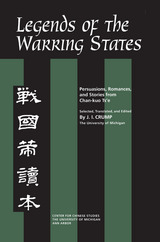 Legends of the Warring States: Persuasions, Romances, and Stories from Chan-kuo Ts'e
J. I. Crump
University of Michigan Press, 1998 The origins of the Chan-kuo Ts’e (Intrigues of the warring states) as an entity can be traced to a palace librarian at the Han Court, Liu Hsiang (76–6 BCE), who compiled and edited the pre-Han texts (c. 300–221 BCE) into a single volume and gave the collection a name. Thereafter, surviving manuscripts show the Chan-kuo Ts’e circulated during the Later Han Dynasty. Sometime during the years of decline and following the fall of the Han Dynasty, the Chan-kuo Ts’e began to acquire the aura of a wicked book, somewhat analogous to Niccolo Machiavelli’s The Prince. From time to time it was seen as one of a number of books that could unlock immense power in an era characterized both by widespread illiteracy and common belief in literacy and scholarship as the best if not the only vehicle to any goal. After 400 CE, there is no record of the text until it was reconstructed by an 11th-century scholar, Tseng Kung, who formed a model for critical circulation for the next nine centuries. This volume presents selections and commentary by the premier Western translator and interpreter of the Chan-kuo Ts'e—ninety pieces singled out for their literary sophistication and sprightliness of conception. It also features more complete warring states narratives, the “romances”—persuasions of four of the best-known figures, Fan Chü, Chang Yi, Su Ch'in, and Ch'un-shen Chün, augmented by biographical material from the Shi-chi. This reader highlights both the nature of Chan-kuo Ts'e, an important pre-Han collection, and its considerable pleasures.
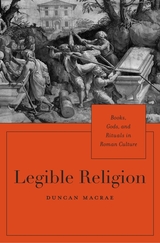 Legible Religion: Books, Gods, and Rituals in Roman Culture
Duncan MacRae
Harvard University Press, 2016 Scholars have long emphasized the importance of scripture in studying religion, tacitly separating a few privileged “religions of the Book” from faiths lacking sacred texts, including ancient Roman religion. Looking beyond this distinction, Duncan MacRae delves into Roman religious culture to grapple with a central question: what was the significance of books in a religion without scripture?
In the last two centuries BCE, Varro and other learned Roman authors wrote treatises on the nature of the Roman gods and the rituals devoted to them. Although these books were not sacred texts, they made Roman religion legible in ways analogous to scripture-based faiths such as Judaism and Christianity. Rather than reflect the astonishingly varied polytheistic practices of the regions under Roman sway, the contents of the books comprise Rome’s “civil theology”—not a description of an official state religion but one limited to the civic role of religion in Roman life. An extended comparison between Roman books and the Mishnah—an early Rabbinic compilation of Jewish practice and law—highlights the important role of nonscriptural texts in the demarcation of religious systems.
Tracing the subsequent influence of Roman religious texts from the late first century BCE to early fifth century CE, Legible Religion shows how two major developments—the establishment of the Roman imperial monarchy and the rise of the Christian Church—shaped the reception and interpretation of Roman civil theology.
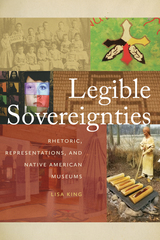 Legible Sovereignties: Rhetoric, Representations, and Native American Museums
Lisa King
Oregon State University Press, 2017 An interdisciplinary work that draws on the fields of rhetorical studies, Native American and Indigenous studies, and museum studies, Legible Sovereignties considers the creation, critical reception, and adaptation of Indigenous self-representation in three diverse Indigenously oriented or owned institutions.
King tracks the exhibit spaces at the Saginaw Chippewa Indian Tribe of Michigan’s Ziibiwing Center, Haskell Indian Nation University’s Cultural Center and Museum, and the Smithsonian’s Washington, DC branch of the National Museum of the American Indian over their first ten years, from their opening until the summer of 2014. Far from formulaic, each site has developed its own rhetorical approaches to reaching its public, revealing multiple challenges and successes in making Native self-representation legible and accessible.
Through documentation and analysis of the inaugural exhibits and recent installations, interviews with curators and staff, and investigation into audience reception of these spaces, Legible Sovereignties argues that there can be no single blanket solution for effective Indigenous self-representation. Instead, Legible Sovereignties demonstrates the nuanced ways in which each site must balance its rhetorical goals and its audience's needs, as well as its material constraints and opportunities, in order to reach its visitors and have Indigenous voices heard.
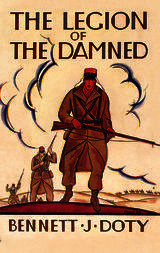 The Legion of the Damned: The Adventures of Bennett J. Doty in the French Foreign Legion as Told by Himself
Bennett J. Doty
Westholme Publishing, 2020 The Riveting Memoir of an American Volunteer in the French Foreign Legion during the 1925 Revolt in Syria
“You see there was down South a girl I liked. And she is now married . . . not to me.” So Bennett J. Doty confessed when he sailed for France and enlisted in the French Foreign Legion in 1924. A World War I veteran and University of Virginia student, Doty first trained in Morocco and Algeria before being shipped off to the French-controlled State of Syria. There, he and his fellow “bleus,” who hailed from Belgium, Poland, Italy, Senegal, Spain, Germany, Russia, and other countries, found themselves at the spearhead of the attempt to quell the revolt against French rule in the area. The fighting, mostly against the Druze, was fierce, merciless, and unrelenting. Fought in villages and at isolated outposts, there was no quarter. Entire villages were razed, fields destroyed, and prisoners were not taken by either side. In the engagement where Doty and several other of his “copains”—“buddies”—earned the Croix de Guerre, his unit became isolated and withstood days of attacks which claimed more than half of the Legionnaires until they were finally relieved by a French colonial column. With the immediate fighting over, the Legion was put to heavy manual labor under the hot desert sun. Doty became disillusioned, and with four other soldiers, fled in an attempt to reach British-controlled Jordan. They were caught, tried, and Doty was sentenced to eight years in a French prison. When word reached the United States, diplomatic efforts ultimately gained Doty a pardon and honorable discharge from service.
Originally published in 1928, Legion of the Damned, Doty’s acclaimed account of his time in the Legion, is a remarkable memoir that requires no additional drama to allow the reader to experience the desperation, exhilaration, fear, and disgust of a colonial war. Here, Doty shows how drunken, unruly, vicious veterans would transform into capable, cool, and orderly soldiers as soon as a battle began—the élan that earned the French Foreign Legion its reputation as a legendary fighting unit.
 Legions of Boom: Filipino American Mobile DJ Crews in the San Francisco Bay Area
Oliver Wang
Duke University Press, 2015 Armed with speakers, turntables, light systems, and records, Filipino American mobile DJ crews, such as Ultimate Creations, Spintronix, and Images, Inc., rocked dance floors throughout the San Francisco Bay Area from the late 1970s through the mid-1990s. In Legions of Boom noted music and pop culture writer and scholar Oliver Wang chronicles this remarkable scene that eventually became the cradle for turntablism. These crews, which were instrumental in helping to create and unify the Bay Area's Filipino American community, gave young men opportunities to assert their masculinity and gain social status. While crews regularly spun records for school dances, weddings, birthdays, or garage parties, the scene's centerpieces were showcases—or multi-crew performances—which drew crowds of hundreds, or even thousands. By the mid-1990s the scene was in decline, as single DJs became popular, recruitment to crews fell off, and aspiring scratch DJs branched off into their own scene. As the training ground for a generation of DJs, including DJ Q-Bert, Shortkut, and Mix Master Mike, the mobile scene left an indelible mark on its community that eventually grew to have a global impact.
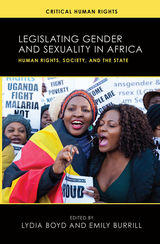 Legislating Gender and Sexuality in Africa: Human Rights, Society, and the State
Edited by Lydia Boyd and Emily Burrill
University of Wisconsin Press, 2020 In recent decades, a more formalized and forceful shift has emerged in the legislative realm when it comes to gender and sexual justice in Africa. This rigorous, timely volume brings together leading and rising scholars across disciplines to evaluate these ideological struggles and reconsider the modern history of human rights on the continent. Broad in geographic coverage and topical in scope, chapters investigate such subjects as marriage legislation in Mali, family violence experienced by West African refugees, sex education in Uganda, and statutes criminalizing homosexuality in Senegal. These case studies highlight the nuances and contradictions in the varied ways key actors make arguments for or against rights. They also explore how individual countries draft and implement laws that attempt to address the underlying problems.
Legislating Gender and Sexuality in Africa details how legal efforts in the continent can often be moralizing enterprises, illuminating how these processes are closely tied to notions of ethics, personhood, and citizenship. The contributors provide new appraisals of recent events, with fresh arguments about the relationships between local and global fights for rights. This interdisciplinary approach will appeal to scholars in African studies, anthropology, history, and gender studies.
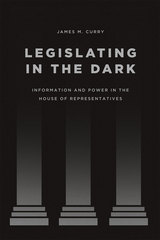 Legislating in the Dark: Information and Power in the House of Representatives
James M. Curry
University of Chicago Press, 2015 The 2009 financial stimulus bill ran to more than 1,100 pages, yet it wasn’t even given to Congress in its final form until thirteen hours before debate was set to begin, and it was passed twenty-eight hours later. How are representatives expected to digest so much information in such a short time.
The answer? They aren’t. With Legislating in the Dark, James M. Curry reveals that the availability of information about legislation is a key tool through which Congressional leadership exercises power. Through a deft mix of legislative analysis, interviews, and participant observation, Curry shows how congresspersons—lacking the time and resources to study bills deeply themselves—are forced to rely on information and cues from their leadership. By controlling their rank-and-file’s access to information, Congressional leaders are able to emphasize or bury particular items, exploiting their information advantage to push the legislative agenda in directions that they and their party prefer.
Offering an unexpected new way of thinking about party power and influence, Legislating in the Dark will spark substantial debate in political science.
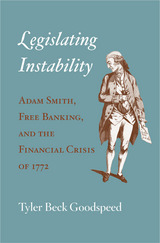 Legislating Instability: Adam Smith, Free Banking, and the Financial Crisis of 1772
Tyler Beck Goodspeed
Harvard University Press, 2016 From 1716 to 1845, Scotland’s banks were among the most dynamic and resilient in Europe, effectively absorbing a series of adverse economic shocks that rocked financial markets in London and on the continent. Legislating Instability explains the seeming paradox that the Scottish banking system achieved this success without the government controls usually considered necessary for economic stability.
Eighteenth-century Scottish banks operated in a regulatory vacuum: no central bank to act as lender of last resort, no monopoly on issuing currency, no legal requirements for maintaining capital reserves, and no formal limits on bank size. These conditions produced a remarkably robust banking system, one that was intensely competitive and served as a prime engine of Scottish economic growth. Despite indicators that might have seemed red flags—large speculative capital flows, a fixed exchange rate, and substantial external debt—Scotland successfully navigated two severe financial crises during the Seven Years’ War.
The exception was a severe financial crisis in 1772, seven years after the imposition of the first regulations on Scottish banking—the result of aggressive lobbying by large banks seeking to weed out competition. While these restrictions did not cause the 1772 crisis, Tyler Beck Goodspeed argues, they critically undermined the flexibility and resilience previously exhibited by Scottish finance, thereby elevating the risk that another adverse economic shock, such as occurred in 1772, might threaten financial stability more broadly. Far from revealing the shortcomings of unregulated banking, as Adam Smith claimed, the 1772 crisis exposed the risks of ill-conceived bank regulation.
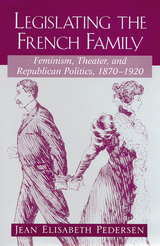 Legislating the French Family: Feminism, Theater, and Republican Politics: 1870-1920
Jean Elisabeth Pedersen
Rutgers University Press, 2003 Legislating the French Family examines family law reform in France from the foundation of the Third Republic in 1870 to the aftermath of World War I in 1920. Combining literary and historical approaches, Jean Elisabeth Pedersen provides a unique perspective on the political culture of modern France, analyzing French "problem" plays and their reception both as a measure of public opinion and as a force for social change. This new approach reveals the complex cultural narratives within, against, and in spite of which feminists, journalists, medical experts, playwrights, and politicians contended. Pedersen’s work demonstrates how republican political debates over divorce, illegitimacy, abortion, and birth control both provoked and responded to larger arguments about the meanings of French citizenship, national identity, and imperial expansion. She argues that these debates complicated the idea of French citizenship, exposed the myth of the supposedly ungendered individual citizen, and reveal to us the intricate intersections among conflicts over family law, sexual politics, class structure, religious belief, republican citizenship, national identity, and imperial policy.
Legislating Together: The White House and Capitol Hill from Eisenhower to Reagan
Mark A. Peterson
Harvard University Press, 1990 Mark Peterson investigates how recent presidents have engaged Congress on domestic policy issues. Rejecting the presidency-centered perspective on national government that is so firmly rooted in the popular imagination, he argues in this sophisticated analysis that the response of Congress to presidential initiatives is often far more cooperative than the presidency-centered perspective suggests.
 Legislative Advocacy and Public Policy Work for Academic and Research Library Workers: Perspectives and Strategies
Raymond Pun
Association of College & Research Libraries, 2025 Library advocacy is a deliberate, planned, and sustained effort to develop understanding and support for libraries and the communities they serve. Advocacy is not optional—it is a vital responsibility to protect the integrity and impact of libraries in society.
Legislative Advocacy and Public Policy Work for Academic and Research Library Workers is a comprehensive resource addressing our specific roles in influencing the various legislative and public policies that directly impact academic libraries, our academic communities, and the library community at large. It explores the ways academic and research library workers are engaging in advocacy, from testifying at governmental levels to collaborating with diverse constituents and legislators to bringing our academic advocacy efforts to discussions within state and regional library associations.
As educators and researchers, library workers bring invaluable expertise to the legislative table. We can help ensure that decisions affecting academic and research libraries and their communities are informed, equitable, and aligned with the values of intellectual freedom and lifelong learning. Legislative Advocacy and Public Policy Work for Academic and Research Library Workers offers ways to make meaningful legislative and policy impacts.
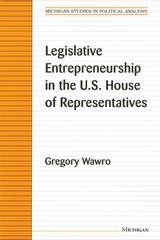 Legislative Entrepreneurship in the U.S. House of Representatives
Gregory Wawro
University of Michigan Press, 2001 When members are elected to the House of Representatives they have a certain freedom to decide how they will act as members and how they will build their reputations. Just as in the market place entrepreneurs build businesses, so in the House of Representatives members have the freedom to choose to build legislative programs that will enhance their reputations in the institution. And yet entrepreneurship is also costly to members. Gregory Wawro explains why members of the House engage in legislative entrepreneurship by examining what motivates them to acquire policy knowledge, draft legislation, build coalitions, and push their legislation in the House. He considers what incentives members have to perform what many have perceived to be the difficult and unrewarding tasks of legislating.
This book shows how becoming a legislative entrepreneur relates to members' goals of reelection, enacting good public policy, and obtaining influence in the House. The analysis differs from previous studies of this behavior, which for the most part have employed case study methods and have relied on anecdotal evidence to support their arguments. Wawro analyzes legislative entrepreneurship in a general and systematic fashion, developing hypotheses from rational-choice-based theories and testing these hypotheses using quantitative methods.
Wawro argues that members engage in legislative entrepreneurship in order to get ahead within the House. He finds that the more legislative entrepreneurship that members engage in, the more likely it is that they will advance to prestigious positions.
This book is of interest to students of Congress, legislative behavior and institutions, elections, and campaign finance.
Gregory Wawro is Assistant Professor of Political Science, Columbia University.
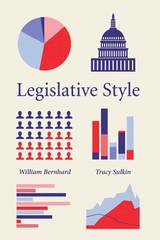 Legislative Style
William Bernhard and Tracy Sulkin
University of Chicago Press, 2018 Once elected, members of Congress face difficult decisions about how to allocate their time and effort. On which issues should they focus? What is the right balance between working in one’s district and on Capitol Hill? How much should they engage with the media to cultivate a national reputation? William Bernhard and Tracy Sulkin argue that these decisions and others define a “legislative style” that aligns with a legislator’s ambitions, experiences, and personal inclinations, as well as any significant electoral and institutional constraints.
Bernhard and Sulkin have developed a systematic approach for looking at legislative style through a variety of criteria, including the number of the bills passed, number of speeches given, amount of money raised, and the percentage of time a legislator voted in line with his or her party. Applying this to ten congresses, representing twenty years of congressional data, from 1989 to 2009, they reveal that legislators’ activity falls within five predictable styles. These styles remain relatively consistent throughout legislators’ time in office, though a legislator’s style can change as career goals evolve, as well as with changes to individual or larger political interests, as in redistricting or a majority shift. Offering insight into a number of enduring questions in legislative politics, Legislative Style is a rich and nuanced account of legislators’ activity on Capitol Hill.
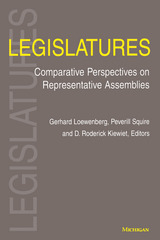 Legislatures: Comparative Perspectives on Representative Assemblies
Gerhard Loewenberg, Peverill Squire, and D. Roderick Kiewiet, Editors
University of Michigan Press, 2002 Although a great deal is known about the United States Congress, the differences and similarities between it and the legislatures and parliaments of other countries have not been extensively studied. This book--by a distinguished group of legislative specialists from ten countries--fills this gap by presenting legislative research from a comparative, cross-national perspective.
Consisting of fourteen essays, this volume incorporates major areas of legislative research, including studies of recruitment of legislators and an overview of their careers, the evolution of legislatures, and the electoral systems by which legislatures are chosen. Each contributor reviews the principal research findings and emphasizes those concepts and methods that facilitate comparative research. The book assesses the state of knowledge in regard to U.S., European, Asian, and Latin American legislatures. The introductory chapter by the editors identifies how to comparatively test research findings while taking into account data availability and questions of conceptual equivalence. Each chapter provides an extensive bibliography, making the book an excellent guide to literature on legislative research. The contributors are David T. Canon, John M. Carey, Gary W. Cox, Frantisek Formanek, John R. Hibbing, Ewa Karpowicz, Junko Kato, Sadafumi Kawato, Michael Laver, Gary F. Moncrief, Chan Wook Park, Werner J. Patzelt, Bjorn Erik Rasch, Kenneth A. Shepsle, Steven S. Smith, and Rick K. Wilson.
This book is designed for faculty and graduate students in political science and will also be of interest to members of legislative research staffs in this country and overseas, and to specialists on legislatures in history and law.
Gerhard Loewenberg is University of Iowa Foundation Distinguished Professor of Political Science. D. Roderick Kiewiet is Dean of Graduate Studies and Professor of Political Science, California Institute of Technology, Pasadena. Peverill Squire is Professor of Political Science, University of Iowa.
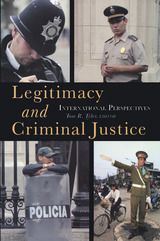 Legitimacy and Criminal Justice: An International Perspective
Tom R. Tyler
Russell Sage Foundation, 2007 The police and the courts depend on the cooperation of communities to keep order. But large numbers of urban poor distrust law enforcement officials. Legitimacy and Criminal Justice explores the reasons that legal authorities are or are not seen as legitimate and trustworthy by many citizens. Legitimacy and Criminal Justice is the first study of the perceived legitimacy of legal institutions outside the U.S. The authors investigate relations between courts, the police, and communities in the U.K., Western Europe, South Africa, Slovenia, South America, and Mexico, demonstrating the importance of social context in shaping those relations. Gorazd Meško and Goran Klemencic examine Slovenia's adoption of Western-style "community policing" during its transition to democracy. In the context of Slovenia's recent Communist past—when "community policing" entailed omnipresent social and political control—citizens regarded these efforts with great suspicion, and offered little cooperation to the police. When states fail to control crime, informal methods of law can gain legitimacy. Jennifer Johnson discusses an extra-legal policing system carried out by farmers in Guerrero, Mexico—complete with sentencing guidelines and initiatives to reintegrate offenders into the community. Feeling that federal authorities were not prosecuting the crimes that plagued their province, the citizens of Guerrero strongly supported this extra-legal arrangement, and engaged in massive protests when the central government tried to suppress it. Several of the authors examine how the perceived legitimacy of the police and courts varies across social groups. Graziella Da Silva, Ignacio Cano, and Hugo Frühling show that attitudes toward the police vary greatly across social classes in harshly unequal societies like Brazil and Chile. And many of the authors find that ethnic minorities often display greater distrust toward the police, and perceive themselves to be targets of police discrimination. Indeed, Hans-Jöerg Albrecht finds evidence of bias in arrests of the foreign born in Germany, which has fueled discontent among Berlin's Turkish youth. Sophie Body-Gendrot points out that mutual hostility between police and minority communities can lead to large-scale violence, as the Parisian banlieu riots underscored. The case studies presented in this important new book show that fostering cooperation between law enforcement and communities requires the former to pay careful attention to the needs and attitudes of the latter. Forging a new field of comparative research, Legitimacy and Criminal Justice brings to light many of the reasons the law's representatives succeed—or fail—in winning citizens' hearts and minds. A Volume in the Russell Sage Foundation Series on Trust
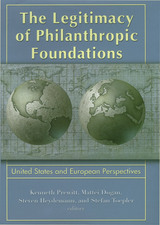 Legitimacy of Philanthropic Foundations: United States and European Perspectives
Kenneth Prewitt
Russell Sage Foundation, 2006 Though privately controlled, foundations perform essential roles that serve society at large. They spearhead some of the world's largest and most innovative initiatives in science, health, education, and the arts, fulfilling important needs that could not be addressed adequately in the marketplace or the public sector. Still, many people have little understanding of what foundations do and how they continue to earn public endorsement. The Legitimacy of Philanthropic Foundations provides a thorough examination of why foundations exist and the varied purposes they serve in contemporary democratic societies. The Legitimacy of Philanthropic Foundations looks at foundations in the United States and Europe to examine their relationship to the state, the market, and civil society. Peter Frumkin argues that unlike elected officials, who must often shy away from topics that could spark political opposition, and corporate officers, who must meet bottom-line priorities, foundations can independently tackle sensitive issues of public importance. Kenneth Prewitt argues that foundations embody elements of classical liberalism, such as individual autonomy and limited government interference in private matters and achieve legitimacy by putting private wealth to work for the public good. Others argue that foundations achieve legitimacy by redistributing wealth from the pockets of rich philanthropists to the poor. But Julian Wolpert finds that foundations do not redistribute money directly to the poor as much as many people believe. Instead, many foundations focus their efforts on education, health, and scientific research, making investments that benefit society in the long-term, and focusing on farsighted issues that a myopic electorate would not have patience to permit its government to address. Originating from private fortunes but working for the public good, independently managed but subject to legal prescriptions, philanthropic foundations occupy a unique space somewhere between the public and private sectors. The Legitimacy of Philanthropic Foundations places foundations in a broad social and historical context, improving our understanding of one of society's most influential—and least understood—organizational forms.
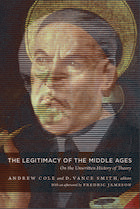 The Legitimacy of the Middle Ages: On the Unwritten History of Theory
Andrew Cole and D. Vance Smith, eds.
Duke University Press, 2010 This collection of essays argues that any valid theory of the modern should—indeed must—reckon with the medieval. Offering a much-needed correction to theorists such as Hans Blumenberg, who in his Legitimacy of the Modern Age describes the "modern age" as a complete departure from the Middle Ages, these essays forcefully show that thinkers from Adorno to Žižek have repeatedly drawn from medieval sources to theorize modernity. To forget the medieval, or to discount its continued effect on contemporary thought, is to neglect the responsibilities of periodization. In The Legitimacy of the Middle Ages, modernists and medievalists, as well as scholars specializing in eighteenth-, nineteenth-, and twentieth-century comparative literature, offer a new history of theory and philosophy through essays on secularization and periodization, Marx’s (medieval) theory of commodity fetishism, Heidegger’s scholasticism, and Adorno’s nominalist aesthetics. One essay illustrates the workings of medieval mysticism in the writing of Freud’s most famous patient, Daniel Paul Schreber, author of Memoirs of My Nervous Illness (1903). Another looks at Michael Hardt and Antonio Negri’s Empire, a theoretical synthesis whose conscientious medievalism was the subject of much polemic in the post-9/11 era, a time in which premodernity itself was perceived as a threat to western values. The collection concludes with an afterword by Fredric Jameson, a theorist of postmodernism who has engaged with the medieval throughout his career. Contributors: Charles D. Blanton, Andrew Cole, Kathleen Davis, Michael Hardt, Bruce Holsinger, Fredric Jameson, Ethan Knapp, Erin Labbie, Jed Rasula, D. Vance Smith, Michael Uebel
 Legitimacy: The Right to Rule in a Wanton World
Arthur Isak Applbaum
Harvard University Press, 2019 At an unsettled time for liberal democracy, with global eruptions of authoritarian and arbitrary rule, here is one of the first full-fledged philosophical accounts of what makes governments legitimate.
What makes a government legitimate? The dominant view is that public officials have the right to rule us, even if they are unfair or unfit, as long as they gain power through procedures traceable to the consent of the governed. In this rigorous and timely study, Arthur Isak Applbaum argues that adherence to procedure is not enough: even a properly chosen government does not rule legitimately if it fails to protect basic rights, to treat its citizens as political equals, or to act coherently.
How are we to reconcile every person’s entitlement to freedom with the necessity of coercive law? Applbaum’s answer is that a government legitimately governs its citizens only if the government is a free group agent constituted by free citizens. To be a such a group agent, a government must uphold three principles. The liberty principle, requiring that the basic rights of citizens be secured, is necessary to protect against inhumanity, a tyranny in practice. The equality principle, requiring that citizens have equal say in selecting who governs, is necessary to protect against despotism, a tyranny in title. The agency principle, requiring that a government’s actions reflect its decisions and its decisions reflect its reasons, is necessary to protect against wantonism, a tyranny of unreason.
Today, Applbaum writes, the greatest threat to the established democracies is neither inhumanity nor despotism but wantonism, the domination of citizens by incoherent, inconstant, and incontinent rulers. A government that cannot govern itself cannot legitimately govern others.
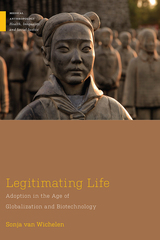 Legitimating Life: Adoption in the Age of Globalization and Biotechnology
van Wichelen, Sonja
Rutgers University Press, 2019 The phenomenon of transnational adoption is changing in the age of globalization and biotechnology. In Legitimating Life, Sonja van Wichelen boldly describes how contemporary justifications of cross-border adoption navigate between child welfare, humanitarianism, family making, capitalism, science, and health. Focusing on contemporary institutional practices of adoption in the United States and the Netherlands, she traces how professionals, bureaucrats, lawyers, politicians, social workers, and experts legitimate a practice that became progressively controversial. Throughout the past few decades transnational adoption transformed from a humanitarian response to a means of making family. In this new manifestation, life becomes necessarily economized. While push and pull factors, demand and supply dynamics, and competition between agencies set the stage for the globalization of adoption, international conventions, scientific knowledge, and the language of human rights universalized the phenomenon. Van Wichelen argues that such technoscientific legitimations of a globalizing practice are rearticulating colonial logics of race and civilization. Yet, she also lets us see beyond the biopolitical project and into alternative ways of making kin.
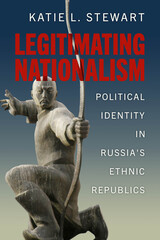 Legitimating Nationalism: Political Identity in Russia's Ethnic Republics
Katie L. Stewart
University of Wisconsin Press, 2024 Russia is a large, diverse, and complicated country whose far-flung regions maintain their own histories and cultures, even as President Vladimir Putin increases his political control. Powerful, autocratic regimes still need to establish their legitimacy; in Russia, as elsewhere, developing a compelling national narrative and building a sense of pride and belonging in a national identity is key to maintaining a united nation. It can also legitimate political power when leaders present themselves as the nation’s champions. Putin’s hold thus requires effective nation building— propagating the ever-evolving and often contested story of who, exactly, is Russian and what, exactly, that means.
Even in the current autocratic system, however, Russia’s multiethnic nature and fractured political history mean that not all political symbols work the same way everywhere; not every story finds the same audience in the same way. The message may emanate from Moscow, but regional actors—including local governments, civic organizations, and cultural institutions—have some agency in how they spread the message: some regionalization of identity work is permitted to ensure that Russian national symbols and narratives resonate with people, and to avoid protest. This book investigates how nation building works on the ground through close studies of three of Russia’s ethnic republics: Karelia, Tatarstan, and Buryatia. Understanding how the project of legitimating nationalism, in support of a unified country and specifically Putin’s regime, works in practice offers crucial context in understanding the shape and story of contemporary Russia.
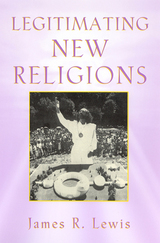 Legitimating New Religions
Lewis, James R
Rutgers University Press, 2003 James R. Lewis has written the first book to deal explicitly with the issue of how emerging religions legitimate themselves. He contends that a new religion has at least four different, though overlapping, areas where legitimacy is a concern: making converts, maintaining followers, shaping public opinion, and appeasing government authorities. The legitimacy that new religions seek in the public realm is primarily that of social acceptance. Mainstream society's acknowledgement of a religion as legitimate means recognizing its status as a genuine religion and thus recognizing its right to exist. Through a series of wide-ranging case studies Lewis explores the diversification of legitimation strategies of new religions as well the tactics that their critics use to de-legitimate such groups. Cases include the Movement for Spiritual Inner Awareness, Native American prophet religions, spiritualism, the Church of Christ-Scientist, Scientology, Church of Satan, Heaven's Gate, Unitarianism, Hindu reform movements, and Soka Gakkai, a new Buddhist sect. Since many of the issues raised with respect to newer religions can be extended to the legitimation strategies deployed by established religions, this book sheds an intriguing new light on classic questions about the origin of all religions.
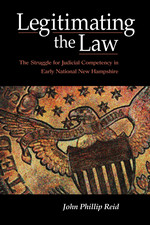 Legitimating the Law: The Struggle for Judicial Competency in Early National New Hampshire
John Phillip Reid
Northern Illinois University Press, 2011
John Phillip Reid is one of the most highly regarded historians of law as it was practiced on the state level in the nascent United States. He is not just the recipient of numerous honors for his scholarship but the type of historian after whom such accolades are named: the John Phillip Reid Award is given annually by the American Society for Legal History to the author of the best book by a mid-career or senior scholar. Legitimating the Law is the third installment in a trilogy of books by Reid that seek to extend our knowledge about the judicial history of the early republic by recounting the development of courts, laws, and legal theory in New Hampshire.
Here Reid turns his eye toward the professionalization of law and the legitimization of legal practices in the Granite State—customs and codes of professional conduct that would form the basis of judiciaries in other states and that remain the cornerstone of our legal system to this day throughout the U.S. Legitimating the Law chronicles the struggle by which lawyers and torchbearers of strong, centralized government sought to bring standards of competence to New Hampshire through the professionalization of the bench and the bar—ambitions that were fought vigorously by both Jeffersonian legislators and anti-Federalists in the private sector alike, but ultimately to no avail.
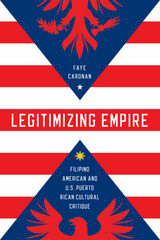 Legitimizing Empire: Filipino American and U.S. Puerto Rican Cultural Critique
Faye Caronan
University of Illinois Press, 2015 When the United States acquired the Philippines and Puerto Rico, it reconciled its status as an empire with its anticolonial roots by claiming that it would altruistically establish democratic institutions in its new colonies. Ever since, Filipino and Puerto Rican artists have challenged promises of benevolent assimilation and portray U.S. imperialism as both self-interested and unexceptional among empires.
Faye Caronan's examination interprets the pivotal engagement of novels, films, performance poetry, and other cultural productions as both symptoms of and resistance against American military, social, economic, and political incursions. Though the Philippines became an independent nation and Puerto Rico a U.S. commonwealth, both remain subordinate to the United States. Caronan's juxtaposition reveals two different yet simultaneous models of U.S. neocolonial power and contradicts American exceptionalism as a reluctant empire that only accepts colonies for the benefit of the colonized and global welfare. Her analysis, meanwhile, demonstrates how popular culture allows for alternative narratives of U.S. imperialism, but also functions to contain those alternatives.
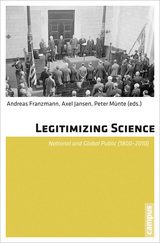 Legitimizing Science: National and Global Public (1800-2010)
Edited by Axel Jansen, Andreas Franzmann, and Peter Münte
Campus Verlag, 2015 Since the founding in 1660 of the Royal Society, London, scientists engaging in experimental research have sought to establish a base for exploratory work in communities and their political institutions. This connection between science and the national state has only grown stronger during the past two centuries. Here, historians, sociologists, and jurists discuss the history of that relationship since 1800, asking such key questions as how have scientists conceived of the national setting for their transnational work in the past, and how do they situate their work in the context of globalization? Taken together, the essays reveal that while nineteenth-century scientists in many countries felt they had to fight for public recognition of their work, the twentieth century witnessed the national endorsement and planning of science. With essays ranging from an analysis of speeches by nineteenth-century German university presidents to the state of science in the context of European integration, this book will appeal to anyone interested in the public and political role of science and its institutions in the past, present, and future.
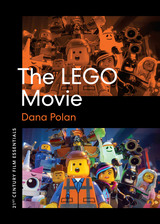 The LEGO Movie
By Dana Polan
University of Texas Press, 2020 What happens when we set out to understand LEGO not just as a physical object but as an idea, an icon of modernity, an image—maybe even a moving image? To what extent can the LEGO brick fit into the multimedia landscape of popular culture, especially film culture, today? Launching from these questions, Dana Polan traces LEGO from thing to film and asserts that The LEGO Movie is an exemplar of key directions in mainstream cinema, combining the visceral impact of effects and spectacle with ironic self-awareness and savvy critique of mass culture as it reaches for new heights of creativity. Incorporating insights from conversations with producer Dan Lin and writer-directors Phil Lord and Chris Miller, Polan examines the production and reception of The LEGO Movie and closely analyzes the film within popular culture at large and in relation to LEGO as a toy and commodity. He identifies the film’s particular stylistic and narrative qualities, its grasp of and response to the culture industry, and what makes it a distinctive work of animation within the seeming omnipresence of animation in Hollywood, and reveals why the blockbuster film, in all its silliness and seriousness, stands apart as a divergent cultural work.
Legumes of Africa: a checklist
J. M. Lock
Royal Botanic Gardens, Kew, 2000 Comprehensive checklist, with code abbreviations for characteristics, habitat and distribution. Notes of economic use are included where applicable.
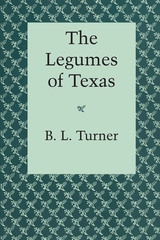 The Legumes of Texas
By B. L. Turner
University of Texas Press, 1959 Legumes have taken an important place as a commercial crop in Texas. Their soil-building qualities have long been recognized, and the production of legume seed became a growing business. In addition, considerable interest arose as to the possibility of breeding and selection of native legumes for the development of suitable types to occupy the thousands of miles of rangeland in the southwestern United States. While much experimental work went into the production of exotic cultivated crops such as clover, alfalfa, and vetch, when this book was published in 1959, practically nothing was known about the potential value and volume of crop for native Texas legumes. This is a scientific book—a book of interest primarily to professional workers in the field of taxonomy and agronomy—but its use as a guide to potential crop and rangeland legumes should prove of importance to many people who have no primary interest in systematics. It includes a treatment of both native and introduced Texas legumes, with keys to species, ecological notes, flowering dates, common names, and synonymy. Distribution of taxa is shown by dot maps and, when appropriate, extra-limital observations are added. Chromosome numbers are given for those species for which counts were available. This information includes unpublished data for approximately 50 taxa; in addition, comments as to the agronomic potential of certain native legumes are presented. The introduction includes an original account of the major floristic provinces of the state based on correlated distributions of the legume species. Altogether the text treats 391 legume taxa, 347 of which are native.
Legumes of West Asia: a checklist
J. M. Lock and K. Simpson
Royal Botanic Gardens, Kew, 2000 Systematic listing by family, genus and species; each species with brief distribution notes and bibliographical references for detailed descriptions and illustrations.
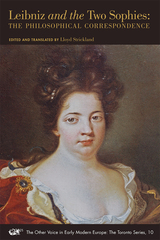 Leibniz and the Two Sophies: The Philosophical Correspondence
Gottfried Wilhelm Leibniz, Sophie Electress of Hanover, Queen Sophie Charlotte of Prussia
Iter Press, 2011 In his introduction, Lloyd Strickland proposes that Sophie, Electress of Hanover, and her daughter, Queen Sophie Charlotte of Prussia, found consolation in the idea of divine justice. Too long themselves unfairly dismissed as philosophical lightweights, proper justice may now be given to their views through this edition of their private correspondences with Leibniz. Appearing for the first time in English translation, the philosophical selections cover topics from the nature of substance to universal salvation and evidence the independence of the women’s thought as they defend materialism and challenge Leibniz’s conviction that God created the best possible world. The edition also boasts copious and highly informative editorial notes. It is a most welcome addition to The Other Voice in Early Modern Europe: Toronto series.
Leibniz: Critical and Interpretive Essays
Michael Hooker, Editor
University of Minnesota Press, 1982 Leibniz was first published in 1982. Minnesota Archive Editions uses digital technology to make long-unavailable books once again accessible, and are published unaltered from the original University of Minnesota Press editions. The past fifteen years have witnessed a renaissance in the study of the history of philosophy, with special attention devoted to the seventeenth century and the work of Descartes and Leibniz. The essays in this collection open new pathways to the study of Leibniz, and will be welcomed not only by historians of philosophy but also by those contemporary philosophers who use logic and the philosophy of language to address metaphysical questions — since Leibniz was the first philosopher to do just that.
 Leibniz' Universal Jurisprudence: Justice as the Charity of the Wise
Patrick Riley
Harvard University Press, 1996 Although Leibniz is universally regarded as the greatest German philosopher before Kant, his work as a political and moral philosopher is almost entirely neglected in the English-speaking world, where he is seen chiefly as a metaphysician, mathematical logician, and co-discoverer of calculus. Yet Leibniz' doctoral degree was in law and jurisprudence, and he served throughout his life as a judge and a diplomat; he was a valued political--legal adviser to Czar Peter the Great, to the King of Prussia in Berlin, and to the Holy Roman Emperor in Vienna. Patrick Riley recovers this crucial part of Leibniz' thought and activity.
For the first time--as we celebrate the 350th anniversary of Leibniz' birth--his political, moral, and legal thought are extensively discussed here in English. The text includes fragments of his work that have never before been translated. Riley shows that "justice as wise charity" has at least as much claim to be taken seriously as the familiar contractarian ideas of Hobbes and Locke. Since Leibniz was the greatest Platonist of early modernity, Riley argues, his version of Platonic idealism serves as the bridge from Plato himself to the greatest modern "critical" idealist, Kant. With Leibniz' Universal Jurisprudence we now have a fuller picture of one of the greatest general thinkers of the seventeenth century.
 The Leiden Wigalois Manuscript: Introduction and full transcript
Jef Jacobs
Leiden University Press, 2025 "For around 150 years, the richly illustrated Wigalois manuscript from Amelungsborn Abbey in Germany has rested largely unnoticed in the collections of Leiden University Library. Only recently has this unique codex, known as LTK 537, begun to attract the scholarly attention it deserves. This volume offers the first full transcription of the manuscript's Middle High German text, accompanied by an accessible introduction and detailed commentary. In combining textual accuracy with contextual depth, the editors aim to open up this fascinating work to a wider international audience. Commissioned in 1372 by Count Albrecht II of Braunschweig-Grubenhagen, and produced by a Cistercian monk in Amelungsborn Abbey, the manuscript presents an exceptional interplay of text and image. With no fewer than forty-nine vividly coloured miniatures, it stands as a jewel of German Arthurian literature. The story of Wigalois, son of Gawain, unfolds as a continuous sequence of chivalric adventures, culminating in the liberation of a kingdom and a royal marriage. The manuscript’s artistic and rhetorical richness, from its opening Tree of Paradise to its expressive banderoles, reflects the creative collaboration between scribe and illuminator — and the enduring appeal of medieval romance."
 Leigh Bowery: Performative Costuming and Live Art
Sofia Vranou
Intellect Books, 2025 A deep dive into the practice of performance artist Leigh Bowery that reveals the fullness of his extravagant range.
Leigh Bowery: Performative Costuming and Live Art is a critical exploration of the creative practice, social-historical context, and cultural impact of the late London-based artist Leigh Bowery. The diversity of Bowery’s work and his marginality as an artist who emerged during the 1980s from a subcultural milieu complicated and thwarted his cultural value, hindering his incorporation into art institutions and performance art narratives for some time. Drawing on a variety of disciplines and challenging research contexts, Sofia Vranou seeks to historicize Bowery’s multifaceted body of work and critically situate it within the expanded fields of visual culture and performance studies.
Through close analysis of Bowery’s key looks and non-theatrical performances, the book investigates the implications of his work in dominant histories of performance art and urgent discourses surrounding normativity, representations of illness, and identity politics. Thought-provoking and engaging, it focuses on Bowery’s costuming as a performative strategy that effectively blurs the boundaries between art and life; delves into his aesthetics of freakishness and narcissistic desire, reflects on his involvement with BDSM practices and the performance of extremity, and unpacks the posttranssexual ethos behind his hybrid embodiments and trans-queer visual language.
 Leila Khaled: Icon of Palestinian Liberation
Sarah Irving
Pluto Press, 2012 Dubbed 'the poster girl of Palestinian militancy', Leila Khaled's image flashed across the world after she hijacked a passenger jet in 1969. The picture of a young, determined looking woman with a checkered scarf, clutching an AK-47, was as era-defining as that of Che Guevara.
In this intimate profile, based on interviews with Khaled and those who know her, Sarah Irving gives us the life-story behind the image. Key moments of Khaled's turbulent life are explored, including the dramatic events of the hijackings, her involvement in the Marxist Popular Front for the Liberation of Palestine (a radical element within the PLO), her opposition to the Oslo peace process and her activism today.
Leila Khaled's example gives unique insights into the Palestinian struggle through one remarkable life – from the tension between armed and political struggle, to the decline of the secular left and the rise of Hamas, and the role of women in a largely male movement.
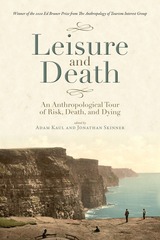 Leisure and Death: An Anthropological Tour of Risk, Death, and Dying
Adam Kaul
University Press of Colorado, 2018 This anthropological study examines the relationship between leisure and death, specifically how leisure practices are used to meditate upon—and mediate—life. Considering travelers who seek enjoyment but encounter death and dying, tourists who accidentally face their own mortality while vacationing, those who intentionally seek out pleasure activities that pertain to mortality and risk, and those who use everyday leisure practices like social media or dogwalking to cope with death, Leisure and Death delves into one of the most provocative subsets of contemporary cultural anthropology. These nuanced and well-developed ethnographic case studies deal with different and distinct examples of the intertwining of leisure and death. They challenge established conceptions of leisure and rethink the associations attached to the prospect of death. Chapters testify to encounters with death on a personal and scholarly level, exploring, for example, the Cliffs of Moher as not only one of the most popular tourist destinations in Ireland but one of the most well-known suicide destinations as well, and the estimated 30 million active posthumous Facebook profiles being repurposed through proxy users and transformed by continued engagement with the living. From the respectful to the fascinated, from the macabre to the morbid, contributors consider how people deliberately, or unexpectedly, negotiate the borderlands of the living. An engaging, timely book that explores how spaces of death can be transformed into spaces of leisure, Leisure and Death makes a significant contribution to the burgeoning interdisciplinary literature on leisure studies and dark tourism. This book will appeal to students, scholars, and laypeople interested in tourism studies, death studies, cultural studies, heritage studies, anthropology, sociology, and marketing. Contributors: Kathleen M. Adams, Michael Arnold, Jane Desmond, Keith Egan, Maribeth Erb, James Fernandez, Martin Gibbs, Rachel Horner-Brackett, Shingo Iitaka, Tamara Kohn, Patrick Laviolette, Ruth McManus, James Meese, Bjorn Nansen, Stravoula Pipyrou, Hannah Rumble, Cyril Schafer
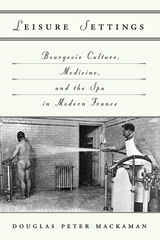 Leisure Settings: Bourgeois Culture, Medicine, and the Spa in Modern France
Douglas P. Mackaman
University of Chicago Press, 1998 The artful use of one's free time was a discipline perfected by the French in the nineteenth century. Casinos, alpine hiking, hotel dinners, romantic gardens, and lavish parks were all part of France's growing desire for the ideal vacation. Perhaps the most intriguing vacation, however, was the ever popular health resort, and this is the main topic of Douglas Mackaman's fascinating study.
Taking us into the vibrant social world of France's great spas, Mackaman explores the links between class identity and vacationing. Mackaman shows how, after 1800, physicians and entrepreneurs zealously tried to break their milieu's strong association with aristocratic excess and indecency by promoting spas as a rational, ordered equivalent to the busy lives of the bourgeoisie. Rather than seeing leisure time as slothful, Mackaman argues, the bourgeoisie willingly became patients at spas and viewed this therapeutic vacation as a sensible, even productive, way of spending time. Mackaman analyzes this transformation, and ultimately shows how the premier vacation of an era made and was made by the bourgeoisie.
The Lemon Grove: A Novel
Ali Hosseini
Northwestern University Press, 2012 Identical twins Ruzbeh and Behruz are at the center of Ali Hosseini’s debut novel in English--a story about love, redemption, and the courage to survive in the face of calamity and loss. The novel begins in the small town in southern Iran where the boys were raised and in their summer home which is surrounded by a lemon grove. Their idyll is shattered by personal and geopolitical events. Both boys fall in love with Shireen, a childhood friend. Behruz goes to America to escape the pain of competing for Shireen's affections. Ruzbeh fights in the Iran/Iraq war and ends up alone and wandering the streets. When Behruz returns to Iran to help his shell-shocked brother, he finds the country devastated by revolution and war. His return sets off a string of events that change all their lives.
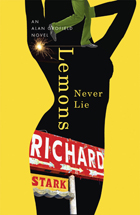 Lemons Never Lie: An Alan Grofield Novel
Richard Stark
University of Chicago Press, 1971 An action-packed crime novel starring Alan Grofield, the ladies' man associate of the legendary heister Parker
Donald E. Westlake is one of the greats of crime fiction. Under the pseudonym Richard Stark, he wrote twenty-four fast-paced, hardboiled novels featuring Parker, a shrewd career criminal with a talent for heists. Using the same nom de plume, Westlake also completed a separate series in the Parker universe, starring Alan Grofield, an occasional colleague of Parker. While he shares events and characters with several Parker novels, Grofield is less calculating and more hot-blooded than Parker; think fewer guns, more dames. Not that there isn’t violence and adventure aplenty. Lemons Never Lie—a taut thriller that finds Grofield recruited by a man named Myers for a sketchy brewery heist. But when Grofield gets cold feet, he has to decide if it’s riskier to go through with the plot, or to say no to Myers. With a new foreword by Sarah Weinman that situates the Grofield series within Westlake’s work as a whole, these novels are an exciting addition to any crime fiction fan’s library.
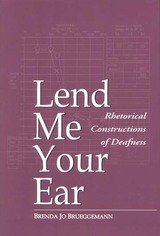 Lend Me Your Ear
Brenda Jo Brueggemann
Gallaudet University Press, 1999 The tradition of rhetoric established 2,500 years ago emphasizes the imperative of speech as a defining characteristic of reason. But in her new book Lend Me Your Ear, Brenda Jo Brueggemann exposes this tradition’s effect of disallowing deaf people human identity because of their natural silence. Brueggemann’s assault upon this long-standing rhetorical conceit is both erudite and personal; she writes both as a scholar and as a hard-of-hearing woman. In this broadly based study, she presents a profound analysis and understanding of this rhetorical tradition’s descendent disciplines (e.g., audiology, speech/language pathology) that continue to limit deaf people. Next to this even-handed scholarship, she juxtaposes a volatile emotional counterpoint achieved through interviews with Deaf individuals who have faced rhetorically constructed restrictions, and interludes of her own poetry and memoirs. The energized structure of Lend Me Your Ear galvanizes new thought on the rhetoric surrounding Deaf people by posing basic questions from a rhetorical context: How is deafness constructed as a disability, pathology, or culture through the institutions of literacy education and science/technology, and how do these constructions fit with those of deaf people themselves? The rhetoric of deafness as pathology is associated with the conventional medical and scientific establishments, and literacy education fosters deafness as disability, both dependent upon the premise that speech drives communication. This kinetic study demands consideration of deafness in terms of the rhetoric of Deaf culture, American Sign Language (ASL), and the political activism of Deaf people. Brueggemann argues strenuously and successfully for a reevaluation of the speech model of rhetoric in light of the singular qualities of ASL poetry, a genre that adds the dimension of space and is not disembodied. Ironically, without a word being spoken or printed, ASL poetry returns to the fading, prized oral tradition of poets such as Homer. The speech imperative in traditional rhetoric also fails to present rhetorical forms for listening, or a rhetoric of silence. These and other break-out concepts introduced in Lend Me Your Ear that will stimulate scholars and students of rhetoric, language, and Deaf studies to return to this intriguing work again and again.
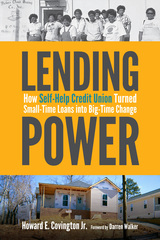 Lending Power: How Self-Help Credit Union Turned Small-Time Loans into Big-Time Change
Howard E. Covington Jr.
Duke University Press, 2017 Established by Martin Eakes and Bonnie Wright in North Carolina in 1980, the nonprofit Center for Community Self-Help has grown from an innovative financial institution dedicated to civil rights into the nation's largest home lender to low- and moderate-income borrowers. Self-Help's first capital campaign—a bake sale that raised a meager seventy-seven dollars for a credit union—may not have done much to fulfill the organization's early goals of promoting worker-owned businesses, but it was a crucial first step toward wielding inclusive lending as a weapon for economic justice.
In Lending Power journalist and historian Howard E. Covington Jr. narrates the compelling story of Self-Help's founders and coworkers as they built a progressive and community-oriented financial institution. First established to assist workers displaced by closed furniture and textile mills, Self-Help created a credit union that expanded into providing home loans for those on the margins of the financial market, especially people of color and single mothers.
Using its own lending record, Self-Help convinced commercial banks to follow suit, extending its influence well beyond North Carolina. In 1999 its efforts led to the first state law against predatory lending. A decade later, as the Great Recession ravaged the nation's economy, its legislative victories helped influence the Dodd-Frank Wall Street Reform and Consumer Protection Act and the formation of the Consumer Financial Protection Bureau. Self-Help also created a federally chartered credit union to expand to California and later to Illinois and Florida, where it assisted ailing community-based credit unions and financial institutions.
Throughout its history, Self-Help has never wavered from its mission to use Dr. Martin Luther King Jr.'s vision of justice to extend economic opportunity to the nation's unbanked and underserved citizens. With nearly two billion dollars in assets, Self-Help also shows that such a model for nonprofits can be financially successful while serving the greater good. At a time when calls for economic justice are growing ever louder, Lending Power shows how hard-working and dedicated people can help improve their communities.
The Lengest Neoi
Stephanie Choi
University of Iowa Press, 2024 The Lengest Neoi embraces and complicates what it means to err—to wander or go astray; a deviation from a code of behavior or truth; a mistake, flaw, or defect. Beginning with the collection’s title, which combines a colloquial Cantonese phrase (Leng Neoi / “Pretty Girl”) and the English suffix for the superlative degree (—est), these poems wander, deviate, and flow across bodies, geographies, and languages. In this collection from Stephanie Choi, you’ll find the poet’s “tongue writing herself, learning to speak.”
The Length of Days: An Urban Ballad
Volodymyr Rafeyenko
Harvard University Press, 2022 The Length of Days: An Urban Ballad is set mostly in the composite Donbas city of Z—an uncanny foretelling of what this letter has come to symbolize since February 24, 2022, when Russia launched a full-scale invasion of Ukraine. Several embedded narratives attributed to an alcoholic chemist-turned-massage therapist give insight into the funny, ironic, or tragic lives of people who remained in the occupied Donbas after Russia’s initial aggression in 2014.
With elements of magical realism, Volodymyr Rafeyenko’s novel combines a wicked sense of humor with political analysis, philosophy, poetry, and moral interrogation. Witty references to popular culture—Ukrainian and European—underline the international and transnational aspects of Ukrainian literature. The novel ends on the hopeful note that even death cannot have the final word: the resilient inhabitants of Z grow in power through reincarnation.
Lenin
Seán Sheehan
Haus Publishing, 2003 Views of Lenin are currently set in a tone of highly judgemental opinion: he was inflexible, doctrinaire and a cold-blooded revolutionary. A man whose indifference to culture led to political extremes, paving the way for his successor Stalin’s totalitarianism and some of the most heinous and gruesome ideological crimes committed during the 20th century. Enshrined as an icon of Soviet ideology and power, the statues of Lenin that were once a common sight across Eastern Europe and Russia have been toppled and his reputation crumbled into the dust of historical memory. This short Life & Times biography of Lenin sets out to examine his legacy in the light of the complete and total collapse of the ideology he espoused. Sheehan seeks to separate the myth from the fact, and let the real Lenin emerge from behind the opposing shrouds of deification and condemnation, revealing the creator of the 20th century’s most influential yet bloodthirsty beliefs.
 Lenin: A Biography
Robert Service
Harvard University Press, 2000 Lenin’s politics continue to reverberate around the world even after the end of the USSR. His name elicits revulsion and reverence, yet Lenin the man remains largely a mystery. This biography shows us Lenin as we have never seen him, in his full complexity as revolutionary, political leader, thinker, and private person.
Born Vladimir Ilyich Ulyanov in 1870, the son of a schools inspector and a doctor’s daughter, Lenin was to become the greatest single force in the Soviet revolution—and perhaps the most influential politician of the twentieth century. Drawing on sources only recently discovered, Robert Service explores the social, cultural, and political catalysts for Lenin’s explosion into global prominence. His book gives us the vast panorama of Russia in that awesome vortex of change from tsarism’s collapse to the establishment of the communist one-party state. Through the prism of Lenin’s career, Service focuses on dictatorship, the Marxist revolutionary dream, civil war, and interwar European politics. And we are shown how Lenin, despite the hardships he inflicted, was widely mourned upon his death in 1924.
Service’s Lenin is a political colossus but also a believable human being. This biography stresses the importance of his supportive family and of its ethnic and cultural background. The author examines his education, upbringing, and the troubles of his early life to explain the emergence of a rebel whose devotion to destruction proved greater than his love for the “proletariat” he supposedly served. We see how his intellectual preoccupations and inner rage underwent volatile interaction and propelled his career from young Marxist activist to founder of the communist party and the Soviet state—and how he bequeathed to Russia a legacy of political oppression and social intimidation that has yet to be expunged.
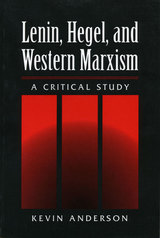 LENIN HEGEL & WESTERN MARXISM: A CRITICAL STUDY
Kevin Anderson
University of Illinois Press, 1995 This first full-length treatment of Lenin's studies of Hegel presents Lenin as a major figure in Hegelian Marxism, providing a more nuanced portrait of his work than that of either official Marxist-Leninism or most Western accounts.
"With impressive argumentation
and wide-ranging scholarship, Anderson presents us with a Lenin that no
one seriously interested in current debates over the relevance of Marxist
theory to socialist practice can afford to miss." -- Bertell Ollman,
author of Dialectical Investigations
"An important contribution
to grasping the conceptual roots of Marxist theory and practice."
-- Tom Rockmore, author of Hegel's Circular Epistomology
"Today Lenin looks like
he did little more than prepare the way for Stalin. You will find the
opposite view in this novel study. . . . I recommend the book to anyone
seriously interested in Russia and revolution." -- George Uri Fischer,
author of The Soviet System and Modern Society
Lenin Lives!: The Lenin Cult in Soviet Russia, Enlarged Edition
Nina Tumarkin
Harvard University Press, 1997 Was the deification of Lenin a show of spontaneous affection—or a planned political operation designed to solidify the revolution with the masses? This book provides a startling answer. Exploring the cult’s mystical, historical, and political aspects, Tumarkin demonstrates the galvanizing power of ritual in the establishment of the post-revolutionary regime. In a new Preface and Postscript, she brings the story up to date, considering the fall of the Soviet Union and Russia’s new democracy.
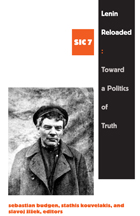 Lenin Reloaded: Toward a Politics of Truth, sic vii
Sebastian Budgen, Stathis Kouvelakis, and Slavoj Žižek, eds.
Duke University Press, 2007 Lenin Reloaded is a rallying call by some of the world’s leading Marxist intellectuals for renewed attention to the significance of Vladimir Lenin. The volume’s editors explain that it was Lenin who made Karl Marx’s thought explicitly political, who extended it beyond the confines of Europe, who put it into practice. They contend that a focus on Lenin is urgently needed now, when global capitalism appears to be the only game in town, the liberal-democratic system seems to have been settled on as the optimal political organization of society, and it has become easier to imagine the end of the world than a modest change in the mode of production. Lenin retooled Marx’s thought for specific historical conditions in 1914, and Lenin Reloaded urges a reinvention of the revolutionary project for the present. Such a project would be Leninist in its commitment to action based on truth and its acceptance of the consequences that follow from action. These essays, some of which are appearing in English for the first time, bring Lenin face-to-face with the problems of today, including war, imperialism, the imperative to build an intelligentsia of wage earners, the need to embrace the achievements of bourgeois society and modernity, and the widespread failure of social democracy. Lenin Reloaded demonstrates that truth and partisanship are not mutually exclusive as is often suggested. Quite the opposite—in the present, truth can be articulated only from a thoroughly partisan position. Contributors. Kevin B. Anderson, Alain Badiou, Etienne Balibar, Daniel Bensaïd, Sebastian Budgen, Alex Callinicos, Terry Eagleton, Fredric Jameson, Stathis Kouvelakis, Georges Labica, Sylvain Lazarus, Jean-Jacques Lecercle, Lars T. Lih, Domenico Losurdo, Savas Michael-Matsas, Antonio Negri, Alan Shandro, Slavoj Žižek
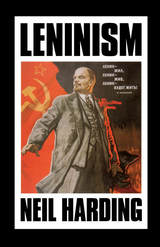 Leninism
Neil Harding
Duke University Press, 1996 In this volume, Neil Harding presents the first comprehensive reinterpretation of Leninism to be produced in many years. Challenging much of the conventional wisdom regarding Leninism’s effectiveness as a mobilizing body of ideas, its substance, and its origins and evolution, Harding offers both a controversial exposition of this ideology and a critical engagement with its consequences for the politics of contemporary communism.
Rather than tracing the roots of Leninism to the details of Lenin’s biography, Harding shows how it emerged as a revolutionary Marxist response to the First World War and to the perceived treachery—the support of that war—by social democratic leaders. The economics, politics, and philosophy of Leninism, he argues, were rapidly theorized between 1914 and 1918 and deeply imprinted with the peculiarities of the wartime experience. Its complementary metaphysics of history and science was as intrinsic to its confidence and sureness of purpose as it was to its contempt for democratic practice and tolerance. But, as Harding also shows, although Leninism articulated a complex and coherent critique of capitalist civilization and held a powerful appeal to a variety of constituencies, it was itself caught in a timewarp that fatally limited its capacity to adapt. This book will engage not only Russian and Soviet specialists, but also readers concerned with the varieties of twentieth-century socialism.
Leninism
Alfred George Meyer
Harvard University Press
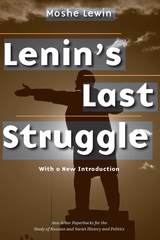 Lenin's Last Struggle
Moshe Lewin
University of Michigan Press, 2005 One of the great political strategists of his era, V. I. Lenin continues to attract historical interest, yet his complex personality eludes full understanding. This new edition of Moshe Lewin's classic political biography, including an afterword by the author, suggests new approaches for studying the Marxist visionary and founder of the Soviet state. Lenin's Last Struggle offers invaluable insights into the rise of the Bolshevik party and the Soviet Union, a saga complicated by complex strategic battles among the leaders of Lenin's generation: leaders whose names are universally known, but whose personalities and motivations are even now not sufficiently understood. Moshe Lewin was a collective farm worker in the USSR and a soldier in the Soviet army. He later became director of studies at the Ecole Pratique des Hautes Etudes in Paris, a fellow of the Kennan Institute, a senior fellow of Columbia University's Russian Institute, and is now emeritus professor of history at The University of Pennsylvania.
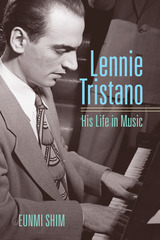 Lennie Tristano: His Life in Music
Eunmi Shim
University of Michigan Press, 2007 “In Lennie Tristano: His Life in Music, Shim has provided a comprehensive biographical and analytical account of one of jazz’s most important and most frequently misunderstood figures. Her insights into Tristano’s personality are well nuanced, and the focus on his teaching makes a unique contribution to the history of jazz. This vividly written study is likely to become a standard work.”
—Brian Priestley, author of Chasin’ the Bird: The Life and Legacy of Charlie Parker and coauthor of The Rough Guide to Jazz “Eunmi Shim’s book is clearly a labor of love. Her thorough examination of Tristano’s teaching is particularly important, for no one previously has assembled the thoughts of so many former students. Her illuminating transcriptions of, and commentaries on, Tristano’s solos are also valuable. Lennie Tristano is an important contribution to the literature on jazz.” —Thomas Owens, author of Bebop: The Music and Its Players “Comprehensive, objective, and acute in its judgments, this is the biography of Lennie Tristano we have been waiting for.” —Larry Kart, author of Jazz in Search of Itself Lennie Tristano occupies a rare position not only in jazz history but in the history of twentieth-century music. Emerging from an era when modernism was the guiding principle in art, Tristano explored musical avenues that were avant-garde even by modernism’s experimental standards. In so doing, he tested and transcended the boundaries of jazz. In 1949, years before musicians such as Ornette Coleman and Cecil Taylor took credit for the movement, Tristano made the first recordings of “free jazz,” a new kind of group improvisation based on spontaneous interaction among band members without any regard for predetermined form, harmony, or rhythm. Then, in the 1950s, Tristano broke new ground by his use of multitracking. Tristano was also a pioneer in the teaching of jazz, devoting the latter part of his career almost exclusively to music instruction. He founded a jazz school—the first of its kind—among whose students were saxophonists Warne Marsh and Lee Konitz, and pianist Sal Mosca. With its blend of oral history, archival research, and musical analysis, Lennie Tristano sheds new light on the important role Tristano played in the jazz world and introduces this often-overlooked musician to a new generation of jazz aficionados. Eunmi Shim received her Ph.D. in musicology from the University of Illinois at Urbana-Champaign and is now Assistant Professor of Music at Worcester Polytechnic Institute. This is her first book.
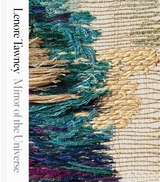 Lenore Tawney: Mirror of the Universe
Edited by Karen Patterson
University of Chicago Press, 2019 Recent years have seen an enormous surge of interest in fiber arts, with works made of thread on display in art museums around the world. But this art form only began to transcend its origins as a humble craft in the late nineteenth and early twentieth centuries, and it wasn’t until the 1950s and 1960s that artists used the fiber arts to build critical practices that challenged the definitions of painting, drawing, and sculpture. One of those artists was Lenore Tawney (1907–2007).
Raised and trained in Chicago before she moved to New York, Tawney had a storied career. She was known for employing an ancient Peruvian gauze weave technique to create a painterly effect that appeared to float in space rather than cling to the wall, as well as for being one of the first artists to blend sculptural techniques with weaving practices and, in the process, pioneered a new direction in fiber art. Despite her prominence on the New York art scene, however, she has only recently begun to receive her due from the greater art world. Accompanying a retrospective at the John Michael Kohler Arts Center, this catalog features a comprehensive biography of Tawney, additional essays on her work, and two hundred full-color illustrations, making it of interest to contemporary artists, art historians, and the growing audience for fiber art.
Copublished with the John Michael Kohler Arts Center.
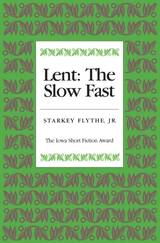 Lent: The Slow Fast
Starkey, Jr. Flythe
University of Iowa Press, 1990 In these riveting stories, the individual is thrown into the larger, insensitive space of war, religion, or so-called progress, where persistence or survival must be supported on the smaller and sometimes socially inappropriate measure of personal beliefs and desires.
In the title story, a woman discovers success, conviviality, and spiritual pleasure in a church family only to find her own, smaller family is falling apart. In "Walking, Walking," an old woman sees the ghost of her son and wonders why in life he could not do right and why now, in death, he can't rest. The deception of the modern world, of progress and real estate values, enables her to triumph over the schemes of an undertaker and lead her son to rest. Ugly strength overwhelms intelligence and hope in "The Ice Fisher," as a woman defies her husband to enroll her son in the protection and opportunity of a choir school.
In all the stories enlightened selfishness takes on heroic quality—these people defy and resist, determine and persist, regardless of the cost.
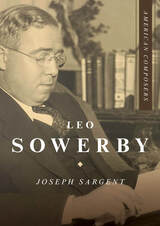 Leo Sowerby
Joseph Sargent
University of Illinois Press, 2024 From the 1920s to the 1940s, Leo Sowerby created popular secular works while his sacred compositions led admirers to call him the “dean of American church musicians.” Yet in time, Sowerby’s Pulitzer Prize-winning The Canticle of the Sun and the rest of his corpus lost favor with the A-list symphonies and prominent musicians who had once made him a fixture in their repertoires. Joseph Sargent’s biography offers the first focused study of Sowerby’s life and work against the backdrop of the composer’s place in American music. As Sargent shows, Sowerby’s present-day marginalization as a composer relates less to the quality of his work than the fact that today’s historiographical practices and canon-building activities minimize modern church music. Sargent’s re-evaluation draws on a wide range of perspectives and composer’s music and writings to enrich detailed analyses of musical works and a career-spanning consideration of Sowerby’s musical language and aesthetic priorities.
 Leo Strauss and Anglo-American Democracy: A Conservative Critique
Grant N. Havers
Northern Illinois University Press, 2013
In this original new study, Grant Havers critically interprets Leo Strauss’s political philosophy from a conservative perspective. Most mainstream readers of Strauss have either condemned him from the Left as an extreme right-wing opponent of liberal democracy or celebrated him from the Right as a traditional defender of Western civilization. Rejecting both of these portrayals, Havers shifts the debate beyond the conventional parameters of our age. He persuasively shows that Strauss was neither a man of the Far Right nor a conservative. He was in fact a secular Cold War liberal who taught his followers to uphold Anglo-American democracy as the one true universal regime that does not need a specifically Christian foundation.
Strauss firmly rejects the traditional conservative view held by Edmund Burke that Anglo-American democracy needs the leavening influence of Christian morality (love thy neighbor). Havers maintains that Strauss’s refusal to recognize the role of Christianity in shaping Western civilization, though historically unjustified, is crucial to Strauss and the Straussian portrayal of Anglo-American democracy . In the Straussian view, the Anglo-American ideals of liberty, equality, and constitutional government owe more to the ancient Greek philosophers Plato and Aristotle than to the Christian tradition. In the process, Havers argues, Straussians end up rewriting history by falsely idealizing the ancient Greeks as the forerunners of modern liberal democracy, despite the Greek toleration of practices such as slavery and infanticide. Straussians also misrepresent statesmen of the Anglo-American political tradition such as Abraham Lincoln and Sir Winston Churchill as heirs to the ancient Greek tradition of statecraft, despite their indebtedness to Christianity.
Havers contends that the most troubling implication of Straussianism is that it provides an ideological rationale for the aggressive spread of democratic values on a global basis while ignoring the preconditions that make these values possible. Concepts such as the rule of law, constitutional government, Christian morality, and the separation of church and state are not easily transplanted beyond the historic confines of Anglo-American civilization, as recent wars to spread democracy in the Middle East and Central Asia have demonstrated. This excellent study will be of interest not only to longtime readers of Strauss but also philosophers, political scientists, historians, religious studies scholars, and theologians.
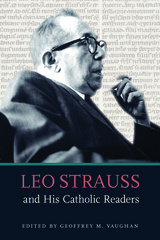 Leo Strauss and His Catholic Readers
Geoffrey M. Vaughan
Catholic University of America Press, 2018 This book looks at the work and influence of Leo Strauss in a variety of ways that will be of interest to readers of political philosophy. It will be of particular interest to Catholics and scholars of other religious traditions. Strauss had a great deal of interaction with his contemporary Catholic scholars, and many of his students or their students teach or have taught at Catholic colleges and universities in America. Leo Strauss and His Catholic Readers brings together work by scholars from two continents, some of whom knew Strauss, one of whom was his student at the University of Chicago. The first section of essays considers Catholic responses to Strauss’s project of recovering Classical natural right as against modern individual rights. Some of the authors suggest that his approach can be a fruitful corrective to an uncritical reception of modern ideas. Nevertheless, most point out that the Catholic cannot accept all of Strauss’s project. The second section deals with areas of overlap between Strauss and Catholics. Some of the chapters explore encounters with his contemporary scholars while others turn to more current concerns. The final section approaches the theological-political question itself, a question central to both Strauss’s work and that of the Catholic intellectual tradition. This section of the book considers the relationship of Strauss’s work to Christianity and Christian commitments at a broader level. Because Christianity does not have an explicit political doctrine, Christians have found themselves as rulers, subjects, and citizens in a variety of political regimes. Leo Strauss’s return to Platonic political philosophy can provide a useful lens through which his Catholic readers can assess what it means for there to be a best regime.
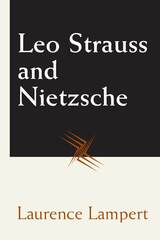 Leo Strauss and Nietzsche
Laurence Lampert
University of Chicago Press, 1995 The influential political philosopher Leo Strauss has been credited by conservatives with the recovery of the great tradition of political philosophy stretching back to Plato. Among Strauss's most enduring legacies is a strongly negative assessment of Nietzsche as the modern philosopher most at odds with that tradition and most responsible for the sins of twentieth-century culture—relativism, godlessness, nihilism, and the breakdown of family values. In fact, this apparent denunciation has become so closely associated with Strauss that it is often seen as the very core of his thought.
In Leo Strauss and Nietzsche, the eminent Nietzsche scholar Laurence Lampert offers a controversial new assessment of the Strauss-Nietzsche connection. Lampert undertakes a searching examination of the key Straussian essay, "Note on the Plan of Nietzsche's Beyond Good and Evil." He shows that this essay, written toward the end of Strauss's life and placed at the center of his final work, reveals an affinity for and debt to Nietzsche greater than Strauss's followers allow. Lampert argues that the essay comprises the most important interpretation of Nietzsche ever published, one that clarifies Nietzsche's conception of nature and of human spiritual history and demonstrates the logical relationship between the essential themes in Nietzsche's thought—the will to power and the eternal return.
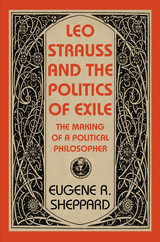 Leo Strauss and the Politics of Exile: The Making of a Political Philosopher
Eugene Sheppard
Brandeis University Press, 2007 Born in rural Hesse, Germany, Leo Strauss (1899–1973) became an active Zionist and philosopher during the tumultuous and fractious Weimar Republic. As Eugene R. Sheppard demonstrates in this groundbreaking and engaging book, Strauss gravitated towards such thinkers as Franz Rosenzweig, Martin Heidegger, and Carl Schmitt as he sought to identify and overcome fundamental philosophical, political, and theological crises. The rise of Nazism impelled Strauss as a young Jewish émigré, first in Europe and then in America, to grapple with—and accommodate his thought to—the pressing challenges of exile. In confronting his own state of exile, Strauss enlisted premodern Jewish thinkers such as Moses Maimonides and Baruch Spinoza who earlier addressed the problem of reconciling their competing loyalties as philosophers and Jews. This is the first study to frame Strauss’s political philosophy around his critique of liberalism and the problem of exile. Sheppard follows Strauss from Europe to the United States, a journey of a conservative Weimar Jew struggling with modern liberalism and the existential and political contours of exile. Strauss sought to resolve the conflicts of a Jew unwilling to surrender loyalty to his ancestral community and equally unwilling to adhere to the strictures of orthodox observance. Strauss saw truth and wisdom as transcending particular religious and national communities, as well as the modern enlightened humanism in which he himself had been nurtured. In his efforts to navigate between the Jewish and the philosophical, the ancient and the modern, Berlin and New York, Strauss developed a distinctively programmatic way of reading and writing “between the lines.” Sheppard recaptures the complexity and intrigue of this project which has been ignored by those who both reject and claim Strauss’s legacy.
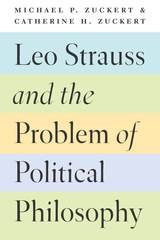 Leo Strauss and the Problem of Political Philosophy
Michael P. Zuckert and Catherine H. Zuckert
University of Chicago Press, 2014 Leo Strauss and his alleged political influence regarding the Iraq War have in recent years been the subject of significant media attention, including stories in the Wall Street Journal and New York Times.Time magazine even called him “one of the most influential men in American politics.” With The Truth about Leo Strauss, Michael and Catherine Zuckert challenged the many claims and speculations about this notoriously complex thinker. Now, with Leo Strauss and the Problem of Political Philosophy, they turn their attention to a searching and more comprehensive interpretation of Strauss’s thought as a whole, using the many manifestations of the “problem of political philosophy” as their touchstone.
For Strauss, political philosophy presented a “problem” to which there have been a variety of solutions proposed over the course of Western history. Strauss’s work, they show, revolved around recovering—and restoring—political philosophy to its original Socratic form. Since positivism and historicism represented two intellectual currents that undermined the possibility of a Socratic political philosophy, the first part of the book is devoted to Strauss’s critique of these two positions. Then, the authors explore Strauss’s interpretation of the history of philosophy and both ancient and modern canonical political philosophers, including Plato, Aristotle, Machiavelli, and Locke. Strauss’s often-unconventional readings of these philosophers, they argue, pointed to solutions to the problem of political philosophy. Finally, the authors examine Strauss’s thought in the context of the twentieth century, when his chief interlocutors were Schmitt, Husserl, Heidegger, and Nietzsche.
The most penetrating and capacious treatment of the political philosophy of this complex and often misunderstood thinker, from his early years to his last works, Leo Strauss and the Problem of Political Philosophy reveals Strauss’s writings as an attempt to show that the distinctive characteristics of ancient and modern thought derive from different modes of solving the problem of political philosophy and reveal why he considered the ancient solution both philosophically and politically superior.
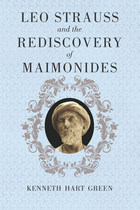 Leo Strauss and the Rediscovery of Maimonides
Kenneth Hart Green
University of Chicago Press, 2013 In Leo Strauss and the Rediscovery of Maimonides, Kenneth Hart Green explores the critical role played by Maimonides in shaping Leo Strauss’s thought. In uncovering the esoteric tradition employed in Maimonides’s Guide of the Perplexed, Strauss made the radical realization that other ancient and medieval philosophers might be concealing their true thoughts through literary artifice. Maimonides and al-Farabi, he saw, allowed their message to be altered by dogmatic considerations only to the extent required by moral and political imperatives and were in fact avid advocates for enlightenment. Strauss also revealed Maimonides’s potential relevance to contemporary concerns, especially his paradoxical conviction that one must confront the conflict between reason and revelation rather than resolve it.
An invaluable companion to Green’s comprehensive collection of Strauss’s writings on Maimonides, this volume shows how Strauss confronted the commonly accepted approaches to the medieval philosopher, resulting in both a new understanding of Maimonides and a new depth and direction for his own thought. It will be welcomed by anyone engaged with the work of either philosopher.
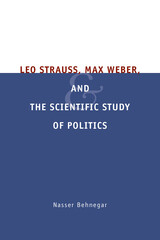 Leo Strauss, Max Weber, and the Scientific Study of Politics
Nasser Behnegar
University of Chicago Press, 2002 Can politics be studied scientifically, and if so, how? Assuming it is impossible to justify values by human reason alone, social science has come to consider an unreflective relativism the only viable basis, not only for its own operations, but for liberal societies more generally. Although the experience of the sixties has made social scientists more sensitive to the importance of values, it has not led to a fundamental reexamination of value relativism, which remains the basis of contemporary social science. Almost three decades after Leo Strauss's death, Nasser Behnegar offers the first sustained exposition of what Strauss was best known for: his radical critique of contemporary social science, and particularly of political science.
Behnegar's impressive book argues that Strauss was not against the scientific study of politics, but he did reject the idea that it could be built upon political science's unexamined assumption of the distinction between facts and values. Max Weber was, for Strauss, the most profound exponent of values relativism in social science, and Behnegar's explication artfully illuminates Strauss's critique of Weber's belief in the ultimate insolubility of all value conflicts.
Strauss's polemic against contemporary political science was meant to make clear the contradiction between its claim of value-free premises and its commitment to democratic principles. As Behnegar ultimately shows, values—the ethical component lacking in a contemporary social science—are essential to Strauss's project of constructing a genuinely scientific study of politics.
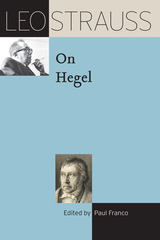 Leo Strauss on Hegel
Leo Strauss
University of Chicago Press, 2019 In the winter of 1965, Leo Strauss taught a seminar on Hegel at the University of Chicago. While Strauss neither considered himself a Hegelian nor wrote about Hegel at any length, his writings contain intriguing references to the philosopher, particularly in connection with his studies of Hobbes, in his debate in On Tyranny with Alexandre Kojève; and in his account of the “three waves” of modern political philosophy.
Leo Strauss on Hegel reconstructs Strauss’s seminar on Hegel, supplemented by passages from an earlier version of the seminar from which only fragments of a transcript remain. Strauss focused his seminar on the lectures collected in The Philosophy of History, which he considered more accessible than Hegel’s written works. In his own lectures on Hegel, Strauss continues his project of demonstrating how modern philosophers related to ancient thought and explores the development and weaknesses of modern political theory. Strauss is especially concerned with the relationship in Hegel between empirical history and his philosophy of history, and he argues for the primacy of religion in Hegel’s understanding of history and society. In addition to a relatively complete transcript, Leo Strauss on Hegel also includes annotations, which bring context and clarity to the text.
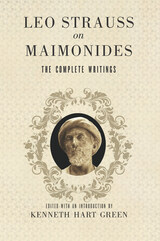 Leo Strauss on Maimonides: The Complete Writings
Leo Strauss
University of Chicago Press, 2013 Leo Strauss is widely recognized as one of the foremost interpreters of Maimonides. His studies of the medieval Jewish philosopher led to his rediscovery of esotericism and deepened his sense that the tension between reason and revelation was central to modern political thought. His writings throughout the twentieth century were chiefly responsible for restoring Maimonides as a philosophical thinker of the first rank. Yet, to appreciate the extent of Strauss’s contribution to the scholarship on Maimonides, one has traditionally had to seek out essays he published separately spanning almost fifty years.
With Leo Strauss on Maimonides, Kenneth Hart Green presents for the first time a comprehensive, annotated collection of Strauss’s writings on Maimonides, comprising sixteen essays, three of which appear in English for the first time. Green has also provided careful translations of materials that had originally been quoted in Hebrew, Arabic, Latin, German, and French; written an informative introduction highlighting the original contributions found in each essay; and brought references to out-of-print editions fully up to date. The result will become the standard edition of Strauss’s writings on Maimonides.
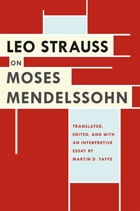 Leo Strauss on Moses Mendelssohn
Leo Strauss
University of Chicago Press, 2012 Moses Mendelssohn (1729–86) was the leading Jewish thinker of the German Enlightenment and the founder of modern Jewish philosophy. His writings, especially his attempt during the Pantheism Controversy to defend the philosophical legacies of Spinoza and Leibniz against F. H. Jacobi’s philosophy of faith, captured the attention of a young Leo Strauss and played a critical role in the development of his thought on one of the fundamental themes of his life’s work: the conflicting demands of reason and revelation.
Leo Strauss on Moses Mendelssohn is a superbly annotated translation of ten introductions written by Strauss to a multi-volume critical edition of Mendelssohn’s work. Commissioned in Weimar Germany in the 1920s, the project was suppressed and nearly destroyed during Nazi rule and was not revived until the 1960s. In addition to Strauss’s introductions, Martin D. Yaffe has translated Strauss’s editorial remarks on each of the passages he annotates in Mendelssohn’s texts and brings those together with the introductions themselves. Yaffe has also contributed an extensive interpretive essay that both analyzes the introductions on their own terms and discusses what Strauss writes elsewhere about the broader themes broached in his Mendelssohn studies.
Strauss’s critique of Mendelssohn represents one of the largest bodies of work by the young Strauss on a single thinker to be made available in English. It illuminates not only a formerly obscure phase in the emergence of his thought but also a critical moment in the history of the German Enlightenment.
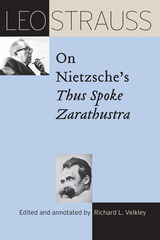 Leo Strauss on Nietzsche's "Thus Spoke Zarathustra"
Leo Strauss
University of Chicago Press, 2017 Although Leo Strauss published little on Nietzsche, his lectures and correspondence demonstrate a deep critical engagement with Nietzsche’s thought. One of the richest contributions is a seminar on Nietzsche’s Thus Spoke Zarathustra, taught in 1959 during Strauss’s tenure at the University of Chicago. In the lectures, Strauss draws important parallels between Nietzsche’s most important project and his own ongoing efforts to restore classical political philosophy.
With Leo Strauss on Nietzsche’s “Thus Spoke Zarathustra,” eminent Strauss scholar Richard L. Velkley presents Strauss’s lectures on Zarathustra with superb annotations that bring context and clarity to the critical role played by Nietzsche in shaping Strauss’s thought. In addition to the broad relationship between Nietzsche and political philosophy, Strauss adeptly guides readers through Heidegger’s confrontations with Nietzsche, laying out Heidegger’s critique of Nietzsche’s “will to power” while also showing how Heidegger can be read as a foil for his own reading of Nietzsche. The lectures also shed light on the relationship between Heidegger and Strauss, as both philosophers saw Nietzsche as a central figure for understanding the crisis of philosophy and Western civilization.
Strauss’s reading of Nietzsche is one of the important—yet little appreciated—philosophical inquiries of the past century, both an original interpretation of Nietzsche’s thought and a deep engagement with the core problems that modernity posed for political philosophy. It will be welcomed by anyone interested in the work of either philosopher.
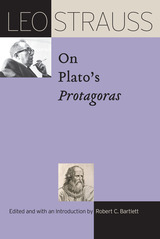 Leo Strauss on Plato’s "Protagoras"
Leo Strauss
University of Chicago Press, 2022 A transcript of Leo Strauss’s key seminars on Plato’s Protagoras.
This book offers a transcript of Strauss’s seminar on Plato’s Protagoras taught at the University of Chicago in the spring quarter of 1965, edited and introduced by renowned scholar Robert C. Bartlett. These lectures have several important features. Unlike his published writings, they are less dense and more conversational. Additionally, while Strauss regarded himself as a Platonist and published some work on Plato, he published little on individual dialogues. In these lectures Strauss treats many of the great Platonic and Straussian themes: the difference between the Socratic political science or art and the Sophistic political science or art of Protagoras; the character and teachability of virtue, its relation to knowledge, and the relations among the virtues, courage, justice, moderation, and wisdom; the good and the pleasant; frankness and concealment; the role of myth; and the relation between freedom of thought and freedom of speech.
In these lectures, Strauss examines Protagoras and the sophists, providing a detailed discussion of Protagoras as it relates to Plato’s other dialogues and the work of modern thinkers. This book should be of special interest to students both of Plato and of Strauss.
Leo Strauss On Plato's Symposium
Leo Strauss
University of Chicago Press, 2001 The first major piece of unpublished work by Leo Strauss to appear in more than thirty years, this volume offers the public the unprecedented experience of encountering this renowned scholar as his students did. Given as a course in autumn 1959 under the title "Plato's Political Philosophy," these provocative lectures—until now, never published, but instead passed down from one generation of students to the next—show Strauss at his subtle and insightful best.
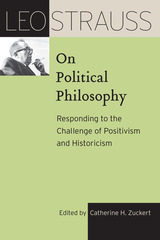 Leo Strauss on Political Philosophy: Responding to the Challenge of Positivism and Historicism
Leo Strauss
University of Chicago Press, 2018 Leo Strauss is known primarily for reviving classical political philosophy through careful analyses of works by ancient thinkers. As with his published writings, Strauss’s seminars devoted to specific philosophers were notoriously dense, accessible only to graduate students and scholars with a good command of the subject. In 1965, however, Strauss offered an introductory course on political philosophy at the University of Chicago. Using a conversational style, he sought to make political philosophy, as well as his own ideas and methods, understandable to those with little background on the subject.
Leo Strauss on Political Philosophy brings together the lectures that comprise Strauss’s “Introduction to Political Philosophy.” Strauss begins by emphasizing the importance of political philosophy in determining the common good of society and critically examining the two most powerful contemporary challenges to the possibility of using political theory to learn about and develop the best political order: positivism and historicism. In seeking the common good, classical political philosophers like Plato and Aristotle did not distinguish between political philosophy and political science. Today, however, political philosophy must contend with the contemporary belief that it is impossible to know what the good society really is. Strauss emphasizes the need to study the history of political philosophy to see whether the changes in the understanding of nature and conceptions of justice that gradually led people to believe that it is not possible to determine what the best political society is are either necessary or valid. In doing so, he ranges across the entire history of political philosophy, providing a valuable, thematically coherent foundation, including explications of many canonical thinkers, such as Auguste Comte and Immanuel Kant, about whom Strauss did not write extensively in his published writings.
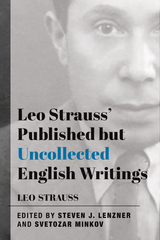 Leo Strauss' Published but Uncollected English Writings
Leo Strauss
St. Augustine's Press, 2023 Any presentation of political philosophy in the 20th century is radically incomplete without Leo Strauss. The appearance of this collection is particularly important given the relentless but shifting interest in his influence and thought in recent years. Lenzner and Minkov contend that in order to evaluate Strauss’s achievement properly, one must do so chiefly with reference to the works by which Strauss sought to establish his legacy–i.e., those he chose to submit for the consideration of future readers.
The most complete record of Strauss's thought includes his books together with his other published and unpublished writings and lectures. The achievement of this volume is to present in one collection every piece Strauss chose to publish in English that he did not himself include in a collection or a book. The material is arranged chronologically so as to avoid undue categorization by the editors.
Among the highlights of these works published between 1937 and 1972 are striking formulations not to be found in his books on the relationship between philosophy and society, which is perhaps the most prominent theme in Strauss’s corpus taken as a whole; rare ‘personal’ statements that shed light on his self-understanding as a philosopher; his first writing devoted solely to a classical thinker (“The Spirit of Sparta or the Taste of Xenophon”); his first piece devoted to Plato, “On a New Interpretation of Plato’s Political Philosophy,” his most searching engagement with Jean-Jacques Rousseau; his first treatment of the thought of Niccolò Machiavelli and a wonderful, later treatment of Machiavelli’s relation to ancient writers; and a critical review of a book on Xenophon’s Hellenica.
This complete collection of Strauss’s scattered work in English is invaluable for those interested in the political philosopher, to be sure. But it is also an important contribution to the field in general as well as the history of philosophy.
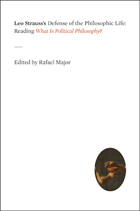 Leo Strauss's Defense of the Philosophic Life: Reading "What Is Political Philosophy?"
Edited by Rafael Major
University of Chicago Press, 2012 Leo Strauss’s What Is Political Philosophy? addresses almost every major theme in his life’s work and is often viewed as a defense of his overall philosophic approach. Yet precisely because the book is so foundational, if we want to understand Strauss’s notoriously careful and complex thinking in these essays, we must also consider them just as Strauss treated philosophers of the past: on their own terms. Each of the contributors in this collection focuses on a single chapter from What Is Political Philosophy? in an effort to shed light on both Strauss’s thoughts about the history of philosophy and the major issues about which he wrote. Included are treatments of Strauss’s esoteric method of reading, his critique of behavioral political science, and his views on classical political philosophy. Key thinkers whose work Strauss responded to are also analyzed in depth: Plato, Al-Farabi, Maimonides, Hobbes, and Locke, as well as twentieth-century figures such as Eric Voegelin, Alexandre Kojève, and Kurt Riezler. Written by scholars well-known for their insight and expertise on Strauss’s thought, the essays in this volume apply to Strauss the same meticulous approach he developed in reading others. The first book-length treatment on a single book by Strauss, Leo Strauss’s Defense of the Philosophic Life will serve as an invaluable companion to those seeking a helpful introduction or delving deeper into the major themes and ideas of this controversial thinker.
Leon and Louise
Alex Capus
Haus Publishing, 2011 Summer 1918. The First World War is drawing to a close when Léon Le Gall, a French teenager from Cherbourg who has dropped out of school and left home, falls in love with Louise Janvier. Both are severely wounded by German artillery fire, are separated, and believe each other to be dead. Briefly reunited two decades later, the two lovers are torn apart again by Louise's refusal to destroy Léon's marriage and by the German invasion of France. In occupied Paris during the Second World War, where Léon struggles against the abhorrent tasks imposed upon him by the SS, and the wilds of Africa, where Louise confronts the hardships of her primitive environment, they battle the vicissitudes of history and the passage of time for the survival of their love.
Leon Battista Alberti: Master Builder of the Italian Renaissance
Anthony Grafton
Harvard University Press, 2000 Leon Battista Alberti (1404-1472) was one of the most exciting figures of the Italian Renaissance. He wrote the first modern treatise on painting, the first modern manual of classical architecture, and a powerful set of "dialogues" about the princely families of Florence. But Alberti also made his own spectacular advances in the art of painting and in engineering, and was responsible for some of the most exciting architectural designs in Italy.
In this volume, one of our most distinguished Renaissance scholars offers the superlative biography and cultural history that Alberti has long deserved. It is a compelling portrait of a mysterious and original intellectual.
 Leon Bibel: Forgotten Artist of the New Deal
Richard Haw
Rutgers University Press, 2025 Leon Bibel (1913–1995) was a prolific modern American artist who painted, printed, stamped, etched, sketched, and carved. He produced pieces that ranged from social realism to dreamy expressionism and was an aesthetic experimentalist, never working for too long in any medium or style. And despite Bibel's obvious talent, his work would have languished in obscurity were it not for the New Deal programs like the Federal Art Project and Public Works of Art Project.
Leon Bibel, the first biography of this eclectic artist, recounts his life from his birth in Szczebrzeszyn, Poland, in 1913, to his death in New Jersey in 1995. After immigrating to the United States in the 1920s, Bibel came of age during the Great Depression, when New Deal agencies recognized his abilities and supported his artistic endeavors. Working-class artists faced challenges after these programs folded, and Bibel would later spend twenty years as a New Jersey chicken farmer before resurrecting his art career in the 1960s.
Historian Richard Haw shows how Bibel's life was defined by the New Deal, his visionary artwork shaped by the era's commitment to social and economic justice. With reproductions of more than 240 of Bibel's works, most in vivid color, this book reveals how he depicted everything from the trauma of unemployment to the dignity of work, from the horrors of lynching to the pleasures of everyday life.
Léon Blum: Humanist in Politics
Joel Colton
Duke University Press John Colton is a meticulous researcher and a fine craftsman. In his political biography of Leon Blum, these two qualities are beautiully blended; none of the available evidence appears to have been over looked, and the enormous mass of variegated material has been transmuted in a polished, richly tapestried, and absorbing narrative.
Leon Forrest: Introductions and Interpretations
John G. Cawelti
University of Wisconsin Press, 1997 The four novels of Leon Forrest are one of the major glories of contemporary African-American fiction. From the intense inwardness of There Is a Tree More Ancient than Eden to the epic comedy of Divine Days, Forrest's work presents a vision of African-American culture which is unique in its complexity and depth.
Leon Trotsky: Writings in Exile
Leon Trotsky
Pluto Press, 2012 Leon Trotsky was a key political figure of the twentieth century – a leader of the Russian Revolution, founder of the Red Army, author of books on literature, history, morality and politics.
Leon Trotsky: Writings in Exile contains some of his most insightful and penetrating works. Exiled and isolated by Stalin, Trotsky used the only weapon he had left – words. In these writings he defends the 1917 revolution, warns prophetically of fascism and analyses anti-colonial movements in the global south.
This collection gives a sense of the real Trotsky – passionate, humanist, Marxist. It will introduce the writings of one of history's great revolutionaries to a new generation.
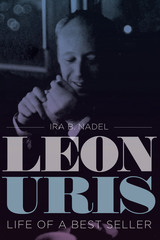 Leon Uris: Life of a Best Seller
By Ira B. Nadel
University of Texas Press, 2010 As the best-selling author of Exodus, Mila 18, QB VII, and Trinity, Leon Uris blazed a path to celebrity with books that readers could not put down. Uris's thirteen novels sold millions of copies, spent months on the best-seller lists, appeared in fifty languages, and have been adapted into equally popular movies and TV miniseries. Few other writers equaled Uris's fame in the mid-twentieth century. His success fueled the rise of mass-market paperbacks, movie tie-ins, and celebrity author tours. Beloved by the public, Uris was, not surprisingly, dismissed by literary critics. Until now, his own life—as full of drama as his fiction—has never been the subject of a book. In Leon Uris: Life of a Best Seller, Ira Nadel traces Uris from his disruptive youth to his life-changing experiences as a marine in World War II. These experiences, coupled with Uris's embrace of his Judaism and desire to write, led to his unprecedented success and the lavish excesses of a career as a best-selling author. Nadel reveals that Uris lived the adventures he described, including his war experiences in the Pacific (Battle Cry), life-threatening travels in Israel (Exodus), visit to Communist Poland (Mila 18), libel trial in Britain (QB VII), and dangerous sojourn in fractious Northern Ireland and the Irish Republic (Trinity). Nadel also demonstrates that Uris's talent for writing action-packed, yet thoroughly researched, novels meshed perfectly with the public's desire to revisit and understand the tumultuous events of recent history. This made him far more popular (and wealthy) than more literary authors, while paving the way for writers such as Irving Wallace and Tom Clancy.
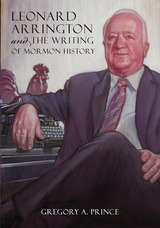 Leonard Arrington and the Writing of Mormon History
Gregory A. Prince
University of Utah Press, 2016 Copublished with the Tanner Trust Fund, J. Willard Marriott Library.
Leonard Arrington is considered by many the foremost twentieth-century historian of Mormonism. He played a key role in establishing the Western History Association and the Mormon History Association, and more than a half-century after its publication, his revised doctoral dissertation, Great Basin Kingdom: An Economic History of the Latter-day Saints 1830-1900, remains a standard. But Arrington’s career was not without controversy. Gregory Prince takes an in-depth look at this respected historian and, in telling Arrington’s story, gives readers insight into the workings of the LDS Church in the late twentieth century.
In 1972, during a major reorganization of the LDS Church, Arrington was asked to serve as the official church historian, thereby becoming the first—and thus far the only—professional historian to hold that title. He immediately set out to professionalize the entire Church History Division and open its extensive archives to scholarly researching. While the output of and from that division moved Mormon studies to a new level, the shift of historiography from faith promotion ecclesiastical, to scholarly and professional research and analysis was unacceptable to a handful of powerful senior apostles. In 1980 the History Division was disassembled and moved to Brigham Young University. That led to a shift in the professionalization of the Church History Division and Archives and in Arrington’s career but not to a loss of his broad influence.
This biography is the first to draw upon the remarkable Arrington diaries (over 20,000 pages); it is supplemented by the author’s interviews of more than 100 people who knew or worked with Arrington. The book is of additional significance given continuing battles between the LDS Church and scholars, which frequently gains national attention because of excommunications of prominent intellectuals.
Winner of the Evans Biography Award and the John Whitmer Historical Association's Brim Biography Book Award.
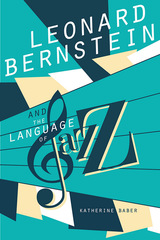 Leonard Bernstein and the Language of Jazz
Katherine Baber
University of Illinois Press, 2019 Leonard Bernstein's gifts for drama and connecting with popular audiences made him a central figure in twentieth century American music. Though a Bernstein work might reference anything from modernism to cartoon ditties, jazz permeated every part of his musical identity as a performer, educator, and intellectual. Katherine Baber investigates how jazz in its many styles served Bernstein as a flexible, indeed protean, musical idea. As she shows, Bernstein used jazz to signify American identity with all its tensions and contradictions and to articulate community and conflict, irony and parody, and timely issues of race and gender. Baber provides a thoughtful look at how Bernstein's use of jazz grew out of his belief in the primacy of tonality, music's value as a unique form of human communication, and the formation of national identity in music. She also offers in-depth analyses of On the Town, West Side Story, 1600 Pennsylvania Avenue, and other works to explore fascinating links between Bernstein's art and issues like eclecticism, music's relationship to social engagement, black-Jewish relations, and his own musical identity.
A Leonard Bloomfield Anthology
Leonard Bloomfield
University of Chicago Press, 1987 In the centenary year of Leonard Bloomfield's birth, this abridgment makes available a representative selection of the writings of this central figure in the history of linguistics.
"Hockett has achieved his purpose—to reveal Bloomfield's way of working, the general principles that guided his work, and last, but by no means least, to indicate how Bloomfield's interests and attitudes changed with the passing years."—Harry Hoijer, Language
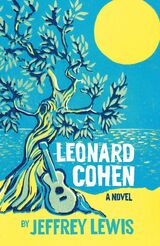 Leonard Cohen: A Novel
Jeffrey Lewis
Haus Publishing, 2025 A man who shares his name with a famous singer must grapple with his identity, purpose, and love.
The Leonard Cohen at the center of Leonard Cohen: A Novel is an everyman, a would-be artist, a would-be lover, a would-be tragic figure, yet a man haunted by the greatness of his namesake. He struggles to compete. He struggles to be more than a punchline in his own mind. He struggles, in particular, to write one song as great as the least of the great Leonard Cohen's songs.
At the center of Leonard's life is Daphne. In their meeting on a Greek island, a contemporary fable of Daphne and Apollo plays out. But even with Daphne, Leonard is shadowed by the other Leonard Cohen, whom he fears is the real Apollo. The ancient myth haunts the fated lovers, and the nobody Leonard Cohen’s life becomes at once a mystery, a miracle, and a myth on its own terms.
Once upon a time, Apollo fell hard for Daphne, who turned herself into a laurel tree. No less a fate awaits the protagonists of this slender yet universal novel, where art, love, and fame all fatefully intertwine.
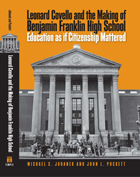 Leonard Covello and the Making of Benjamin Franklin High School: Education As If Citizenship Mattered
Michael C. Johanek and John L. Puckett
Temple University Press, 2006 What is the mission of American public education? As a nation, are we still committed to educating students to be both workers and citizens, as we have long proclaimed, or have we lost sight of the second goal of encouraging students to be contributing members of a democratic society?In this enlightening book, Michael Johanek and John Puckett describe one of America's most notable experiments in "community education." In the process, they offer a richly contextualized history of twentieth-century efforts to educate students as community-minded citizens. Although student test scores now serve to measure school achievement, the authors argue compellingly that the democratic goals of citizen-centered community schools can be reconciled with the academic performance demands of contemporary school reform movements. Using the twenty-year history of community-centered schooling at Benjamin Franklin High School in East Harlem as a case study—and reminding us of the pioneering vision of its founder, Leonard Covello—they suggest new approaches for educating today's students to be better "public work citizens."
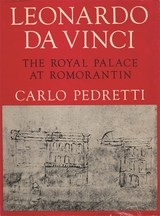 Leonardo da Vinci: The Royal Palace at Romorantin
Carlo Pedretti
Harvard University Press, 1972 Leonardo da Vinci spent the last three years of his life as a guest of the king of France in Amboise, and the last masterpiece he produced was the project for a royal residence at Romorantin. It was to be a vast complex of buildings and gardens crossed by the Saudre River, and was to incorporate the old chateau of the ancestors of Francis I. "The eve of St. Anthony's Day I returned from Romorantin to Amboise, and the king had left Romorantin two days before," wrote Leonardo in January 1517. In 1518 a canal project at Romorantin was financed. But in the year of Leonardo's death, 1519, the project for the palace was abandoned and the king decided to build the castle of Chambord instead. The loss of the Romorantin Palace is comparable in magnitude to that of Leonardo's wall paintin of the Battle of Anghiari--perhaps even more tragic, for little influence could come from an abandoned work of architecture, the conception of which was soon forgotten. The remains of the portion that was built stood ten feet high until the time of the French Revolution. Mr. Pedretti has traced the records of their existence, brought together all possible references to the project in Leonardo's manuscripts, and identified the site of the proposed construction. The style and sources of the project are shown through a wealth of illustrations which bring to life the image of Leonardo's last dream.
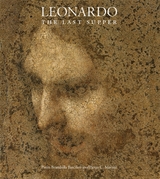 Leonardo, The Last Supper
Pinin Brambilla Barcilon and Pietro C. Marani
University of Chicago Press, 2001 Leonardo's Last Supper, one of the most important works of the Renaissance if not all of Western art, was painted between 1494 and 1498 in the refectory of Santa Maria delle Grazie in Milan. From the moment that the prior at the monastery complained to Leonardo that the work was taking too long, the Last Supper has endured centuries of controversy, neglect, and difficulty. Leonardo, The Last Supper, translated from the Italian, is the definitive document of the recently completed project to reverse these centuries of decline by restoring the painting and preserving it in a manner that generations of conservators have failed to do.
The technical problems with the Last Supper began as soon as Leonardo started to paint it. He jettisoned the traditional fresco technique of applying paint to wet plaster, a method unsuited to Leonardo's slow and thorough execution, and created the work instead with an experimental technique that involved painting directly on the dry plaster. With this renegade method, Leonardo rendered one of the most enduring painting techniques volatile and unstable. Added to this initial complication have been centuries of pollution, tourists, candle smoke, and the ravages of age, not to mention food fights in the refectory staged by Napoleonic soldiers and Allied bombs in 1943. By the middle of the twentieth century, the Last Supper was in desperate need of a complete restoration.
Pinin Brambilla Barcilon was chosen to head this twenty-year project, and Leonardo, The Last Supper is the official record of her remarkable effort. It first documents the cleaning and removal of the overpainting performed in the other attempts at restoration and then turns to Barcilon's meticulous additions in watercolor, which were based on Leonardo's preparatory drawings, early copies of the painting, and contemporary textual descriptions. This book presents full-scale reproductions of details from the fresco that clearly display and distinguish Leonardo's hand from that of the restorer. With nearly 400 sumptuous color reproductions, the most comprehensive technical documentation of the project by Barcilon, and an introductory essay by art historian and project codirector Pietro C. Marani that focuses on the history of the fresco, Leonardo, The Last Supper is an invaluable historic record, an extraordinarily handsome book, and an essential volume for anyone who appreciates the beauty, technical achievements, and fate of Renaissance painting.
Leonardo's Horse
Ralph M. Berry
University of Alabama Press, 1997 On May 2, 1519 at the Clos Luc in Amboise, Leonardo is dying. He no longer cares about art or science. He wants only to answer a simple question about his life: why did he abandon his colossal equestrian statue in Milan? Meanwhile, R-, a 20th century historian writing a novel about Leonardo, meditates upon the same question in the midst of an apocalyptic traffic jam, as military helicopters fill the air with tear gas, AIDS demonstrators run amok, and a hospital evacuates its patients onto a nearby sidewalk. Berry's stupendous novel is a fitting response to the close of a century obsessed with the "end of history." This book is a big masterpiece of a kind rarely dared in the contemporary novel.
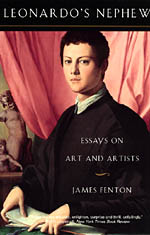 Leonardo's Nephew: Essays on Art and Artists
James Fenton
University of Chicago Press, 2000 James Fenton, one of England's most gifted poets, has in recent years been looking closely at works of art and writing incisively and inventively about them and their creators. This collection of fifteen writings discusses a wide range of painting and sculpture, from the mummy portraits of ancient Egypt to the works of Robert Rauschenberg and Jasper Johns.
"Ingenious. . . . Intrigued by emerging and unstable reputations, [Fenton] introduces us to Leonardo da Vinci's half-brother's son Pierino: a precocious sculptor celebrated by Vasari but virtually forgotten since."—Publishers Weekly
"Not surprisingly, Fenton displays throughout the passionate attentiveness of a scholar, the enthusiasm of an amateur, and the urbane cleverness of an English journalist."—Washington Post Book World
"[Fenton] is not, like Baudelaire, a poet moonlighting as art critic; he is something else again—a poetic art historian." —Karen Wright, Observer
"These essays educate, enlighten, surprise and thrill, unfailingly."—Robin Lippincott, New York Times Book Review
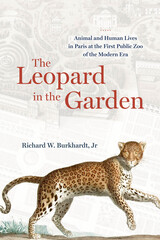 The Leopard in the Garden: Animal and Human Lives in Paris at the First Public Zoo of the Modern Era
Richard W. Burkhardt, Jr.
University of Chicago Press An authoritative history of the first metropolitan zoo explores how visions for the menagerie collided with the interests of humans and animals alike.
The Paris menagerie at the Paris Museum of Natural History has a special significance in the history of zoos. Founded in 1793–1794 at the height of the French Revolution, it was the model for the other great zoos of the nineteenth century that followed, beginning with London in 1827, Amsterdam in 1838, and Berlin in 1844.
Richard W. Burkhardt Jr. has written the definitive history of the Paris zoo and its early inhabitants, human and nonhuman. The book features narrative or thematic chapters interwoven with chapters focused on particular animals. Combining current scholarship with fresh discoveries gleaned from his immersion in the Paris Zoo’s extensive archive, Burkhardt shares historical treasures that illuminate not only the workings of the menagerie but also various dimensions of the golden age of French zoology (the years of Jean-Baptiste Lamarck, Geoffroy Saint-Hilaire, and Georges Cuvier). His history reconstructs the diverse sources of specimens, the growth of the collection over time, the efforts to make the menagerie scientifically significant, contemporary attitudes toward animals, and the lives of the animals themselves in colonial and diplomatic contexts.
 Leopards in the Temple: The Transformation of American Fiction, 1945-1970
Morris Dickstein
Harvard University Press, 2002 The twenty-five years after the Second World War were a lively and fertile period for the American novel and an era of momentous transformation in American society. Taking his title from the Kafka parable about the leopards who kept racing into the courtyard of the temple, disrupting the sacrifice, until they were made part of the ritual, Morris Dickstein shows how a daring band of outsiders reshaped the American novel and went on to dominate American fiction for the rest of the century.
In fluid prose, offering a social as well as a literary history, Dickstein provides a wide-ranging and frank reassessment of more than twenty key figures—including Jewish writers like Norman Mailer, Saul Bellow, and Philip Roth; African-Americans such as Ralph Ellison and James Baldwin; colorful emigrés like Vladimir Nabokov; and avatars of a new youth culture, including J. D. Salinger and Jack Kerouac.
Disputing the received wisdom about the culture of the Cold War, Dickstein shows why artists turned inward after the war and demonstrates how the writing of the 1960s emerged from the cultural ferment of the preceding decades, including road novels, avant-garde painting, bebop, film, psychoanalysis, and social changes that continue to affect us today.
Leopold and Loeb: THE CRIME OF THE CENTURY
Hal Higdon
University of Illinois Press, 1975 Among the criminal celebrities of Prohibition-era Chicago, not even Al Capone was more notorious than two well-educated and highly intelligent Jewish boys from wealthy South Side families. In a meticulously planned murder scheme disguised as a kidnapping, Nathan Leopold and Richard Loeb chose fourteen-year-old Bobby Franks at random as their victim, abandoning his crumpled body in a culvert before his parents had a chance to respond to the ransom demand. Revealing secret testimony and raising questions that have gone unanswered for decades, Hal Higdon separates fact from myth as he unravels the crime, the investigation, and the trial, in which Leopold and Loeb were defended by the era's most famous attorney, Clarence Darrow. Higdon's razor sharp account of their chilling act, their celebrity, and their ultimate emergence as folk heroes resonates unnervingly in our own violent time.
Leopold and Loeb: The Crime of the Century
Hal Higdon
University of Illinois Press, 2024 The razor-sharp account of a notorious murder The 1924 murder of fourteen-year-old Bobby Franks by Nathan Leopold and Richard Loeb shocked the nation. One hundred years later, the killing and its aftermath still reverberate through popular culture and the history of American crime. Hal Higdon’s true crime classic offers an unprecedented examination of the case. Higdon details Leopold and Loeb’s journey from privilege and promise to the planning and execution of their monstrous vision of the perfect crime. Drawing on secret testimony, Higdon follows the police investigation through the pair’s confessions of guilt and recreates the sensational hearing where Clarence Darrow, the nation’s most famous attorney, saved the pair from the death penalty. In-depth and definitive, Leopold and Loeb tells the dramatic story of a notorious crime and its long afterlife in the American imagination.
Leprosarium: Poems
Lise Goett
Tupelo Press, 2018 When the manuscript that became Lise Goett’s new book Leprosarium was chosen for the Winner Memorial Award of the Poetry Society of America, judge Toi Derricotte’s citation said, “This is dangerous art, as serious as a heart attack, unsparing mostly of the poet herself, and as intensely rewarding as it is unsettling.” Goett’s poetry, infused with a bountiful vocabulary, is rife with extravagantly dramatic forms that take in the sweep of western art and religion via relationships between those with power and those who’ve suffered their commands.
Lermontov's "A Hero of Our Time": A Critical Companion
Lewis Bagby
Northwestern University Press, 2001 Praised as the first Russian novel of psychological realism and as a critique of the repressive era in which Mikhail Lermontov lived, A Hero of Our Time brought to life the political and social ideas that at that time could only be expressed indirectly. This latest volume in the acclaimed Northwestern/AATSEEL Critical Companions to Russian Literature series presents diverse perspectives of leading Slavic literary theorists and specialists, ethnologists, formalist critics, and Western humanists. Lending additional breadth and depth are conservative and radical reviews of the novel written at the time of its publication, plus two new essays, one on ethnic identity and the other on women's issues in the novel.
Lermontov’s "A Hero of Our Time": A Critical Companion
Lewis Bagby
Northwestern University Press Praised as the first Russian novel of psychological realism and as a critique of the repressive era in which Mikhail Lermontov lived, A Hero of Our Time brought to life the political and social ideas that at that time could only be expressed indirectly. This latest volume in the acclaimed Northwestern/AATSEEL Critical Companions to Russian Literature series presents diverse perspectives of leading Slavic literary theorists and specialists, ethnologists, formalist critics, and Western humanists. Lending additional breadth and depth are conservative and radical reviews of the novel written at the time of its publication, plus two new essays, one on ethnic identity and the other on women's issues in the novel.
|
|

